Life Guides
Olive Garden Coupons
Italian Food Discounts and Coupon Codes
Olive Garden Coupons gives you discounts on fine Italian entrees at one of America’s favorite Italian restaurant chains.
You can find sales items, current promotions, and one-time discounts on your favorite meals at the Olive Garden in a number of formats on the Internet.
The various official Olive Garden websites offer bargains, while restaurant discount blogs and sites feature books of coupons.
Finally, you can navigate to one of many coupons websites, where discount shoppers post coupons, coupon code, and printable sales information for other shoppers.
Free Olive Garden Coupons
To get the latest Olive Garden Coupons, click on the newsletter sign-up link I just provided. On this page, you’ll be able to sign up for an official electronic newsletter by Olive Garden informing you when promotions, seasonal discounts, and special coupons are ongoing. Olive Garden has new promotions several times a year and this is the quickest and best way to find out about them–from the official Olive Garden website.
Another way to follow Olive Gardens discount selection is to connect with the Olive Garden Facebook page. This is the official Facebook page of The Olive Garden, so it’s going to have the latest coupon codes and promos. For instance, the current promotion is the Never Ending Pasta Bowl, which offers 7 different pastas and 6 separate sauces for 42 different delicious Italian food combinations. The Never Ending Pasta Bowl deal is on sale for $8.95 right now.
Both of these links provides you news of official Olive Garden coupon announcements. The first is for people who don’t want to have to actively search (or remember to search) on social networking sites, while the second is for people who love socially networking, but who don’t want an endless stream of promotional emails sent to them.
2011 – 2012 Olive Garden Coupons
The Olive Garden coupons page at Retail Me Not features a number of deals for the latter stages of 2011, with some continuing on into early 2012. Let me warn you that a few of the red-letter items listed on this page expired in mid-to-late August, so pay special attention to the expiration date on this particular coupons page.
The red means they’re deals you probably don’t want to use anyway, since they haven’t worked enough times that the RetailMeNot lists them as potentially troublesome or not worth your time. I suspect the large number of red coupon items is probably because people didn’t check when the coupon expires, because Retail Me Not usually does a better job than that of getting rid of expired coupons.
But let’s talk about the Olive Garden coupons still in effect. These include $2 off when you buy two paninis, a favorite of mine. This bargain comes with unlimited soup, salad, and breadsticks. The success rate on this coupon hovers around 50% to 54%.
You’ll find a 61% success rate on a $4 off any two dinner entrees. I’ve seen one place where this promotion ended in June, but I’ve seen it listed under “or later”, so check closely to see when the item expires. Also note that you’ll need to “Like” this coupon on Facebook to print off this item. You can go to the Olive Garden Facebook page to learn.
Printable Olive Garden Coupons
If you’re searching for printable Olive Garden coupons or coupons for any restaurant chain, you can go to the Restaurant Coupon Finder website to learn about the latest deals. While this blog is more niche than many of the websites I link to, if you’re looking for eating discounts, this is the perfect niche for you.
Options include a 30% off Olive Garden gift card for $3, book of 40 Olive Garden coupons for 2 entrees, a smaller booklet of 6 coupons, or a collection of $2 and $4 coupons for both lunch and dinner arrangements.
About Olive Garden
Olive Garden opened in 1982 in Orlando, Florida as a property of General Mills. By 1989, 145 Olive Garden restaurants had been opened across the United States. General Mills spun-off its restaurants into its own company in 1995, as Darden Restaurants. These days, you’ll find approximately 790 Olive Garden restaurants across the nation. The corporate headquarters are in Orange County, Florida.
While the critics have not always been kind to Olive Garden, the Italian-American food chain has been wildly popular with the public. The company advertises that it’s people learn to cook Olive Garden foods at an institute in Tuscany, Italy, but managers are only sent to Tuscany once a year for a bit of instructions. Still, Olive Garden is one of the most popular Italian food chains in America.
Cheaper Olive Garden Eating
Eating at the Olive Garden doesn’t have to cost as much as you think it does. Like most big food chains, the Olive Garden drives promotions by offering discounts, and their newsletter and Facebook pages make it easy to follow their promotions without getting bombarded with coupon ads. So do your homework, get hooked up with the right information sources, and be armed with coupons every timne you walk in your local Olive Garden.
Cascade Coupons
Proctor and Gamble Coupon Discounts
Cascade coupons help you save money on purchases of one of the most successful dish washing detergent brands in the United States.
Cascade is marketed by the Proctor & Gamble corporation, which has been selling soaps, detergents, and cleaning supplies for people and homes since 1843. These days, P&G sells over $82 billion in household products every year. Cascade is one of the premier brand lines in the Proctor and Gamble inventory.
2011 – 2012 Cascade Coupons
Let’s begin with a $10.02 plus free shipping coupon for a 60-pack of Cascade Actionpacs. Between the shipping discount and $3.98 off in the purchase, you’ll get over $6 in savings on this item. You can also get $3.75 plus free shipping for a 16-ounce Cascade Rinse Aid bottle.
These are the latest in the late-2011 and 2012 coupon items, though I found it hard to find too many good Cascade promotions (or even any) on many of the standard coupon websites. Luckily, the Proctor & Gamble website is first-rate for supplying the kind of current coupon item, printable coupon codes, and even free coupons customers will like.
Cascade Special Offers
Go to the Cascade Special Offers page to learn about Cascade Detergent’s latest offers from the official web-page. Most of the time, you’ll be able to find Cascade detergent sales of one sort or another. For example, you can find three different deals at the moments. Most coupons tell you that only one coupon is valid at a time, but this lets you activate the coupon which is best for your detergent needs. Here’s the three coupons Proctor & Gamble are currently offering.
The first is $0.50 off any Cascade Action Packs (also spelled “ActionPacs“, which drives me crazy). The second is $0.50 any one Cascade Complete All-in-1 Actionspacs. The third is $0.50 any Cascade Rinse Aid product. But while those are the free printable coupons you can find on the site at the moment, there’s one other resource for cheap sales items from Proctor and Gamble you should never forget about.
Proctor & Gamble Everyday Solutions
The Proctor and Gamble Everyday Solutions lets you get bargains on many P&G products–not just Cascade. Let’s face it: when you want to buy detergent and other cleansing products, you probably want more than just liquid or powder dish washing detergent. You probably want products to clean your whole kitchen, along with the washing your clothes and scrubbing the bathroom. Shampoo, conditioners, hand soaps, and body soaps are other products Proctor and Gamble has you might want.
So when you’re considering buying these products anyway, Proctor and Gamble puts together sales packages to encourage product and brand loyalty. The more items you buy, the more you save on those items. What I’m specifically talking about is the P&G Everyday Solutions Coupon Book. This gives you over $110 in coupon savings in one coupon booklet.
Free Cascade Coupons
Proctor & Gamble and CouponMom.com’s Stephanie Nelson combine to promote this program, which lets you order samples online, collect coupons, get purchase tips from Proctor & Gamble’s helpful monthly newsletter, and even shows you how to download coupons to your shopper card (or tells you how to get that shopper card).
The site also reminds shoppers to look inside the boxes they purchase to collect coupons, because these are often the best bargains you’re going to find. You’ll find discounts on brand names like Cascade, Downy, Dawn, Charmin, Crest, Bounty, and Bounce. In all, the savings come to $30 for every set of items you buy. Below are the various promotions currently.
- $1 Cascade, Dawn Coupons
- $1 Always, Bounce Coupons
- $1 Charmin Coupons
- $1 Downy, Bounty Coupons
- $5 Align Coupons
- $7 Crest Whitestrips Coupons
These are free savings you get from the official website of Cascade and other P&G products, so you’ll be able to get coupons and coupon codes that should work 100% of the time. Don’t forget to sign up for the P&G Brand Sample to get the latest samples mailed directly to your home. These are not an insignificant amount of cleaning agents and they are absolutely free and with no obligation. Proctor & Gamble sends them out to promote new brands and to publicize sales.
Printable Cascade Coupons
If you want discounts on household cleaning items, you can get coupon codes for GreatCleaners.com Dishwashing Detergent at RetailMeNot. You can get 25% any purchase with a 94% success rate, a 15% any order at an 87% success rate, and a free shipping coupon at an 84% success rate. These generally include any type of household cleaning supplies, so you’ll be able to buy Cascade detergent online cheaper than you could at the local grocery store. Remember that not every coupon is going to say Cascade on it, but this kind of bargain shopping saves you just as much money or more. The average savings at Great Cleaners on these three bargains is $6.
Bed Bath and Beyond Coupons
BBBY Discounts and Promotional Codes
Bed Bath and Beyond Coupons lets you bargain-shop at the domestic merchandise store with the best deals and cheapest prices.
The women in my life love Bed Bath and Beyond, because it’s stocked with domestic items that make their life easier and more pleasant.
In fact, the store is so female-oriented that it’s been parodied in male-only programs like Old School, The Other Guys, and the Adam Sandler vehicle, Click.
The defunct Will & Grace tv show featured the house item chain more than once, while the Simpsons and Family Guy have introduced gags involving Bed Bath and Beyond. Ladies have to know that if so many guy-shows find something funny about Bed Bath and Beyond, then they must be doing something right. Women love this place, so let’s help them love it a little more and find them some good bargains at Bed Bath and Beyond.
Bed Bath and Beyond Info
Bed Bath and Beyond has sold domestic merchandise to home owners and housewives since 1971. These days, BBBY (as it’s called on the Nasdaq) has almost a thousand locations in the United States, Canada, and Puerto Rico.
The corporate headquarters are located in Union, New Jersey (northern New Jersey). The company is part of the S&P 500, The Fortune 500, and the Forbes 2000. It also is a NASDAQ-100 component, with revenues of $7.8 billion in 2010. In other words, BBBY sells a lot of home furnishings, so let’s see which home furnishings they sell at the cheapest prices.
Free Bed Bath and Beyond Coupons
People wanting to go to the Bed, Bath and Beyond website to print off the latest coupons and coupon codes might be disappointed. The Bed Bath and Beyond company only sends coupons to customers through snail mail (the U.S. Postal Service), so you won’t find to make electronic transfers of good bargains and discounts.
Go to Bed Bath and Beyond coupons at Retail Me Not to print off the latest discount information. Current promotions include clearance items, which have a 56% success rate. You’ll find a large number of other sale items and promotions going on right now. Below are just some of the printable coupons and other BB&B deals being offered at Retail Me Not.
Printable Bed Bath and Beyond Coupons
- Breville Juice Found Plus for $149
- Bridal Registry Signup (for bargains)
- Bed Bath and Beyond Kitchen Clearance
- 50% off Select Fine China
- Bed Bath and Beyond Picnic Items
- Bed Bath and Beyond Dining Clearance
- Retro Wooden Accent and Media Table for $30
- Free Shipping at Bed Bath and Beyond
- Bed Bath and Beyond Barbecue Products
- Weight Watchers Cookware
- Bed Bath and Beyond Collegiate Gear
- Wall Art Clearance
- Bed Bath and Beyond Baby Items
- Michael diCesare Products (free shipping)
2011 – 2012 Bed Bath and Beyond Coupons
Crazy Uncle has completely different coupon deals than Retail Me Not, which is what I like to see when coupon shopping. Many times you’ll find the same coupons posted over and over on different websites, which can be frustrating to the online bargain shopper. Not so in this case.
Among the best Bed Bath and Beyond items being offered at Cheap Uncle right now are the pillow selections. These include a synthetic down comforter for as low as $87, a king-sized down gel fiber side sleeper pillow selling for as low as $38, a full queen down gel fiber comforter selling for as low as $108, and a king-sized down gel fiber comforter selling for as low as $135. All you have to do is add in your zip code information to see what purchasing one of these products online would cost, after taxes and shipping costs are added.
Bed Bath and Beyond at Coupon Cabin
Coupon Cabin has many of the same coupons listed, but they do have a few optional printable coupons. These include a Window Clearance sell (up to 40% off), 50% off the bedding clearance (mentioned elsewhere), an oddball free shipping on coffee items (I’m assuming unground coffee), 50% off dining clearance items, 50% off the online clearance center, 60% off the kitchen clearance, and 60% off the bath clearance.
Bed Bath and Beyond Clearance
An important resource on the Internet for bargain shoppers for Bed Bath and Beyond products is the Bed Bath and Beyond Clearance page. You can go online to this official Bed Bath and Beyond site and learn exactly what’s on sale at present and what’s going on sale in the near future. Shoppers who are new to the retail chain can get an idea of what they can buy at the store. Below is the list of clearance items by category.
- Bed Bath and Beyond Clearance Bedding
- BB and B Clearance Bath
- BB&B Clearance Dining
- Bed Bath and Beyond Clearance Kitchen
- BB-and-B Clearance Window
- BB&B Clearance Lifestyles
- Bed Bath and Beyond Clearance Seasonal
- Clearance Gifts
Bed Bath and Beyond Coupons
From just this brief survey, you should be able to get an idea of all the many resources online for printable coupons and clearance sales at your favorite domestic merchandise store.
Cheerios Coupons
Free Kelloggs Cereal Discounts
Cheerios coupons should be a part of your regular grocery bill, if you and your family eat any of the brands of Cheerios at the store.
These days, you don’t have to wait for fliers in the mail or search through the Sunday newspaper’s coupon items. You can find printable Cheerios coupons on one of dozens of sales and coupon codes websites.
I’ve found a few promotional coupon web addresses that can start the search, but I encourage you to look online for more. Bookmark the good sources of cereal sales and either post to the websites I link to or post the information on your own blog. In this way, you’ll help all the other discount shoppers looking for good deals on the Internet.
Printable Cheerios Coupons
When you’re searching for printable Cheerios coupons, you’ll want to search on multiple sites. Shopping online is no different than brick-and-mortar shopping out on the town–you want to see what all the different stores and vendors have to offer. For instance, you can go to Coupon Network to look for coupons, but at the moment, the only coupon is the $0.50 off a regular box of Cheerios. While that’s savings, you’ll probably want to look at multiple options, so move on to the next coupon website.
Go to “Money Saving Mom” and you’ll find a similar 50-cent coupon to the one found at Coupon Network. You’ll find many repetitive offers on the Internet, but you should view that as a positive sign, because it means these are valid offers with widespread appeal. Many sites have a rating system for what percentage of the time a coupon is useful.
Another way to find Cheerios coupons to print is to visit a printable cereal coupons page. This has the advantage of information about many different brands you might normally miss because you’ve narrowed you search fields only to Cheerios. In this case, you get a $1 off Cheerios if you buy 2 boxes at a time. But you also learn about a free box of 12.3 ounce Special K or 13-ounce Special K Multigrain Oats & Cereal. That same page also links to this page of grocery coupons, which contains a $1.10 coupon for Honey Nut Cheerios.
Kellogg’s Coupons
One option shoppers can’t overlook is the Kellogg’s web address, because the company which manufactures and markets Cheerios is going to have its own ready supply of promotions. You can find printable Kellogg’s cereal coupons at the link given. One headache associated with printing off the Kelloggs site is that you’ll need to install the coupon printing software. If you have a slow loading speed, you might want to avoid this, but otherwise it shouldn’t take too long. All you have to do is click “Print Coupons” and follow the instructions.
Free Cheerios Coupons – Biggest Loser Club
Most Cheerios coupons and coupon codes you find online are going to be free of charge, though you can find a few good bargains contingent on your buying a certain amount of the product. You can also find promotional discounts like the one below.
While it’s not a coupon for cheaper Cheerios cereal, I did want to point out the cross-promotion between Multi-Grain Cheerios and NBC’s The Biggest Loser television show, which is called the Biggest Loser’s Club. You probably know The Biggest Loser is the tv program where overweight contestants compete to see who can lose the most weight (or percentage of their weight), while being instructed by no-nonsense Jillian Michaels.
The Losers Club wants to help Cheerios eaters eat healthy and lose weight by showing them the benefits of Multigrain Cheerios and other cereal products. The Kellogg’s offer for the Biggest Loser’s Club is three free books which gives you insight, instructions, and inspiration for losing weight. You’ll even read about recipes involving Cheerios from these free publications.
2011 – 2012 Cheerios Coupons
Cheap Uncle has Cheerios coupons I haven’t found elsewhere, including a 6-pack of Honey Nut Cheerios 1.8 ounce cups for as low as $9. Another package bargain is a 1.83 ounce portable regular Cheerios pack for as low as $9 at Staples, though it has a different coupon code than the aforementioned Honey Nut Cheerios coupon. Another similar sale item is the 6-box of 1.3 ounce Cheerios for as low as $12. All of these are similar, but it seems regular Cheerios is a little more expensive.
Perhaps the best deal on Cheerios promotions you’ll find at Cheap Uncle is the pack of 12 Cheerios 14-ounce packages for as low as $13. That’s a decent size box of breakfast cereal for less than a dollar apiece, if you buy them in bulk quantities. You’ll need to eat Cheerios quickly at that household. A pack of 96 0.88-ounce containers of Fruity Cheerios is selling for as low as $27. These are small pouches of cereal, but if you have kids who don’t eat much at any given sitting, this is an ideal breakfast item to serve. Doctors say children eat more when you don’t load their plate or bowl down with a vastly disproportional amount of food.
Outback Steakhouse Coupons
Online Outback Steak House Discount
Outback Steakhouse Coupons for the large Australian-themed surf and turf restaurant chain can be found in many place across the Internet.
Not only does the Outback Steakhouse parent corporation offer many bargains and promotions, top coupon websites like Coupon Cabin, Coupon Network, Crazy Uncle, and Retail Me Not offer their own Outback Steakhouse coupon pages. But let’s start at the official website for the Bloomin’ Onion and Outbacker.
Outback Steakhouse Rewards
Go to the Outback Steakhouse Rewards page to find what the Aussies are offering customers themselves. Frequent customers can sign up for a special rewards program based on their visits. If you and your family spend a lot of time at the local Outback Steakhouse, you have to take advantage of these offers–or else you’re throwing money away. For companies planning on a meeting at the Outback Steakhouse, call 866-551-1666 to learn about bulk rate deals on bills over $1,000.
Free Outback Steakhouse Coupons
Current rewards options include $10-off a 2-meal package for 4,000 reward points. Another reward deal is a free Aussie-Tizer with 2,500 reward points, while you can also get a free desert items for those same 2,500 points. Joining the program and attaining rewards levels lets you enter a “Dinner for Two” sweepstakes, a “Dinner and a Movie” sweepstakes, and a chance to win Corona Beer Package. If you attain 36,000 reward points, you can even win the “Kick Back with the Girls” or “Kick Back with the Boys” dinner packages, where you can three friends get a free meal of appetizers, menu items, and desserts worth $90 (two $45 coupons).
Outback Steajhouse Coupon Code
One of the common ways to use promotions and sale items is the coupon code. This is a simple sequence of letters and numbers that looks a little like an online log-in or password. You can either print a promo code off the site or write down the code and give to the host when you enter a restaurant for specific deals. The Outback Steakhouse coupon page currently has a coupon code for a free desert item with the code sequence “AFTZ TKPH FHNW”. Call ahead to your local Outback Steakhouse to see if this code is valid at their location.
Also, you can use the “FLAG” code to get up to 80% on selected menu items. Ask which menu items are offered, but this is a way to cut a huge sum off the price of your next Outback Steakhouse visit. This more open-ended coupon code is nice, because you’ll have your choice of multiple food items. For free snow crab legs and a free dessert, use the code “6748-8800-0010-475-426”. When you eat snow crab legs at Joe’s Crab Shack, they put a bib on you, so remember to come prepared for a messy meal.
You’ll notice the coupon codes and promotional codes have excellent bargains on offer. One reason this is possible is that the promo codes won’t be found in newspaper sales print and on many coupon websites. With fewer people using them, they can offer better deals.
Printable Outback Steakhouse Coupons
One of my favorite online coupon websites is Retail Me Not, because it offers both printable coupons and coupon codes, but it also includes feedback from customers who’ve tried to use these same deals. With little navigation or research, you get an idea how likely any particular coupon is going to work. I’ll give an example.
2011 – 2012 Outback Steakhouse Coupons
The top coupon code listed at present is “ascz ygpk slbs”, which is a coupon for a free desert. The percentage beside it says 25%, meaning this coupon has only worked 1 out of 4 times it’s been used. Because this isn’t a particularly good percentage, the number is highlighted in red to caution the bargain shopper. In fact, many of the promo codes posted right now, which include free Aussie-Tizers, free dessert items, and $10 off your next meal, have been flagged as unreliable. That means you could face some frustration trying to redeem coupons at Outback Steakhouse right now.
Another advantage of Retail Me Not is the codes are removed when they’re no longer available. This means you aren’t likely to be using out-of-date coupon codes.
Outback Steakhouse Coupon Books
You’ll occasionally find fund-raising organizations selling coupon books that contain Outback Steakhouse coupons in them, usually with a large number of other retail chain and food chain coupons added in. These usually are good bargains, because the companies involved on the list tend to offer special discounts to help the charity or childrens fund. When asked to buy one of these coupon booklets, ask for a list of participants in the program. If a good number of the retailers and restaurateurs on the list sound like places you would give your business, buy one of these booklets and help out a non-profit organization.
Occasionally, Outback Steakhouse might print out their own coupon books for customers. Because of the sheer number of coupon options, these tend to be well-priced for the discounts offered. Leaf through them to see what’s on-offer before making the decision to buy, but if it’s an official discount booklet, it’s probably a good deal.
Outback Steakhouse Background
Contrary to common belief, Outback Steakhouse is an American restaurant chain based in Tampa, Florida and is not an Australia food chain. Outback Steakhouse was started in Florida by several people, including Chris T. Sullivan, though it’s since been sold to the Osi Restaurant Partners (also of Tampa). Today, you’ll find 1,200 Outback Steakhouse eateries worldwide, including places like South Korean, China, Canada, Brazil and, of course, Australia. Outback Steakhouse is known for certain signature items, such as the Bloomin’ Onion, which is a giant fried and battered onion served with mayonnaise-horseradish sauce.
How to Make Your Own House For Your Dolls
 Find a Cutting Plan
Find a Cutting PlanHow to Make Sturdy Paper Airplanes in Study Hall
How to Make Sturdy Paper Airplanes in Study Hall
The ability to make good paper airplanes put you pretty high on the totem pole in junior high school. Making sturdy paper airplanes that could fly all the way across the room and do tricks made you the coolest kid in the room.
There are many varieties of paper airplane to choose from, but by far the simplest and sturdiest paper airplane is a design that paper airplane enthusiasts call “the Deltry.”
How to Fold the Deltry Paper Airplane

1. Start with a standard 8 1/2 by 11 inch sheet of paper. For a sturdier paper airplane, you could use cardstock, though your folds would require a little extra elbow grease and without a strong tailwind the airplane may have trouble getting lift. Crease your paper along the middle. You’re folding it in half lengthwise. This is what paper airplane experts call a valley fold. Now unfold the paper. Congratulations, you’ve just made a crease.
2. Fold the top two corners of the paper inward to the center crease line. You’re essentially making two right-angle triangles at the top of the paper that touch at the center crease line.
3. Fold your big top triangle (the two smaller triangles you just folded form one big triangle) over and down so that the point is toward the bottom of the paper.
4. Fold the point of the large triangle back up. The tip of the triangle should almost touch all the way to the top, but not quite to the top. You want to leave about half an inch space from the top of the paper. This space is to help the plane’s flaps lock under with a tight fit and keep the airplane held together when you’re finished folding it.
5. Fold and unfold two new top triangles so that their edges line up with the center line of the plane.
6. Now you should fold the two large right angle triangles down again, repeating your first steps.
7. Tuck the two lower triangles underneath so they lock in place.
8. Now its time to tuck all the triangles underneath the flaps so the whole plane holds together.
9. Launch the Deltry gently. This isn’t a fast paper airplane–it’s built for sturdiness. Don’t throw the Deltry, just release it gently with the nose pointed slightly downward.
Paper airplanes were once the domain of the immature kid at the back of study hall. These days, interest in origami and paper-folding has brought paper airplane construction back to the forefront.
Finding Quality Paper Route Jobs For 14 Year Olds
Finding Quality Paper Route Jobs For 14 Year Olds
When I was a kid having a paper route was a precursor to getting your first real job. My paper route started at age 13 and continued until I got my first part-time job at 16. My paper route money paid for my first car, which say unused in the driveway until I got my license. Good times, and a good job for a young kid just starting out.
Here’s a guide to finding quality paper route jobs for 14 year olds.
1. Contact Your Local Paper
 Many regional papers now contract their paper delivery routes out to small businesses or older individuals who deliver the papers to their customers. Contact your paper to find out how they deliver their papers and who to get in touch with to find a paper route job for your teenager.
Many regional papers now contract their paper delivery routes out to small businesses or older individuals who deliver the papers to their customers. Contact your paper to find out how they deliver their papers and who to get in touch with to find a paper route job for your teenager.
2. Talk To Your Teenager
In my case, I couldn’t wait to get my first paper route. The summer after my 8th grade year I spent early mornings bundling and throwing papers to the neighbors, napped all afternoon, then ran wild at night on my bicycle, fishing and carrying on until it was time for bed.
You may be looking for a paper route job for your 14 year old as a character building exercise, a way for him or her to make money, or even as punishment. Whatever the reason, you have to talk to them ahead of time and get them ready for their new job. Now’s the time to make sure they have decent clothes for the job interview, too, and to make sure their bike is in good working order.
3. Talk to the Paper Delivery Guy & Set Up an Interview
It’s unlikely that your kid will interview for the paper delivery job at the newspaper office. You’ll have to talk to the person in charge of paper delivery and set up an interview. Make sure you know what your kid is expected to wear for the interview and what time they need to show up.
4. Prepare Your Kid for the Interview
Talk to you son or daughter about the responsibilities that come with a paper route job. Make sure they know what to do if they’re sick or can’t make it to their route, and what they’ll be doing with the money they earn.
Finding a paper route for 14 year olds isn’t as hard as it used to be. Now that most papers are delivered by a private contractor, all you have to do is contact that person and set up an interview.
How to Become a Boxer
How to Become a Boxer
Maybe your biggest dream has always been to fight like your favorite professional boxer or perhaps you want another outlet for your competitive nature. Either way, becoming a boxer is thrilling, exciting and will test your limits beyond anything you have ever experienced before. Tie on those boxing gloves and get ready to work out every muscle in your body. Most of all, as you prepare to follow the workouts of the greats like Ali and Evander Holyfield, follow these steps to become a boxer in your own rite and have a great time challenging yourself in the process.
1. Think like a boxer. The first and most important step in becoming a boxer is thinking like one. Ali didn’t spend his afternoons on the couch and neither will you if you’re serious about the sport. Scout out your local boxing ring and spend whatever time you can there each day or week. Many times you can get connected with a coach who sees you boxing, and other times you can find one through other resources in your area. It’s important to find someone you can trust and will help you achieve your goals as a professional/amateur competitive fighter and encourage you along the way.
2. Participate in boxing events. Every boxing club or gym will give you access to boxing events, otherwise known as “smokers” or “white collar nights”. Although training typically takes six to nine months before your first fight, you can get in-the-know and prepare for one through these resources, by talking to other amateur boxers and learning about events from your coach.
3. Get licensed. Get familiar with USA Boxing. This is the governing body of amateur boxing in the United States and will determine when and how you can fight. You’ll want to make sure to get licensed (which is a prerequisite before participating in any amateur fight) which isn’t difficult but just takes filling out some paperwork and paying the filing fees.
4. Know your division. Depending on your age, this will determine what division you are fighting in. A regular amateur is for ages 18-34, Junior qualifies people ages 17 and under and the Master division is for ages 35 and up. It’s also important to know the weight requirements for your division so be sure to thoroughly read the qualifications before getting set to compete.
5. Win your first tournament. As you win that first local tournament, you will begin to move up the ranks and that’s when the fun really begins. You will begin to compete against other winners in your competition level, which will then continue on to the U.S. Amateur Championships.
If you’re just starting out, it may seem like you have quite a few “to-do” things on your list to tackle before you’ll be ready for your first fight. Although it can be tedious, you’ll find that fighting is an addictive sport and well worth the time and effort it took to get there.
Author Bio: Heather J. writes on behalf of BoxFitUK.com, your source for Rival Boxing gear!
How to Pay for College
Ways to Pay for College
Mounting student debt and rising college tuition prices have both been major subjects in the media recently, which has raised questions as to whether or not higher education is really worth the cost. Despite these rising tuition rates and the buildup of debt, most experts still agree that the majority of Americans would benefit from taking advantage of higher education opportunities. However, this still leaves students with the difficult question of how to pay for college despite a dwindling job market and loan requirements. Fortunately, there are still some accessible methods students can take advantage of to help pay for college and invest in a better future.
Taking Advantage of Scholarship Opportunities
It’s always best for students to consider scholarship opportunities before loans, since scholarships don’t require repayment and certainly don’t carry with them the burden of interest rates. The following list includes good websites to utilize when searching for a good scholarship:
These websites are good for connecting you with several different scholarship opportunities that range anywhere from academic awards to minority scholarship awards. Sports scholarships are also great for going to school while performing in the sports team of your choice. Although these scholarships can certainly be very helpful to help pay for college, one of the most helpful scholarship programs can be found through your current college and through your state. Many states have special programs for residents who have performed especially well in high school either academically, in sports, or in some specific subject.
If you continue to perform well at the college you attend, your school is also likely to offer rewards in the form of scholarships. Something important to remember when it comes to scholarships is that you can pretty much find one for just about anything. From being left handed to wearing a duct tape dress to prom, there are scholarships available for wacky subjects that seem completely unrelated to education. If you struggle with academics or are intimidated by the competition, it might be best to look into these alternative kinds of scholarship programs.
Joining the Military
When you make the noble decision to serve your country in the military, you are rewarded by several federal programs that allow you to attend an institute of higher education for free, receive benefits on housing, healthcare, and benefits for your dependents. If the cost of college seems overwhelming to you, joining the military may be a great decision. Not only does joining the military provide you with a paid education, it also gives you invaluable experience learning the various skills necessary for each job and experiencing new countries and cultures. These life lessons not only help you become more well-rounded as a person, but can also make you more valuable in the job market because you have more skills to offer.
Applying for Grants and Loans
Federal grants are similar to scholarships in that you don’t have to pay the money back; however, grants are usually preferred because they don’t require much (if any) work from the recipient. Students who come from low-income backgrounds usually qualify for the Federal Pell Grant, which can add up to $5,000 in aid per year for qualifying students. Although grants are ideal, many students don’t qualify for them and have to take out loans to pay for college. The following loans are available for students who need assistance paying for college:
- Federal Stafford Loans: Stafford loans come in two different forms: subsidized (no interest rate) and unsubsidized (grows with interest over time). It is extremely important that students know the difference between the two. When taken together, these loans can account for up to $10,000 per year.
- Sallie Mae Student Loans: Sallie Mae is one of the most popular loan companies that offers loans as well as scholarships and additional funding options for college tuition. The agency offers several plans that can provide more than enough money to pay for college; however, these plans require a co-signer with good credit in order to be approved.
- Bank Loans: You can acquire a bank loan to pay for essentially any expense, but most banks offer special programs for individuals who are interested in taking out student loans. Similar to Sallie Mae, these programs usually require a co-signer, good credit, and various other standards before lending.
Getting a Job
Rising tuition means that very few students are lucky enough to juggle classwork and homework without maintaining a part or full time job on top of that. Unfortunately, having a job is absolutely essential to making the cost of college easier on the student. In extreme cases, some students are forced into the position of taking on a full time job during the day while attending night classes just to be able to make ends meet. Fortunately, there are alternative options for paying for college besides employing a sugar daddy to help out.
- Federal Work-Study: Federal Work-Study programs are extremely helpful in helping students on campus find jobs that not only help them pay for school, but also work around their school schedules. From working in the campus library to doing odd jobs in the campus security department, Work-Study is a great way to make money while maintaining enough time for school.
- Food Industry: In most big college towns, it’s relatively easy to acquire a job in the food industry, either serving, hostessing, or cashiering at a fast food place. At the server end of the spectrum, students can be making up to $400-500 per week, which can help cover living expenses while still having some leftover to chip away at tuition bills.
- Independent Business: Becoming an entrepreneur can be easier than you think, and may even be more lucrative that the average serving job. From babysitting to dog walking to selling baked goods, having your own business is a good way to keep to your own school schedule while still making money on the side to help pay for college.
How to Get Cheap Car Insurance
How to Get Cheap Car Insurance
There are hundreds of millions of drivers with car insurance in the United States. Many drivers receive their auto insurance bill and wonder why they are paying so much. There are a number of steps that drivers can take to ensure that their auto insurance is as affordable as possible.
Raising Deductibles
Drivers should often consider raising deductibles on their auto insurance. Many drivers have low deductibles that make it easy to use insurance. Drivers who rarely place a claim with their auto insurance company should consider raising their deductible. A customer may be able to save up to 40% by changing the deductible on their policy from $250 to $1000.
Drop Additional Coverage
Many drivers who have older vehicles may not be aware of expensive options they have on their auto insurance. A customer who has an older vehicle but still maintains collision/comprehensive coverage on it may pay hundreds of dollars a year more for their coverage. Older cars may not receive a full payout for these claims either. Customers should strongly consider drop collision/comprehensive policies or raising the deductibles on these policies.
Avoid Extra Medical Coverage
Drivers who already have health coverage through work should avoid purchasing health coverage from their auto insurance company. Drivers will receive coverage from their primary health care policy. Drivers only need to maintain the statement minimum personal injury protection liability insurance. Anything extra will only increase the cost of the policy as well as over protect the driver.
Purchase a Vehicle That is Cost Efficient
Drivers who want to save money every month should purchase a vehicle that is cost efficient. An insurance customer who purchases a vehicle that is stolen often will be charged a higher premium. Any driver who decides that they want to have an expensive sports car because it looks cool will have a higher premium. Vehicles that have costly technology or expensive repairs costs are likely to have higher insurance premiums as well. Drivers can save a large amount of money by purchasing a vehicle that is unlikely to be stolen and has a good reputation for repair.
Drive Less
Drivers who drive less are able to save money on their policy. A driver who drives only 5,000 miles a year in their vehicle will pay a lower premium than drivers who drive 12,000 miles a year. Drivers also will have a lower likelihood of being involved in an automobile accident. Drivers who carpool may also receive a discount on their auto insurance. Customers should contact their auto insurance company to inquire about a potential discount.
Notify Your Insurance Company about Safety Features
Many insurance companies are automatically able to see which safety features are installed in your vehicle. However, some insurance companies do not automatically apply these discounts. Many auto insurance companies allow drivers to receive a discount for having air bags, ABS brakes or an alarm system. Insurance companies may even bundle these discounts together to give the customer even further savings.
Add Teens to Parents Policy
Many parents may not want to have their teenager on their auto insurance policy. However, teenagers who are on their own policy typically have to pay over $1,000 more a year for similar coverage. Teenagers who have good grades as well as pass a drivers education class can qualify for discounts. College students may also qualify for discounts depending upon the auto insurance company.
Carry All of Your Insurance With One Company
Many companies provide a loyalty discount for having multiple policies with the same company. This means that a customer who has a homeowners’, life insurance and auto insurance policy with the same company could save hundreds or thousands of dollars a year. Best of all, many insurance companies are willing to give you discounts on your other policies as well. Price shop other insurance companies and notify your current insurance company that you have found a better price elsewhere. You may be able to save money simply by asking for a discount.
Ask for a Discount
Customers should always ask for a discount. Many companies may deny a discount or only apply a small discount to your account. However, customers may be eligible to save hundreds or thousands of dollars a year. Often a customer has to make a simple phone call that takes less then ten minutes in order to save a large amount of money.
Avoid Coverage for Rental Car Reimbursement or Towing
Drivers should strongly reconsider adding rental car reimbursement or towing coverage to their policy. Many drivers may already have a credit card that covers them in the event of their vehicle breaking down. Check with your credit card carrier for more information to determine whether you truly need this coverage.
Tips to Remember
Drivers should remember to check with their insurance agency about all of the tips that are mentioned above. Many drivers are able to save hundreds of dollars a year on their auto insurance premiums. Cost savings can add up quickly when drivers raise deductibles, drop coverage and simply ask for a discount. Customers should always remember that the insurance market is very competitive and there are many car insurance companies who are willing to give you a quote for cheaper insurance rates.
How to Buy Small Business Insurance
How to Buy Small Business Insurance
Owning and operating a small business is hard work. Some problem is always cropping up. Making sure the business runs smoothly, efficiently, and profitably is totally up to you. There is no one to fall back on, no one else to blame. You make the decisions, and either suffer the consequences or reap the rewards. Carrying the right amount, and the correct type, of insurance is absolutely necessary–it’s a backup plan that won’t fail you. Following are a few tips on how to properly insure your small business.
Necessary Coverage
Depending on the size of your company, certain kinds of insurance will be necessary–you have to carry them. They consist of Medicare, workman’s compensation, Social Security, and unemployment insurance. A few states also require a business to provide disability insurance, which will partially cover an employee’s injuries if they are hurt on the job. For companies that use vehicles to do business, special business auto insurance is required. If your small business provides a professional service, such as a doctor or dentist, you must carry malpractice insurance. If your business is a sole proprietorship you won’t need to be concerned about workman’s comp or unemployment insurance, but there are other types of insurance you may need to consider carrying in order to be fully protected.
Liability Insurance
Liability insurance covers employees that are injured on the job and are unable to work. The insurance coverage will provide a worker with an income while they’re laid up and partially cover their associated medical expenses. It will also help with the rehabilitation process, should it be required. In a similar vein, the same sort of coverage will apply if someone becomes incapacitated due to a job related sickness or disease. You can get business liability insurance through a private or state run provider.
Criminal Liability Insurance
In order to protect your business from an intentional act of sabotage by a disgruntled employee you may want to consider carrying criminal liability insurance. It’s not out of the realm of possibility for someone to become disenchanted with you or your business due to a perceived wrong and take their frustrations out on something you own. This type of insurance will make sure you’re covered for a willful destructive act.
Business Disability Insurance
Carrying added coverage, like business disability insurance, while not mandatory, is a good idea in order to protect you and your business. This type of insurance will provide coverage for you in the event you are unable to work for an extended period of time. Without it, your business probably wouldn’t survive–especially if you’re a sole proprietor. In that case you would be out of business–you would go belly up in no time. However, if you have adequate business disability insurance you will have protection, and the business should continue to prosper.
Business Owner’s Insurance
Business owner’s insurance is a type of coverage that will provide protection in the event you are named in a lawsuit for one reason or another. It will provide separation between your business and personal assets and can also help pay for attorney’s fees. It all depends on the amount of coverage you sign up for.
Professional Liability Insurance
If your business provides professional services, such as the services provided by a doctor or dentist, or many other areas of the medical community, you will need professional liability insurance. Frequently called errors and omissions insurance, or malpractice insurance, professional liability insurance will protect you against charges of negligence or any mistakes you may inadvertently make.
Product Liability Insurance
Another type of insurance to consider is called product liability insurance, which will protect you in the event of a problem arising with a product you make. If a problem develops in the manufacture of that product, or in any area of your business in which you may be considered liable, product liability insurance can provide financial protection and allow you to solve the problem.
This guest post about how to buy small business insurance was written by Bailey Harris. Bailey writes for www.businessinsurance.org.
How to Make Your Own Hair Dye
How to Make Your Own Hair Dye
Over the years, the concept of hair dying has become increasingly popular. Whether you want a dramatic or subtle change, the store-bought options are endless. There is a problem with these store-bought hair dyes, though. They contain large amounts of chemicals, which you may not want on your head. Luckily you can create your own hair dye at home, using ingredients that are chemical-free and much less harsh. The ingredients that you need to create your own hair dye will depend largely on the shade you desire, and can possibly be found right in your own kitchen. Keep in mind the results will not be as substantial as with traditional hair dye, but you will feel good knowing no chemicals are being used.
How to Make Blonde Hair Dye
There are a few different natural hair dye options for blonde hair. One uses lemon juice and chamomile tea. All you have to do is mix 2 to 3 tablespoons of lemon juice with two cups of strongly-brewed chamomile tea. Make sure the two are blended well and apply to hair after shampooing. Ring out excess and cover hair with a clear shower cap if possible, and leave the mixture on for thirty minutes or so. To speed up the lightening process, sit out in the sun or under a blow-dryer on low to medium heat while you wait.
Another recipe for blonde hair dye uses six chamomile tea bags, 1/2 cup plain yogurt, and five drops of lavender essential oil. Bring two cups of water to a boil, then add the tea bags and steep for 15 to 20 minutes. Remove the tea bags and add the yogurt and essential oil to the tea mixture. Apply to hair as thoroughly as possible, avoiding the scalp if you can. Cover hair with a shower cap, and leave on your hair for 30 to 40 minutes. Again, sitting in the sun or under a hair dryer will speed up the lightening process. Be sure to rinse thoroughly when time is up.
If you choose to use these recipes, you should remember that they are best for hair that is already somewhat blonde. They will lighten dark blonde to light brown hair, but the process may have to be repeated several times until a noticeable result is achieved. If you use these recipes on darker hair, you may get coppery results.
How to Make Brunette Hair Dye
If you are looking to give your hair a shot of dark color, there are a couple ways to make it happen. The first recipe for brunette hair dye uses plain old black coffee or tea. Just brew a couple strong cups of either, or a mixture of both. Let the coffee or tea cool and then apply to clean hair. Ring out the excess and cover hair with a shower cap or plastic wrap. Leave on hair for 20 to 30 minutes, then rinse well. Your hair should have some rich brown tones when you are done. Repeat this method as often as you wish.
Hair can also get a brown boost from a recipe that uses walnut husks. All you have to do is boil 1 to 2 cups of crushed walnut husks in a saucepan with four cups of water. Bring the mixture to a rolling boil, then lower the heat and let it simmer for 30 to 35 minutes. Remove from the heat, and let the mixture steep and cool for an hour or so. Strain the walnut pieces out and use the liquid as your dye. Apply to your hair and let it sit for half an hour. Rinse well and follow with an apple cider vinegar rinse for shine.
How to Make Red Hair Dye
Many people would love to have red hair at least once in their lifetime. You can give yourself a shot of red color with a recipe that uses rosehips and beet juice. Just combine 1/2 cup rosehips with 1/2 cup beet juice, along with 2 cups of water. Place the ingredients in a saucepan and simmer until a strong tea forms, usually about thirty minutes. Remove from heat and let the mixture steep another half hour. Next, strain the mixture and apply the liquid to clean hair. Leave it on your hair for 30 to 45 minutes, then rinse well. Reapply as often as desired. Rosehips and beet juice can both be found at health food stores.
Gray Coverage
If you would like a natural way to cover stubborn gray hair, sage should do the trick. Just mix 1/2 cup of dried sage with two cups of water in a saucepan. Simmer the mixture for thirty minutes or so, and then let it steep for 2 to 3 hours. Strain and apply to gray areas using a spray bottle. Leave on for 15 minutes, then rinse. Repeat this regularly and gray hair should begin to fade after a couple weeks.
These recipes for hair dye will allow you to experiment with your hair color without exposing yourself to harsh chemicals. They will also save you money, as hair dye in stores can be pricey. Be sure to have fun and always use caution when using hair dye. Irritation can still occur even though these recipes are natural. If any redness or irritation develops, discontinue use immediately.
Starting Your Own Vending Machine Business
Thinking of starting your own vending machine business? Take this quick quiz to determine if the vending business is for you.
1. When your boss is out of the office for the day, you are most likely to___
(a) Finish your current assignment and organize the materials for the presentation.
(b) Finish your current assignment and leave a little early.
(c) Work on your current assignment, with breaks for checking Facebook.(d) Spend all day updating your Facebook profile and posting pictures.

How to Start Your Own Vending Machine Business
2. Your financial monitoring habits are best described as___
(a) Reconciling down to the last penny.
(b) Scanning monthly statements for suspicious activity.
(c) Scanning bank statements for significant overdrafts.
(d) Waiting to see if the ATM screen says “insufficient funds.”
3. Your standard procedure at a party is ___
(a) Working the room because you enjoy meeting new people.
(b) Parking yourself by the snacks and making small talk with other grazers.
(c) Hanging out and “people watching.”
(d) Hard to say because party memories are so fuzzy.
4. Your primary means of transportation is___
(a) A car or truck.
(b) Public transportation.
(c) Walking.
(d) The back seat of other people’s cars.
5. The area where you live is best described as___
(a) A city or town.
(b) A rural community.
(c) A remote outpost.
(d) Desolate and/or uncharted.
If all your answers were (a), congratulations:
1. You are self-directed and motivated.
2. You are good at managing money.
3. You enjoy interacting with people.
4. You have reliable transportation.
5. You live in a populated area with a number of viable locations for a vending machine. Visit an online retailer like www.1800vending.com to see how you can launch your business.
If some of your answers were (b), you should think about whether you are willing to do what it takes to succeed in vending machine sales:
1. You have to be willing and able to take initiative.
2. You need to keep detailed, accurate financial records. The IRS does not have a relaxed attitude about these things.
3. You need the social skills for building and developing contacts and negotiating potential sites.
4. You will need reliable and efficient transportation.
5. You need consumers. Whether you operate a soda vending machine or a hot food vending machine, your business cannot succeed if there are not enough consumers to create a demand.
If most of your answers were (c):
Although it’s good that you like to “go with the flow,” you may not be the best candidate for vending machine sales.
If most of your answers were (d):
It’s possible you should not even be buying things from vending machines.
Jessica writes about a wide variety of topics. She especially enjoys writing about business. You can learn more about vending machine business at http://www.1800vending.com/
How to Handle Life Insurance if You Smoke
People who smoke should know that smoking isn’t just hazardous to your health – it is also hazardous to your wallet. Smokers are practically guaranteed to be charged higher life insurance premiums than non-smokers for the simple reason that the mortality rate for smokers is higher than it is for non-smokers. If you’re more likely to die early, life insurance companies want to make sure they can get as much money out of you as possible, as soon as possible.
Even if you no longer smoke, your past will have an effect on your current insurance rates. Insurance companies usually will take the fact that you have stopped smoking into consideration when calculating the premium, but the rates will still be higher than for someone who has never smoked. Insurance companies tend to classify former smokers into three different categories: preferred plus, preferred and standard.

Tobacco, Life Insurance, and Smokers
Preferred plus policyholders are people who stopped smoking five or more years ago. Preferred policyholders are people who stopped smoking three to five years ago. Standard policyholders are people who stopped smoking 12 months to three years ago. Preferred plus policyholders will be charged a lower premium than preferred policyholders, and preferred policyholders will be charged a lower premium than standard policyholders. The reasoning behind these categories is that the longer someone stays away from smoking, the less likely they are to die of a smoke-related disease, the more likely their body will have healed from the smoking-inflicted damage, and the less likely they are to resume smoking again. If you purchase an insurance policy as a smoker but later on you decide to quit smoking, make sure to inform your insurance company of these changes. Once you start qualifying for former smoker rates, you’ll be able to start saving money.
Some people may be tempted to lie to their insurance companies about their smoking status. This is not a good idea; insurance companies require potential policyholders to undergo thorough medical exams before they agree to provide insurance. A good doctor can easily figure out if you’re lying about your smoking status, whether it be past or present. For example, if you currently smoke, your urine will contain traces of nicotine. Your lie will be easily revealed once the insurance company receives the results of your urine test.
Another thing you should never do is entirely forgo life insurance because you smoke. Sure, your policy will be more expensive, but that’s not a good reason to chuck life insurance out the window. By smoking, you are doing something that, whether you like it or not, increases your chance of dying. When you look at it from this perspective, a smoker needs life insurance more than the average non-smoker does. The best thing you could possibly do for your loved ones would be to stop smoking, but if you can’t manage that, at the very least make sure to get life insurance.
This post was provided by the life insurance website www.lifecover.ca. For more insurance resources visit their website today.
How to Become a Pharmacist
Becoming a Pharmacist
As more and more retailers add pharmacies to their services, job opportunities for pharmacists are also increasing. Grocery chains and big box retail stores like Target and Walmart now employ as many pharmacists as traditional chains and hospitals. The new emphasis on speed in retail pharmacy has also added fuel to the fire, and an aging population and boom in new births mean that there will be even more jobs for pharmacists in the future.
Becoming a pharmacist used to be the quick way into a job in medicine, though changes in pharmacy procedure mean that pharmacists are less like “doctors” and more like retail workers. Today, a career in pharmacy is one of the best ways to ensure that you can work in any part of the country (or part of the world) you live in.

How to Become a Pharmacist
Because there are many different ways to work as a pharmacist (retail, hospital, private practice pharmacy service, etc.), coming up with an “average salary” for pharmacists is complicated. According to Salary.com, the average income for a pharmacist is about $100,000 a year. The salary earned by a pharmacist depends as much on the type of pharmacy they work in as any other factor. Here’s a quick guide to pharmacist’s salaries:
Retail Pharmacy – Retail pharmacists work for big name retailers or chain drugstores. Their salary depends on where they live, and ranges anywhere from a low of $70,000 (in low-income parts of the country) up to well over $130,000 in bigger urban areas. Retail pharmacists have less of a say in the daily operations of their pharmacy and must adhere to fairly strict retail rules for pharmacists on top of restrictions placed on pharmacists by federal law. Many retail chains offers pharmacists a “signing bonus” of several thousand dollars when they start their job, to compensate for the slightly lower pay.
Private Pharmacy – Pharmacists who open their own shops can earn more cash but have to deal with the headaches involved in running a small business on top of the trials and tribulations faced by pharmacists in general. People who run their own pharmacies earn anywhere from $100,000 up to $300-400,000 depending on the market they work in and deals they make with local doctors, hospitals, and medical clinics.
Hospital Pharmacy – Pharmacists who work in hospitals or large private practices earn money similar to first-year doctors. These salaries depend on pharmacy experience and the wealth of the local population more than anything else. Pharmacists working in hospitals or clinics earn between $120,000 and $300,000 depending on factors like experience, certification, and the median income in their community.
Training to Become a Pharmacist
Pharmacists attend school nearly as long as doctors. An expansion in the scope of pharmacy and new drugs appearing on the market mean that pharmacists must get continuing education as part of their commitment to their customers.
In 1992, a major change to educational requirements for pharmacists means that pharmacists now train for even longer before receiving their license to practice pharmacy. A Doctor of Pharmacy degree (also known as a Pharm.D.) is required before you can begin work as a pharmacist. This degree must come from a specific list of accredited college or pharmacy school entities. Before the year 1992, pharmacists only had to have a Bachelor of Science degree from any college or university–this is no longer the case. This degree requires at least six years of school, and in some cases requires as much as eight years of coursework and training.
In fact, to get into the best Pharm.D. programs, you’ll probably have to have a bachelor’s degree (in science or pre-med) as well as a few years of postgraduate training in the medical field. Some schools require only an associate’s degree or pre-med certification, but these are rapidly disappearing in favor of schools that require work towards a postgraduate degree.
Prospective pharmacists will have to pass a test called the Pharmacy College Admissions Test (or PCAT) before they can enter pharmacy school. Pharm.D. programs last a total of four years, for a total of six years of post-secondary education or postgraduate education.
What this means for people who want to become pharmacists is that getting your Pharm.D. degree is more expensive than ever. According to the Accreditation Council for Pharmacy Education, pharmacy school now costs:
- Between $14-82,000 for public pharmacy training in the state where the student has residency
- Between $40-131,000 for public pharmacy school for non-residents
- Between $75-180,000 for private pharmacy school
The cost of earning a pharmacy education means that competition for the best jobs is fierce, and people are less and less inclined to start their own pharmacy practice, preferring to sign up with a retailer that offers high signup bonuses and long-term benefits.
Careers as a Pharmacist
Before you can begin applying for work as a pharmacist, you have to meet certain job requirements.
Most Pharm.D. programs require you to work in an internship setting at a local pharmacy before you graduate with your pharmacy degree. Just to get in the door for an internship, you have to earn what is called an “intern pharmacist license” that requires testing and a background check and drug screen.
Every state in America requires a license in the form of an exam to practice as a pharmacist. Some states actually require two exams in order to get your license. These are the North American Pharmacist Licensure Exam (NAPLEX) which is a test of pharmacy knowledge and retail skill, as well as the Multistate Pharmacy Jurisprudence Exam (MPJE) which tests a student’s understanding of the laws regarding pharmaceutical operations.
Once you are properly licensed, you can find jobs at pharmacies simply by walking in the door of retailers and local pharmacies and inquiring about work. Because many pharmacy jobs are at retail stores like CVS or Walgreen’s, applying for these jobs is very similar to applying for a part-time job as a checker or janitor. It seems strange, but most pharmacists get their first jobs by simply walking into a retail pharmacy and filling out an application.
Work as a pharmacist is steady and can offer some of the best compensation in any retail environment. As a pharmacist, you’ll be helping people take medication properly and assisting their doctors in providing medical care.
How to Become a Personal Trainer
How to Become a Personal Trainer
Jobs in personal training are hybrids–some combination of businessman and exercise professional. Personal trainers prescribe exercise programs for their clients but must also maintain their small business. There are very few personal trainers who don’t also manage their own careers.
Personal trainers meet clients, set exercise and training goals (as well as weight loss goals), prescribe specific exercise and sometimes dietary programs, and instruct and participate with their clients in these exercises and fitness programs. Most personal trainers work independently of gyms and fitness centers, though some are employed as part of a gym’s staff.
 Work as a personal trainer is limited to a trainer’s ability to take on new clients. They are contractors, signing agreements with clients one on one and must compete with other trainers for business.
Work as a personal trainer is limited to a trainer’s ability to take on new clients. They are contractors, signing agreements with clients one on one and must compete with other trainers for business.
Personal Trainer Salaries – How Much Do Personal Trainers Make?
There are three basic factors that influence how much a personal trainer earns:
Location-A personal trainer in Los Angeles will make more money than a personal trainer in Mississippi. The average income of the area where a trainer works is the single biggest factor in how much they can charge and how much clients are willing to pay for their services.
Experience-No one wants to hire an expensive personal trainer who hasn’t ever worked in the field before. Experience in personal training equals a higher salary. Having ten or twenty years experience as a personal trainer implies that you’re not only a great trainer, but you also have an excellent mind for business, and clients are looking for that experience, especially if you’re charging higher than the average rate.
Certifications-Personal trainers get certified in different fields in order to offer more services and to prove to their clients that they are experts. If a trainer only has one or two certifications, they can expect to earn less money than a trainer with several certifications in exercise and training.
Because the amount of money earned by trainers varies so drastically, it’s impossible to give a simple average range of salaries. Here are some personal trainer salaries reported by Personal Training Magazine based on these trainer’s location, experience, and certifications.
A personal trainer in Dallas with 7 years experience and three certifications earns between $70,000 and $80,000 a year depending on her client load.
A personal trainer in New York City with five years experience and two training certifications reports earning $95,000 a year with an average number of clients.
A personal trainer in Duluth, Minnesota with just one year experience and three certifications earns $45,000-$50,000 a year depending on the number of clients he works with.
Trainers who work for gyms earn a basic hourly wage plus a percentage of a client’s fee based on their experience and their number of certifications. At one national gym chain, trainers earn a $7 per hour fee plus 10% of the client’s fee for each certification they have. With fees around $60 an hour, a trainer with three certifications will earn $25 an hour, working 4-6 hours a day usually 7 days per week. That’s about $54,000 before taxes.
Personal Trainer Certification and Training
Because the money you earn as a trainer depends partially on your own training and expertise, earning more certifications makes the most financial sense. What kind of training and certification exists for personal trainers?
To become a personal trainer, you have to have at least a high school diploma. Your work towards certification will be much easier if you get an undergraduate degree in either Diet & Exercise or a related field, though this is not required. Personal trainers must also take CPR training, and learn how to use an automated external defibrillator. Certification exists for both of these requirements.
Other than that, the only thing required to earn different certificates in personal training are exams, given at specific times of year by different governing bodies.
Exams in personal training include questions and quizzes on nutrition, health screening, exercise protocols, exercise prescription, and work with special populations such as the elderly, disabled, or mentally retarded.
Official personal training certification is offered through two different bodies–trainers can earn either an American College of Sports Medicine (ACSM) certificate or a certificate by the National Strength and Conditioning Association (NSCA).
Most gyms and clients these days don’t want to work with personal trainers who lack certifications that are officially recognized by the National Commission for Certifying Agencies–there are fifteen such certifications available to personal trainers, two of which (the ACSM and NSCA certifications mentioned above) are the most common and most recognized in the world. There is even one recognized certification offered through distance education, meaning you can train to become a personal trainer through online courses. This is a relatively new phenomenon, but since its accredited through the NCCA, it is acceptable for work as a personal trainer.
Finding Work as a Personal Trainer
There are two basic varieties of trainer–you are either an independent contractor booking your own clients and running your own business or you work for a gym or fitness group. Finding work in either field requires a different set of skills.
If you want to work independently, training in business is a good idea. Getting an undergraduate degree in management or another business field will help you advertise to clients and book work and keep your business organized. Finding clients as an independent personal trainer takes perseverance and networking, though getting your first client will sometimes lead to many more clients thanks to word of mouth.
If you’d rather work for a gym, hospital, or fitness center, you’ll have an easier time finding jobs but you probably won’t make nearly as much money. Simply apply for jobs at gyms or other groups hiring personal trainers. You’ll make an hourly wage, but you’ll have to pay the gym or fitness center a percentage of your client’s fees. Think of it as “renting space” in a gym.
Work as a personal trainer can be as rewarding as any job related to health–you get to see your clients meeting their goals, losing weight, and growing stronger. It can also be a difficult job, especially if you plan on earning lots of certification and working independently.
How to Become a Doctor
How to Become a Doctor
Every parent hopes their kid becomes a doctor–doctors always have work, they make excellent money, and they provide a valuable service to whatever community they choose to work in. A career as a doctor is seen as secure and stable. Doctors practice in many different fields, in hospitals as well as private practice, and even in less traditional health care environments like military service or in schools or at universities.
As long as the population continues to increase (and people continue to live longer lives) there will always be a huge demand for work in the medical field. According to the US Department of Labor, work as a doctor is one of the fastest growing fields in the world, and more jobs for doctors should keep appearing until at least the year 2018. New technology combined with an older and fast-growing population means there’s always a demand for trained doctors.
 How Much Do Doctors Make?
How Much Do Doctors Make?
The amount of money you make as a doctor is most directly affected by the field of medicine you practice in. Here’s a guide to various doctor specializations and their range of annual salaries in the United States:
Family Practice: $120,000-$300,000
General Surgery: $200,000-$500,000
Pediatrics: $135,000-$300,000
Obstetrics & Gynecology: $200,00-$450,000
Neurology: $180,000-$325,000
Psychiatry: $120,000-$300,000
Emergency Medicine: $192,000-$295,000
These average salaries come from reports by the Department of Labor and are meant as a guide only. Some doctors working in these fields will make far more and some a little bit less.
So why the difference in pay between specializations? A number of factors contribute to higher pay for certain specialties. For the most part, doctors who earn more money went to school for longer than doctors who make less. More school means more expenses related to training, and these positions often require continued education.
Another factor in a doctor’s salary is how much they charge patients. Doctors who run a family practice don’t make nearly as much cash as surgeons because a surgeon’s services are more intricate and less common than a run-of-the-mill annual checkup performed by a family doctor.
A final (and major) factor in the amount of money a doctor makes is the amount of malpractice insurance a doctor has to have to protect himself from lawsuits. Your family doctor doesn’t need as much protection as a brain surgeon, since brain surgery is a difficult field and one in which patients are more likely to die or be injured than your neighborhood doc. Doctors who have to carry a lot of insurance will naturally charge more for their services, leading to a higher salary.
The most lucrative position in all of medicine is orthopedic surgery. According to research done at the University of Texas Medical Branch in Galveston, Texas, this is because there are so few students waiting to fill jobs in these positions (and thus fewer orthopedic surgeons in the country) and because orthopedic surgery is a dangerous field in terms of malpractice insurance. If you’re looking to make big bucks, you should consider a career as an orthopedic surgeon. Average salary for this job is well over $500,000 a year, and surgeons just starting out in this field are making an average of $250,000.
How Long Do Doctors Go to School?
The short answers is that doctors go to school forever. The best doctors never stop learning about new medicines, new technology, and new ways to treat patients.
But if we’re talking about just their basic education, the answer depends (once again) on the specialty. Some doctors get by with the basic four years of “pre-med,” four years of medical school, then four to six years in “residency” at a hospital. IN other words, your basic run of the mill “doctor” has to attend at least twelve to fourteen years learning their trade.
In pre-med, future doctors learn the basics of biology and chemistry, do volunteer work and basic clinical work at hospitals and clinics, learn how to do proper research, and fulfill other basic course requirements as preparation for attending medical school. During medical school, doctors begin to specialize in a specific field while learning anatomy, biochemistry, pharmacology, genetics, ethics, and other advanced medical courses. At the end of medical school, a doctor will be awarded with a title such as MD or DO, though doctors still must undergo testing to get their medical license.
Residency is like graduate school for doctors. Residency is for students of medicine who have passed medical school and been certified and are ready to begin their careers as doctors. These students practice medicine under supervision usually in a hospital setting. Sometimes after a residency is completed, doctors will work on a fellowship, especially if they are interested in a specialty that requires extra study.
Finding Careers as a Doctor
Luckily for people who have received their certification or have experience working as a doctor, there is really no end to job opportunities. Doctors are in high demand in every state in the country and all over the world. There are even plenty of “temporary” jobs for doctors who are having trouble finding permanent work–these jobs are known as locum tenens positions and are open as long as a hospital or practice hasn’t found a permanent employee.
Doctors find work through many avenues: job postings on websites, word of mouth from friends who are doctors, and even regular old classified ads posted at job sites aimed at doctors. Sites like mdsearch.com have tens of thousands of job openings posted for potential candidates in everything from psychiatry to emergency medicine. If you have an MD, you should have trouble finding work.
A life as a doctor can be rewarding both personally and financially. My own pediatrician worked in my hometown for 54 years, treating three and even four generations of the same family and making good money while he did it. If you’re trained as a medical doctor, in any field, you’ll never be without work opportunities. Just make sure you’re prepared for the long hours and difficult course of study it will take to earn you that white coat.
How to Become a Model
How to Become a Model
The word “model” brings to mind a gorgeous woman, thin as a rail, wearing the finest high-fashion clothes and stomping her way confidently down a runway. But fashion models, also known as runway models, are hardly the only types of working models. There are “editorial models” who display clothing and looks for articles in fashion magazines, “catalog models” who wear clothes for sale displays in catalogs, “print models” who take photographs for print advertising, and dozens of different subcategories of modeling. The type of modeling a person does depends on their body type, experience, and “look.”
Interested in becoming a model? This quick guide to the career of a model will help explain what it takes to become a model and the ins and outs of the modeling industry.
 Model Salaries – How Much Do Models Get Paid?
Model Salaries – How Much Do Models Get Paid?
The modeling industry is famously very secretive about model salaries. Models are like actors–they work for agencies which help book jobs and advertise the model’s services. Many models hardly ever “see” their money; after travel expenses, hotel room fees, and meals (yes, models do have to eat) there’s little left over for young and inexperienced models. Their biggest “salary” is getting exposure from being in a top of the line magazine, runway show, or photo shoot.
A model’s salary also depends on the type of modeling they do and their name recognition. If Tyra Banks does a thirty-minute photo shoot, she’s guaranteed to make more money than Jane Smith who’s never worked as a model before.
Despite all the unknowns, a good range of pay for an inexperienced model on a magazine shoot (with a top notch magazine) is between $250 and $500 an hour. Lesser known magazines will pay less than half that figure. Different modeling agencies pay different rates.
As for runway shows, the salary goes up. It is more difficult to “land” a job on a runway show, so the pay is more exclusive. A model just starting out who manages to book a runway show can expect about $300-$500 an hour.
The days of the billionaire supermodel are long gone, but there are still a handful of “top models” making millions of dollars a year doing little more than looking pretty. Gisele Bundchen is the top-earning model these days, with $33 million in salary in the last year. The second-highest paid model is Kate Moss, whose $9 million in income is nothing to sneeze at.
How do they do it? In Gisele Bundchen’s case, she works her butt off. She’s part of 20 different campaigns and her name is licensed to a German shoe manufacturer. Kate Moss has a similarly full schedule, though some of her campaigns are ending thanks to that old enemy of the modeling business: getting older.
What Kind of Training Does a Model Need?
Modeling doesn’t require formalized education or training of any kind. Experience modeling is its own school. Modeling agencies are looking for specific things when they hire models, and each agency has their own set of criteria.
There are any number of “modeling classes” and “modeling schools” around the country designed to teach models how to walk, how to wear high fashion clothing, and other aspects of the modeling career. These classes are not necessary–modeling agencies will train a new hire to walk and look the way that agency wants anyway, so wasting time and money on modeling classes isn’t advised.
Successful models are those that can take criticism and listen to advice from their agency about how to walk, how to act, and how to pose and be photographed. Every modeling agency has their own way of training models and their own set of standards to teach, so becoming a model is more about being willing to change and adapt to the agency that hires you.
That doesn’t mean that models shouldn’t prepare. Taking classes in “interviewing” or even dance will help develop the skills necessary to make a modeling agency stand up and take notice. Regular exercise keeps the body toned and in shape–well-developed legs will help a model stay on their feet for the 18-20 hours a day it sometimes takes to get a job done. Learning how to behave in an interview will help an aspiring model land more jobs.
Finding Model Jobs
Models get hired by agencies in different ways. There are dozens of online modeling sites where wannabe models upload photographs and other information about themselves hoping to attract the attention of modeling agents and casting directors, but for the most part the work available at these sites is on the cheap side–shopping mall fashion shows and bit parts in B-list horror movies.
The only guaranteed way to find work as a model is to walk into the office of a modeling agency and get yourself noticed. This is called “the old-fashioned way,” and it is still the best way for a young model to get a job.
Before you plunk down $30 on an eBook that promises to teach you “how to get discovered,” realize that most models did it the hard way first. Taking modeling jobs for no pay in crappy shows that had about a 1% chance of getting them noticed by a modeling agency. Other people hit the streets of LA and New York, talking to casting directors and modeling agents, handing out portfolio shots to anyone who would look at them.
Getting work as a model is similar to finding work as an actor. In the beginning, you may have to take low-paying work in roles you don’t like in an attempt to be discovered by someone high up enough to give you a job as a runway model. Models work their way up over time, and must be confident and smart, not just sexy and sassy.
Becoming a model is a long and difficult road. The pay is often low and the jobs difficult. These days, “supermodels” who don’t get out of bed for less than $10,000 a day simply don’t exist. In the year 2011, you have to work hard to become a model, and you shouldn’t expect to be the next Christie Brinkley. They just don’t make models like that anymore.
How to Cook Spaghetti Squash
Ways to Cook Spaghetti Squash
Spaghetti squash goes by many different names: winter squash, vegetable spaghetti, noodle squash, and gold string melon. Whatever you call it, this winter squash is low in calories, can be used as a replacement for pasta, and the seeds can be roasted and seasoned and served separately or as an addition to squash recipes. (See also: Butternut Squash Recipes.)
Personally, I like to serve spaghetti squash as plain as possible. When I find really good spaghetti squash at a farmer’s market or directly from a farmer, I trust that the flavor will be good enough pretty much all on its own. An easy way to cook spaghetti squash is sometimes the best way to prepare it.
 How to Choose Spaghetti Squash
How to Choose Spaghetti Squash
Since picking a good spaghetti squash is as important as cooking it well, here’s a quick guide to selecting the best squash you can find.
The best spaghetti squash have shiny and pale skin. As for the color, I try to pick the spaghetti squash that is closest to the color of a ripe lemon. When you find spaghetti squash that is either white or green, don’t buy it. I hate unripe squash more than I hate unripe fruit, and white and green-colored spaghetti squash was simply picked too soon.
The weight of a spaghetti squash is equally important. When I buy spaghetti squash, I always make sure to pick the squash up and “weigh” it in my hand. Good squash feel really heavy, especially when compared to their small size. Dense squash cooks better and tastes better in my experience.
Don’t buy spaghetti squash that are too big, too light, or too miscolored. I tend to buy pieces of spaghetti squash that weigh in between 3.5 and 4.5 pounds. Squash outside this weight range are usually old, chewy, and even bitter or tasteless. I also avoid squash with bumps, black spots, cracks, or “bruises.”
When you get your spaghetti squash home, stick it in the fridge ASAP. Remember, squash is perishable, so don’t keep it around for more than four or five days, and don’t wash or prep the squash until you are ready to cook it.
How to Cook Spaghetti Squash in the Oven
The simplest and tastiest recipe for ripe spaghetti squash is a basic oven roast. You’ll start by cutting the squash in half lengthwise. You need a heavy sharp kitchen knife to do this right, and be careful as the shape of the squash makes it really easy to slip off the cutting board.
The seeds and strings inside the squash should be scooped out like a pumpkin, leaving two round pieces of squash with indentations in the center.
Preheat your oven to 400 degrees. A good hot oven is crucial to roasting any veggies, especially a dense veg like spaghetti squash.
Drip a tiny bit of olive oil into the squash and rub it around the flesh with your fingers. Don’t overdo the oil or it can burn or smoke in the hot oven.
Season your squash to your tastes. Personally, I sprinkle on sea salt and fresh cracked pepper. If I’m feeling adventurous or if the squash isn’t exactly in season, I’ll throw on a little paprika, but SIMPLE is the name of the game for this recipe.
Place the squash (cut side DOWN) in a baking dish. When the oven is heated to 400 degrees, slide the squash in. Roast is for between 35 and 45 minutes or until the flesh is tender and changes color. Serve with butter or a little more olive oil.
Cooking Spaghetti Squash in the Microwave
Cut the spaghetti squash in half lengthwise, and place the cut side down on a microwave safe dish. Cover the whole thing with plastic wrap. I always leave a steam vent–otherwise the wrap will “pop” open in the microwave and could stick to the squash itself.
Cook the squash in the microwave for ten minutes, being sure to turn the squash every two minutes if your microwave doesn’t have a spinning plate.
I don’t use the microwave method if I can help it. Oven-roasting gives the squash a special flavor that you can’t replicate in a microwave. If you’re in a hurry, the microwave saves you about half an hour of cooking time, but doesn’t allow you to bake the seasoning into the flesh.
Making Spaghetti with Spaghetti Squash
Spaghetti squash is so named because the flesh can be prepared in such a way that it looks like spaghetti noodles. For a low carb and gluten free (not to mention delicious) alternative to spaghetti noodles, you can turn your squash into noodle like strings.
Cook spaghetti squash according to either the oven or microwave method above. Flip the squash so that the flesh side is facing up. Be careful, as the squash is usually hot and I always burn my fingers flipping it over.
Grab a dinner fork, the larger the better, and start to scrape the flesh from the rind. Scrape around the rind toward the center, like you’re making a leaf pile in the yard. “Fluff” the strands away from the rind as you scrape by lifting the fork up and towards the center of the pile. You’ll start to notice “strands” like noodles.
This whole process takes less than thirty seconds and yields an interesting looking and healthy low carb pasta substitute that goes well in pasta dishes, salads, or eaten all on its own. To impress dinner guests, I like to “flash fry” these strands in really hot oil for a unique and crispy appetizer.
Spaghetti squash is easy to grow in lots of different climates and is a common item in grocery stores and at farmer’s markets. Most people just don’t know what to do when they get their hands on a beautiful spaghetti squash specimen. Selecting a good squash and storing it properly is 75% of the battle. Cooking the squash itself is simple, though cooking spaghetti squash in the oven usually makes me restless.
Serve spaghetti squash noodles with butter, olive oil, or even your favorite pasta sauce. Spaghetti squash is extremely low-carb and tastes divine. Enjoy!
How to Cook Salmon
How to Cook Salmon
Like any fish, there are countless ways to cook salmon. I’m practically a salmon addict–if there were a 12-step program for salmon addiction, I’d be the poster child. This delicious fish is surprisingly good for you, and new research pops up all the time about the benefits of eating salmon.
Health Benefits of Salmon
Salmon is high in protein and what are known as “good fats.” The fat in salmon is good for your body and especially good for your brain. People who eat salmon reports fewer headaches, less depression, and even a decreased suicide rate. A single 4 oz serving of salmon gives your body its full day’s requirement of vitamin D. There are very few foods that provide that much vitamin D–a substance that has to be added to milk for the same effect.
 That same size piece of salmon has half your body’s requirement of vitamin B12, niacin, and a chemical called selenium which is necessary for bone and cell growth and regeneration. Salmon is also high in vitamin B6 and magnesium. One benefit of canned salmon over wild salmon is a huge dose of calcium, thanks to the bones present in the canned version.
That same size piece of salmon has half your body’s requirement of vitamin B12, niacin, and a chemical called selenium which is necessary for bone and cell growth and regeneration. Salmon is also high in vitamin B6 and magnesium. One benefit of canned salmon over wild salmon is a huge dose of calcium, thanks to the bones present in the canned version.
The omega-3 fats in salmon can reduce inflammation, so it is a perfect food for people with a heavy workout or exercise regimen or chronic pain. These same fats also reduce the risk of heart disease of all kinds, diabetes, many forms of cancer, and painful conditions like arthritis. Omega-3s have been shown to reduce the risk of blood clots, thus reducing the risk of stroke and heart attack. Scientists now tell us that omega-3 fats can prevent serious aging problems such as dementia and Alzheimer’s disease.
Why I Love Salmon
As a red wine fanatic, salmon is often the perfect food pairing with my favorite vintages. I got into salmon as a result of my newfound fascination with pinot noir. But since salmon is, after all, a fish, I also like to eat it when I enjoy a decent white wine. In fact, even on nights when I’m not imbibing, or am sticking to cheap beer, a piece of grilled or baked salmon is the perfect dinner.
It doesn’t hurt that I have heart disease and Alzheimer’s in my family. Every time I eat a piece of salmon, I feel like I’m treating my body and my taste buds at the same time.
4 Ways to Cook Salmon
Here’s a variety of preparation methods for salmon. I eat it twice a week and try to mix up how I cook it every time so I don’t get bored. But let’s be honest–how could you get bored with the most delicious fish ever to swim in God’s waters?
Roast Salmon Fillets
4 (6 oz. 1″ thick) fillets
1 Tbsp. olive oil
2 tsp. paprika
1/4 tsp. ground cumin
1/2 tsp. salt
1/8 tsp. pepper
Preheat oven to 450 degrees F. Place fillets on a baking pan. Brush them with olive oil and sprinkle with seasonings. You can season the fish any way you want.
Roast the fillets for 8-10 minutes, then turn off the heat and let them stand in a closed oven for another three minutes.
Baked Salmon Steaks
This recipe is perfect for a quiet night at home with just the wife and me. I find a decent bottle of pinot noir (preferably something like the 2005 Penner-Ash from the Willamette Valley for around $45) and bake two salmon steaks according to this simple recipe:
2 Salmon steaks
melted butter
lemon juice
parsley
chopped onion
whatever herbs and spices I have lying around
Add lemon juice and seasonings to melted butter. Put the fish in a shallow casserole, pouring lemon butter mixture over the top. Bake at 350 for 25-30 minutes.
Brown Sugar Baked Salmon Fillets
For people who don’t like the strong flavor of salmon, I like to prepare this brown sugar version which takes no time at all and uses ingredients most people have around the kitchen already.
lemon juice
1/4 c. packed brown sugar
4 salmon fillets
melted butter
4 thin slices of lemon
8 tsp. loose brown sugar
Heat your oven to 375 degrees. Pour the lemon juice into an ungreased rectangular baking dish, ideally 11″ x 7 1/2″ x 2″. Sprinkle the 1/4 cup brown sugar on the bottom, and arrange the salmon fillets in the dish. Drizzle the whole shebang with drizzle with melted butter. Bake them uncovered for 15 minutes; then turn them over, put 1 slice of lemon on each salmon fillet and sprinkle with 2 teaspoons brown sugar. Bake until the fish flakes easily with fork, about 10 to 15 more minutes. Pour the juice from the dish over the top when it’s time to eat.
The brown sugar really complements the sweet taste of quality salmon.
Smoked Salmon “BLTs”
Not every salmon recipe calls for big hunks of fish baked or fried. In fact, my wife’s favorite preparation of salmon is this simple sandwich, basically a BLT with a nice piece of salmon. Great with white wine for a weekend lunch.
4 slices thick bacon
1/4 cup mayonnaise
1 teaspoon lemon zest
1 teaspoon lemon juice
2 tablespoons chopped dill
8 half-inch thick slices of good multigrain bread
6 ounces of smoked salmon
arugula for sandwiches
2 large sliced tomatoes
Cook the bacon until crispy over medium-high heat. Drain the bacon on a paper towel.
Mix up the mayonnaise, lemon zest, lemon juice, and dill. Spread this mixture over each slice of bread. Place the smoked salmon on the bread and break up the bacon and place it on top of the salmon. Add arugula and tomato slices on top of the arugula. Eat ’em up.
Salmon is not just delicious and healthy, it has also taught medical science a thing or two. A fat found in salmon, known as “subtype resolvin E1” has been shown to halt cell migration. That means that doctors can use this fat to halt the severity individuals’ immune response, reducing disease risk and treating pain from inflammation.
Whereas aspirin used to be the only real treatment for this kind of condition, this new fat found in salmon is the next big thing in treatment. Doctors are now developing new drugs based on salmon fat.
How to Cook Brown Rice
How to Cook Brown Rice
Also called “hulled rice,” brown rice is basically unmilled or only partially milled rice. No different from standard white rice except for the fact that it is virtually unrefined, brown rice is a healthy alternative to good old white rice.
Besides being healthier, brown rice has a more pleasant texture (more al dente) and has a nutty flavor that white rice lacks. To make white rice, the “germ” inside a grain of rice is milled out. In brown rice, that germ is still intact, which gives brown rice the flavor, health benefits, and texture it is famous for. This germ also makes brown rice more susceptible to spoilage than white rice, so buying and storing brown rice properly is important.
 Why Is Brown Rice Healthy?
Why Is Brown Rice Healthy?
Brown rice is not the healthiest grain, by a longshot. That honor goes to my personal favorite grain quinoa. But it is healthier than white rice and many people prefer its taste and texture.
Actually, brown rice and white are nutritionally pretty similar. They contain an almost equal amount of calories, carbohydrates, and protein.
The big difference between brown and white rice is in the vitamin and mineral content. Lots of good vitamins and dietary minerals are milled out of brown rice to make white rice. Vitamin B1, vitamin B3, and iron are the biggest losers in the milling process, so sometimes white rice has nutrients like iron added to it, and the white rice is then called “enriched” white rice. All white rice sold in the US is required to be enriched this way, as part of the rice milling restrictions put in place by the FDA.
One mineral that white rice totally lacks that you can find in brown rice is magnesium. One cup of brown rice has 84 milligrams of magnesium compared to trace amounts found in white rice. Magnesium is important for many bodily functions and processes.
Magnesium builds strong muscles and improves nerve function. Magnesium keeps the heart healthy, provides a steady heart rhythm, supports the immune system, and strengthens bones. Magnesium regulates blood sugar levels, so brown rice is a big part of diabetic diets. Magnesium helps normalize blood pressure, and is crucial for protein synthesis. Brown rice in combination with meat produces some of the best protein in the dietary world.
Cooking Brown Rice
Because brown rice isn’t milled or is only partially milled, it takes longer to cook. I used to shy away from brown rice just because it takes so darn long to cook, but once you learn the proper way to prepare brown rice, you’ll never worry about a slightly longer cooking time again.
I find brown rice more “moody” than white rice. If you don’t do everything exactly right, you’re going to get undercooked and hard rice or mushy soggy rice, both of which are pretty much inedible.
I’ve found the best way to cook brown rice is on the old stovetop. Proper preparation of brown rice takes 35 minutes from when you start to when you’re ready to eat it. Some people have been told that brown rice takes an hour to cook, but using my method, you’ll shave almost a half hour off that time. My brown rice method works for short grain and long grain brown rice, though most recipes call for (and most people prefer) the long grain version.
Start by putting your brown rice and water in the pot, making sure to leave the pot uncovered, but keep a lid andy. My special brown rice prep method requires a ratio of 1 cup rice to 1.5 cups of water. I get my brown rice ready early in the wook, cooking 6 cups of rice with 9 cups of water. That way I can use it throughout the week.
Put the burner on max heat and bring your mixture to a boil. After it boils, put your lid on your pot and drop the heat down to low or even “simmer.” Your rice needs to simmer for 20 minutes exactly–I’ve tried 25 and I’ve tried 15, but 20 minutes is the ideal simmer time with this ratio of water to rice.
When 20 minutes is up, let the rice sit covered in your pot for another 10 minutes. If you’re like me, you like slightly chewy brown rice, so I usually take the lid off the pot at precisely 10 minutes. Make perfect slightly more tender than al dente brown rice.
Adding Brown Rice to Food
The simplest brown rice preparation is usually my favorite. Growing up in the south, I loved a snack of white rice and butter, but here’s a healthier (and yummier) version of that snack with brown rice.
Scoop some cooked rice into a bowl, add soy sauce and a handful or two of sesame seeds. You don’t need to go any farther if you don’t want to–the sesame and soy adds a ton of flavor to the rice–but you can add steamed veggies (like broccoli or even tomato) and fried or baked tofu or tempeh.
Cooked brown rice keeps for up to a week if properly stored in the fridge.
Leftover Brown Rice Recipe
I almost always have extra rice left over from my batch, so I like to make this quick meal when I’m in a hurry to get out the door.
In a small pot, heat a tablespoon of oil for a minute on medium. If you want to stick with the Asian theme, use a dark sesame oil. Otherwise, a healthy oil like canola works well and stands up to the heat.
Throw in chopped veggies and saute them for four or five minutes. My “go to” veggies for brown rice are onions, bell peppers, jalapeno, and green onion. You can use whatever veg you have in the fridge.
Scoop in your leftover brown rice after the veggies are done. I use a 2:1 ratio of brown rice to veggies, but this isn’t a hard and fast rule. Mix the rice and veggies quickly so they stick to each other rather than making a messy “stew.”
Cook this mixture on medium or even low heat for another five minutes, letting the rice get hot and the oil and seasonings to coat the rice. Pour in soy sauce or your favorite hot sauce and “sear” the flavor in by turning the heat back up for another minute.
Brown rice is adaptable and delicious as well as healthy.
How to Cook Tofu
How to Cook Tofu
Tofu gets a bad wrap in the West. Often described as a flavorless meat substitute with an awful texture, tofu is the easiest food to make fun of, a common “yuck” ingredient for kids and adults.
I love tofu when it is prepared properly. If you’re looking to eat less meat for health reasons, to lose weight, or to be environmentally conscious, tofu is a great way to get protein. However, tofu is not a “meat substitute” by any means, and requires a completely different storage and preparation method from anything we commonly eat in the western hemisphere.
 What Is Tofu?
What Is Tofu?
Alright, don’t get grossed out when I tell you this, but tofu is basically mashed soybean curd. Sounds delightful, right? It is meant to have very little flavor or odor, allowing cooks to impart whatever flavor, texture, and odor they want. It originally comes from China and is still a big part of the Chinese, Japanese, and pan-Asian diet. Tofu is catching on in America thanks to an interest in all things Eastern, though in this country it is usually deep-fried and served with a peanut sauce or soy sauce. Trust me–there are lots more ways to enjoy tofu.
Tofu Tips
Here are some quick tips for buying, storing, and cooking tofu. I’ve come up with these after years of getting tofu wrong. Learn from my mistakes and avoid these typical tofu pitfalls.
Fresh Is Best–In Japan and China, where tofu is a staple, it is most often eaten fresh. The Japanese put a huge premium on tofu made and cooked the same day–a near impossibility outside of Asia. If you can’t get fresh tofu, buy organic tofu from a health food store or specialty store. Look for tofu that is as fresh as possible, weeks away from its “sell by” date. Use all tofu that you buy as quickly as you can, and avoid vacuum sealed tofu packages, as the flavor won’t be nearly as intense and nuanced as fresh tofu.
Proper Tofu Storage–This is vitally important. The biggest mistake I was making with my tofu was not storing it properly. I usually buy tofu in pretty big quantities, since I use it as a protein substitute three or four times a week. I was buying vacuum sealed tofu and leaving it in the vacuum sealed package to dry out and lose flavor. If, like me, you are using a little bit of tofu at a time and buying in large doses, you should drain, rinse, and store your tofu in water in a sealed container. Store tofu this way for two or three days, but no more. A nice little trick I’ve found is to add two or three ice cubes to the storage liquid to cool down the tofu before storage. It seems to last longer and make the tofu more flavorful over time. Adding a couple of ice cubes to the storage container chills the tofu faster and extends storage time. If you must store tofu for more than two or three days, take it out of the container, change the water, and clean the container. Ideally, you should never store any tofu at all, but my shopping budget doesn’t always allow for that.
Eat Small Quantities–Remember that tofu is essentially concentrated protein. Don’t try to eat a block of tofu at a time. I mix my tofu up with grains, vegetables, and even other proteins from time to time. Unlike meat, a serving of tofu is just four tablespoons. Tofu is not really a “substitute” for meat, in that you cut a piece of tofu the size of a steak and serve it for lunch. Tofu is a different food item altogether from meat, and you should treat it that way.
Before you serve tofu at your next dinner party or bring a tofu dish to a potluck, check and see if there are any people with soy allergies. Soy is one of the more common food allergies, so even when you cook it for your family and friends, try a tiny portion and work your way up to four tablespoons.
Cooking Tofu
You can ruin any food by cooking it the wrong way. If you’re a steak-lover, I’m sure you’ve had poorly-prepared steaks before. Just because some people don’t know how to cook tofu doesn’t mean tofu isn’t a delicious food.
For almost every cooking application, you want to use “firm” or “extra firm” tofu. When you buy your tofu, check the label. If it says “silky” or “silken,” let it alone for now. For some people, even “extra firm” tofu is too soft. In this case, wrap your block of tofu in a dishtowel, and lay a brick or a heavy pan of water on top to squeeze out extra moisture. I place a heavy brick on top of all my tofu for ten minutes before trying to cook it. I like it super-firm.
Raw tofu may contain bacteria, like any food, so even if you plan on serving it raw, steam it for five minutes to make sure it is clean. Raw tofu is perfect for toddlers–it is flavorless and odorless and full of protein. My two year old daughter loves the stuff. Just be sure to steam it before you serve it. Raw tofu is also known to create gas, and a little steaming will clear that right up.
Fried tofu is easy–slice your tofu into inch-square pieces, marinate it (I use soy sauce and a little ginger) for five minutes or so, then fry on both sides in light oil until it is crispy. These fried tofu pieces can be added to any recipe. My favorite is pasta with a light tomato sauce and fried tofu. It’s a delicious meatball replacement.
If you want to flavor up your tofu even more, spices like cumin, garam masala, curry, and hot peppers are perfect additions. Anything with a strong flavor, like garlic and ginger, works well. My family likes a tofu stir fry with mixed veggies. Add the mix to rice or rice noodles for an authentic and delicious light Asian meal.
How to Cook Quinoa
How to Cook Quinoa
When I cook quinoa, I find there’s really only two ways it can come out: fluffy and mushy. Mushy quinoa is about as delicious as mushy anything, but perfectly-cooked fluffy quinoa is a real treat. Healthier than rice, with a more distinct flavor and nuttiness, quinoa is the best way to eat grains.
If you were to look up “how to cook quinoa” online, you’d probably be advised to cook it in a 1:2 ratio of quinoa to liquid at high heat. I’ve been cooking quinoa for two years now as a rice alternative, and through trial and error I’ve found a better way to prepare it. Basically, when I use a lower quinoa to liquid ratio at low heat over a long period of time, the grain comes  out perfectly fluffy and ready to add to any recipe. Quinoa is not a food item you cook when you only have a half hour to get dinner ready, but if you cook a large batch ahead of time, you can add a little healthy grain to any meal item.
out perfectly fluffy and ready to add to any recipe. Quinoa is not a food item you cook when you only have a half hour to get dinner ready, but if you cook a large batch ahead of time, you can add a little healthy grain to any meal item.
What Is Quinoa?
Pronounced “KEEN-wa,” this relative of leafy green vegetables cooks and eats like a grain with much fewer carbs and much more energy. The flavor is somewhere between brown rice and oatmeal, and when prepared correctly, it has a much more pleasant texture and flavor than rice or other grains.
A cup of quinoa yields just 127 calories, 2 grams of fat, 23 grams of carbohydrates, grams of fiber, and 4.5 grams of protein. That’s more protein than brown rice, fewer carbs, and a much more pleasant taste.
Cooking Quinoa
The first step in cooking quinoa is preparing it to be cooked. There are basically two kinds of quinoa you’ll find in the stores: rinsed and unrinsed. I’ve never had much luck with the rinsed form of quinoa–it always requires extra rinsing anyway. You may as well save a little cash and buy the raw unrinsed version.
I like to soak my quinoa for an hour, but if you’re in a rush you can get away with a 15 minute soak. The soaking actually impacts the nutrition as well as the texture–you get more fiber and protein with soaked quinoa.
After soaking, rinse the grains for a couple of minutes in a fine metal strainer. Don’t have a fine metal strainer? Use a regular colander lined with cheesecloth. Quinoa is so small that a standard colander won’t hold the grains in.
Here’s where my recipe differs from the standard quinoa prep: I add one part quinoa to one and one-fourth parts cooking liquid. You can start to get creative with your quinoa at this step, by choosing a cooking liquid that goes with the dish you’ll be putting the quinoa in. For example, if you’re adding quinoa to a standard soup, you should cook in a mixture of chicken stock and water, or beef stock and water, etc. I personally like the flavor added to quinoa by cooking in fish stock, but some people may find it too exotic.
Bring your quinoa and liquid to a solid simmer, then reduce the heat to low. It’s vital to cover the pot before you cook the mixture for 35 minutes. Not 30 minutes, not 40 minutes–35 minutes is by far the best cooking time. Trust me; I’ve made gallons and gallons of quinoa.
After 35 minutes, pull the pot off the heat and let it sit with a cover on for 5 more minutes. If you’ve followed directions, you now have a pot of fluffy beautiful quinoa to add to any recipe you want. Before you add the quinoa to a dish, “fluff” it with a fork. This basically means you “break up” the grain before adding it to a dish.
How to Serve Quinoa
I like to use quinoa the way I’d use rice, especially brown rice. Quinoa takes less time to cook than brown rice and is far more nutritious and tastier. I add quinoa to stir fry recipes, black beans, soups and stews, and even sometimes eat it all on its own with a pat of butter and a little sugar. Really, recipes that are good with quinoa are limited by your imagination alone.
My Favorite Quinoa Dish
I’m a carnivore at heart, even though I try to eat healthy and have as many meatless meals as possible. When I found myself with a nice pork tenderloin and no idea what to do with it, I immediately though of quinoa. Pretty much all the quinoa in the world comes from Bolivia and Peru. This “South American superfood” is still grown in its native farmland, a place where they coincidentally really love their pork products.
Here’s my standard quinoa recipe. I use it to introduce quinoa doubters to this awesome grain.
Quinoa-stuffed Pork Tenderloin
If you try to eat a gluten-free diet or want to avoid a bread stuffing because of carbs, this quinoa stuffing is perfect. You don’t have to add it to pork tenderloin, as I’ve used it with equal success in turkey and chicken as well as beef, but this is a fairly traditional South American pork dish.
1. Cook quinoa using the above directions.
2. Heat olive oil in a skillet and cook a little onion, garlic, apples, raisins, pine nuts, and mushrooms until the onion has softened. Stir in white wine, and cook a full minute until the liquid starts to evaporate. Mix in the quinoa stuffing until it is even.
3. Preheat your oven to 425 degrees. Cut a pork tenderloin from one side through the middle. Open the two sides and spread them open. Pound the tenderloin with a meat mallet to a thickness of a half inch.
4. Season the tenderloin–I use cinnamon, salt, and black pepper. Spoon the quinoa stuffing onto the tenderloin, then roll it up and tie with twin.
5. Roast in your preheated oven until the pork is no longer pink in the center, about 35 minutes. Cover the roast with aluminum foil, and let the pork rest for an additional 10 minutes.
Quinoa is a delicious, healthy, and adaptable grain from South America. Gluten-free and full of protein and fiber, it can be added to pretty much any dish in place of other grains.
Seventh Generation Coupons
Seventh Generation Coupons
The name of the Seventh Generation Corporation comes from idea of “seventh generation sustainability,” a concept borrowed originally from the Iroquois tribe that suggests that every decision should be weighed for its impact on the next seven generations of people. Founded in 1988 in Burlington, Vermont by Jeffrey Hollender, Seventh Generation aims to produce cleaning products, personal care goods, and paper goods that are sustainable and eco-friendly. Seventh Generation uses things like recycled and post-consumer materials for their packaging and biodegradable and phosphate- and chlorine-free ingredients in all of its products.
As of 2011, Seventh Generation produces a huge line of products, especially impressive when you consider that just ten years ago, their product line numbered about 20. You can purchase Seventh Generation tampons, disinfecting wipes, diapers, laundry detergent, paper towels and toilet paper, and trash bags, just to name a few.
 One product that has received a lot of attention lately is Seventh Generation dish detergent, attention gained thanks to national bans on phosphates and other harsh ingredients. These bans made it illegal for citizens of certain states to purchase or use certain cleaning products, giving Seventh Generation a natural edge in product sales. While some people claim that Seventh Generation products don’t work as well as products containing phosphates, the company claims the culprit is usually hard water found in certain parts of the country.
One product that has received a lot of attention lately is Seventh Generation dish detergent, attention gained thanks to national bans on phosphates and other harsh ingredients. These bans made it illegal for citizens of certain states to purchase or use certain cleaning products, giving Seventh Generation a natural edge in product sales. While some people claim that Seventh Generation products don’t work as well as products containing phosphates, the company claims the culprit is usually hard water found in certain parts of the country.
Seventh Generation Ingredients
The ingredients found in Seventh Generation dishwashing detergents and liquids are about as “green” as you’re going to find: baking soda, citric acid, sodium percarbonate (natural stain remover), and two enzymes called protease and amylase that work to remove dirt.
Other Seventh Generation dish cleaning products have similar ingredients, some with the addition of plant-derived cleaning agents like ppg-10-laureth-7 or glycerin as a product stabilizer for added shelf life.
Seventh Generation Coupons 2011
Any company like Seventh Generation that goes out of its way to use safe and non-toxic ingredients in its products is going to have to charge a little more money. It isn’t as cheap to produce “green” products as to produce Dawn or Lysol. Thankfully, Seventh Generation is such a large company, it offers plenty of coupons to make their goods more accessible to people who want to clean their dishes without soiling the environment.
The first place you should look for free printable Seventh Generation coupons is directly from their website. A club called 7th Gen Nation exists to provide fans of Seventh Generation with coupons and special offers. It is totally free to sign up, and when you do join, you’ll get instant access to lots of great deals for Seventh Generation dish cleaners and other products. Deals include $1 off coupons and rebates for large purchases of Seventh Generation paper.
You can also find free coupons for Seventh Generation products in store circulars, as more and more stores around the country stock and sell Seventh Generation goods. If your local store doesn’t offer Seventh Generation coupons, check out a third-party coupon site such as retailmenot.com to find a store near you offering Seventh Generation coupons.
Ivory Coupons
Ivory Coupons
Though the massive company Procter & Gamble is thought of as being founded on Ivory, the product only accounts for about 1% of their total profits. Procter & Gamble has had more success with other lines of home care products, but Ivory has been sold by the brand for so long (since 1879) that it is closely identified with the company.
Ivory is a fairly small line of products, made up of a simple bar soap, a liquid hand soap, a body wash, dish liquid, and a mild laundry product known as Ivory Snow. The dish liquid has long made the claim that it is gentler on hands than Palmolive and cuts grease better than that product at the same time. Now sold as Ultra Ivory Dish Liquid, it is available in two forms–Gentle Lavender scent and Classic Scent. The Classic Scent variety smells like the classic Ivory bar soap, a mild fragrance that doesn’t cling to dishes. Gentle Lavender is a very mild lavender scented dish soap product.
 Ivory dish soap is nowhere near the most popular dish detergent in America, but is a mainstay on store shelves and used by lots of institutions thanks to deals made between schools and hospitals and Procter & Gamble.
Ivory dish soap is nowhere near the most popular dish detergent in America, but is a mainstay on store shelves and used by lots of institutions thanks to deals made between schools and hospitals and Procter & Gamble.
Ivory History
When the classic Ivory bar soap was invented in the early 19th century, it was marketed as a soap for personal hygiene and as a laundry detergent. It wasn’t long before people discovered that Ivory soap floats in water–a characteristic of its purity and its recipe. Ivory whips air into the soap as it is made, which doesn’t take away from its cleaning power but keeps it from dissolving too quickly.
By the 20th century, Ivory was hugely popular, as a soap product for bath time, a laundry soap, and even as a cleanser for dishes, though it would be some years before Ivory dish soap was marketed directly to consumers.
At the end of the 20th century, Ivory began to offer a different formulation of their classic bar soap, one that didn’t float like the classic bar thanks to a new recipe and new ingredients.
Printable Ivory Coupons 2011
Thanks to the popularity of third-party coupon websites, finding coupons for Ivory products is easier than ever. Procter & Gamble is a huge corporation, and one that doesn’t shy away from offering coupons like crazy. Simply type “Ivory” into your favorite coupon hunting site and you’ll find free printable Ivory coupons good for the year 2011.
At retailmenot.com (as of this writing), there are coupons for Ivory products available through stores like Office Depot, Sam’s Club, and the grocery chain Kroger. These coupons vary, but contain things like $0.25 or $0.50 off select Ivory products, buy one get one free deals, and “combo” deals where you purchase two Procter & Gamble products and get a discount thanks to the combination purchase.
If you go to Procter & Gamble’s website, you can find special deals on all their products, including everything in the Ivory line. The P&GBrandSaver program sends members a free coupon book with $102 in P&G coupons just for signing up. You can also find free printable coupons for Ivory and other P&G products at the same site with a simple search.
Dawn Coupons
Dawn Coupons
Procter & Gamble’s Dawn dish detergent has been around since 1972. This best-selling dishwashing liquid (#1 among American dish detergents) has become the go to “cleanup product” for the US government and other entities for all sorts of purposes, from oil to chemical spills. Sold worldwide, Dawn is similar to Kleenex or Xerox in that its name is synonymous with dish detergent.
Dawn detergent was famously used after the Exxon-Valdez oil spill in 1989 and the recent Deepwater Horizon spill in 2010 to clean up wildlife as well as ocean water. Procter & Gamble uses this to their advantage in advertising, implying that if Dawn is good enough for cleaning animals covered in spilled oil, it must be good enough and safe enough for home use.
 There are currently thirteen different Dawn products on the market, ranging from Dawn Direct Foam (a dish washing liquid that turns into foam that can be applied directly to the sponge to clean dishes) to good old-fashioned Dawn Ultra, a “2x concentrated” liquid dish detergent. The other Dawn products have additives, like bleach alternative, baking soda, or Olay lotion to protect and nourish a dishwasher’s hands.
There are currently thirteen different Dawn products on the market, ranging from Dawn Direct Foam (a dish washing liquid that turns into foam that can be applied directly to the sponge to clean dishes) to good old-fashioned Dawn Ultra, a “2x concentrated” liquid dish detergent. The other Dawn products have additives, like bleach alternative, baking soda, or Olay lotion to protect and nourish a dishwasher’s hands.
Many Dawn products carry the Good Housekeeping seal, a sign of a product’s value and efficiency. Good Housekeeping has awarded the seal to products they endorse since 1909, and if a product that carries this seal is defective, the purchaser can go directly to Good Housekeeping to report the product and receive a refund.
Other Uses for Dawn
Because of Dawn’s famous grease-fighting ability, it is often used to clean up mechanic’s garages, painter’s studios, car accident scenes, and any place that gets very greasy or oily. Wherever you find hard working men and women with dirty hands or tools you can bet that a bottle of a Dawn product is nearby to help get rid of the grease and dirt.
Printable Dawn Coupons 2011
Because Dawn is the most popular dish soap in America, finding coupons for any Dawn product is as easy as looking through ad circulars and sale pages. You can also search online third party coupon sites such as coupons.com for free coupons for Dawn products, many of them printable from your browser and easy to use.
The first place you should look for Dawn coupons is directly from the Dawn website. Their “special offers” page is regularly updated with free printable Dawn coupons and other offers you get access to just for visiting their website. As of this writing you can print out a coupon for $0.25 off any one bottle of Dawn. The page also lists various “money back guarantee” deals that you can use if you are unsatisfied with any Dawn product purchase.
You can find Dawn coupons all over the place, from coupon sharing websites to printed coupons and deals from your neighborhood grocery store. Dawn is famous for its grease fighting power, and with a lineup of thirteen different dish cleaning products, you’re sure to find a coupon for a product you need in your kitchen.
Electrasol Coupons
Electrasol Coupons
The story of Electrasol is a little bit shocking–what we use today as a dish washing detergent was once suggested as a product for cleaning furniture, washing dogs, adding sparkle to human hair, and even tenderizing steaks and other meat products. Electrasol was once called Soilax, a soap product so popular that a black market popped up, with people selling Soilax out of the backs of trucks and in dark alleys.
When electronic dishwashers first became popular, the company behind Soilax decided to change the name to keep up with the new “electronic” trend. Soilax quickly became Electrasol, a name chosen to align the product with the electronic dishwashers it was re-invented for.
 Electrasol invested heavily in “training films” aimed at institutions such as schools and hospitals showing the many benefits of using electronic dishwashers in general and Electrasol detergent in particular. This led to an increase in Electrasol’s use in commercial areas at a time when Electrasol couldn’t really compete with Procter & Gamble’s “Spic and Span” in the home market.
Electrasol invested heavily in “training films” aimed at institutions such as schools and hospitals showing the many benefits of using electronic dishwashers in general and Electrasol detergent in particular. This led to an increase in Electrasol’s use in commercial areas at a time when Electrasol couldn’t really compete with Procter & Gamble’s “Spic and Span” in the home market.
Eventually, Electrasol became a household name. In the past year or so, Electrasol’s parent company has decided to move in a new direction, introducing what it calls a “revolution” in dishwashing technology, an automatic detergent system good for twelve washes in a row that automatically dispenses the proper amount of detergent, and is powerful enough that you can skip rinsing your dishes ahead of time. The new name for Electrasol, Finish, reflects the company’s move away from ties to “electric” dishwashers, simplifying the name for a multi-cultural and younger market that doesn’t find “electricity” exactly revolutionary.
Electrasol Ingredients
Different electrasol products have different ingredients, but in general the products get their cleaning power from three sources: trisodium citrate dihydrate, Subtilisin (a natural enzyme), and pentapotassium triphosphate.
Since these ingredients are irritating to eyes, skin, and human mucus membranes, it is important to keep Electrasol products out of the reach of children, and contact a doctor if Electrasol is accidentally ingested or spilled into the eyes.
Electrasol Coupons 2011
Thanks to the Internet, printable Electrasol coupons are easy to find. Start your search at the Electrasol website, where you’ll find that the makers of Electrasol are now calling their product Finish. Thanks to the new name, you can take advantage of what they’re calling the Finish Challenge, which features a promotional printable coupon campaign and a guarantee–if unsatisfied with Finish/Electrasol, you can return the product to the manufacturer for a full refund.
Free Electrasol coupons are also available in the ad circular from your favorite grocery store–especially in 2011, as Electrasol officially changes its name to Finish. Finish products will be working hard to burn their names into customer’s brains–the name Electrasol has been with us for more than 50 years, and it will take some serious free printable coupons and advertising to rebrand the product.
You can sign up at rb.com to get $6 in savings on Finish/Electrasol products right away. Just give the company a few details about yourself and you can have instant access to six printable coupons for Finish products, including $3 off the Finish Quantumatic dish detergent dispensing system that normally retails for $10.
Palmolive Coupons
Palmolive Coupons
Manufactured by the Colgate-Palmolive company, a multinational corporation specializing in home health products as well as veterinary products, Palmolive dish detergent was invented in 1898 as an all-purpose soap. At one time, Palmolive was simply a combination of palm oil and olive oil, lending the product its trademark name.
By the turn of the 20th century, Palmolive soap was the best selling soap product in the world, popular enough to host and sponsor two radio programs as a means of advertising. In 1928, Palmolive bought the Colgate company, a joint business venture that continues to this day. Few people know that Palmolive actually owns Tom’s of Maine, a natural and organic health product company with a small-guy image.
Palmolive Ingredients
No longer a combination of palm and olive oils, today’s Palmolive actually contains neither. The main ingredients, besides water and dyes, are ammonium, alcohol, sodium chloride, and sodium bisulfite. The ammonium is the only actual “cleaning” ingredient, with most of the others added to create texture, consistency, or shelf-stability.
Palmolive Varieties
There are so many varieties of Palmolive dishwashing liquids and detergents, there’s probably a product for every home dishwashing need. Choose from detergent for handwashing or detergent for automatic washing machines.
Dishwashing Liquid–These are products used for hand-washing dishes. There are seven varieties of Palmolive dishwashing liquid, ranging from standard Palmolive to “Pure + Clear” without dyes or added chemicals to a special Palmolive Baby product meant for washing dishes used by babies, with ingredients that are softer on your baby’s system.
Dishwashing detergent–Palmolive is pushing their “Eco+” line of dishwashing detergent heavily. These detergents meant for dishwashing machines contain fewer environmentally harmful chemicals, like phosphates. Other varieties of Palmolive detergent include Oxy+ which has an added ingredient to fight grease.
Palmolive Coupons 2011
You can find coupons for free palmolive products and discounts on all Colgate-Palmolive cleansers and soaps in weekly ad circulars, online coupon hunting sites, and directly from the manufacturer or grocery store where you buy Palmolive.
Right now at colgate.com, for example, you can find dozens of printable coupons for Palmolive and Colgate products, including a special 25 cents off coupon good for Palmolive Antibacterial, listed as “The only detergent approved to kill 99.9% of E.coli, Salmonella & Staph on dishes in seconds.”
Printable coupons are also easy to find at sites like coupons.com and retailmenot.com–just search for “Palmolive” or “Colgate” and you’ll have instant access to lots of different free coupon offers, including “buy one get on free” deals and retailer-specific printable deals.
Check your grocery store’s weekly ads for specials on Palmolive products. These detergents and washing liquids are so popular, it is common to find deals at the grocery store of your choice for the Palmolive product line.
Palmolive has a long history, and has been one of the world’s most popular soaps and detergents for well over a hundred years. Thanks to Palmolive’s popularity and third-party retail websites, you can almost always find a free, printable Palmolive coupon good for the Colgate-Palmolive product you’re shopping for.
The Ten Healthiest Vegetables to Grow and Eat
Your grandparents or great grandparents most likely had a Victory Garden in their backyard. During the times of food rationing in World War I and II, people were encouraged to grow food in their back yards to ease the food shortage, and as a sign of patriotism and defiance. The garden itself was a sign of victory. It gave ordinary people a chance to feel like they were contributing to the war effort.
Today, the Victory Garden is back in style. But instead of victory over a foreign enemy, we celebrate victory over a sluggish economy, poor health, contaminated and overly processed foods. 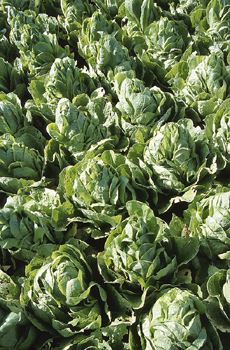 When you grow your own fruits and vegetables, you’re taking responsibility for your health into your own capable hands. Most of us weren’t raised on a farm, and gardening may not come naturally. But if you take your time, and allow yourself a few failures along the way, you’ll soon be an expert gardener and eating fresher, more nutritious foods than ever before.
When you grow your own fruits and vegetables, you’re taking responsibility for your health into your own capable hands. Most of us weren’t raised on a farm, and gardening may not come naturally. But if you take your time, and allow yourself a few failures along the way, you’ll soon be an expert gardener and eating fresher, more nutritious foods than ever before.
How to know what to grow
You’ll need to consider your space first. Some vegetables need a plot of land with room to spread out. But many can be grown in a coffee can or even an old boot! Container gardening is part agriculture, part eclectic art. You’ll also need to consider things like growing season, light and water availability, and what you plan to do with a bumper crop. Will you eat everything fresh? Or will you want to preserve, pickle or freeze some of the crop? Make sure you have the space and materials for your storage. If your freezer is full of zucchini, there’s not much room for ice cream.
Most importantly, though, what do you like to eat? And what is most nutritious? Staples like corn and potatoes are plentiful and cheap, so it’s best to put your efforts toward more nutrient dense crops. Here’s a list of the top 10 most nutritious garden veggies. Remember, a garden is a thing of pleasure. Don’t plant a veggie you hate just because it’s on the list. Substitute you favorites in.
Leafy greens
These babies are some of the easiest veggies to grow and come in lots of varieties–spinach, kale and collards are some of the most nutritious greens. “You’ll get more calcium in a bowl of fresh greens than in any dairy product,” says Dr. Brahm, a dentist in Glastonbury, CT. They’re also high in iron, potassium, and Vitamins A, B6, and C.
Broccoli
If you love broccoli, grow lots of it! Broccoli gives you plenty of calcium, iron, and magnesium, as well as Vitamin A, B6, and C. Just one cup of raw broccoli is 130% of your daily recommendation for Vitamin C.
Tomatoes
Tomatoes are some of the most popular garden residents. They contain lots of fiber, iron, magnesium, niacin, potassium, and Vitamin A, B6, and C. They’re also a great source of the antioxidant lycopene. And, well, they’re just so darn tasty!
Bell Peppers
Red bell peppers are high in potassium, riboflavin, and Vitamins A, B6, and C – in fact, one cup of red bell pepper packs an amazing 317% of the recommended daily allowance of Vitamin C and 93% of the recommended Vitamin A.
Garlic & Onions
Onions, leeks and garlic, besides being tasty, contain high levels of antioxidants and phytonutrients. Allicin (the key ingredient) is a known anti-viral, anti-bacterial and anti-fungal agent. You also get lots of vitamin C, B6 and manganese.
Carrots
Carrots are best grown in loose soil without a lot of rocks, which make them hard to grow in some areas. If you have the right conditions, they’re a great choice–very high in fiber, manganese, niacin, potassium, and Vitamins A, B6, and C.
Peas
The only downside to these common garden veggies is it’s hard to get them back to the house without eating them all. Peas are high in fiber, iron, magnesium, potassium, and Vitamin A, B6, and C. They also store well frozen, canned or dehydrated.
Beans
We’re not talking about green beans here, but the kind you can dry and store indefinitely like kidney beans and black beans. Dry beans, in general, are high in iron, fiber, manganese, and phosphorous. They are also a staple protein for vegetarians.
Sweet Potatoes
Sweet potatoes are a great source of nutrition, as long as you stay away from the brown sugar and marshmallows. You’ll get lots of fiber, potassium, manganese and vitamins A, C and B6.
Brussels Sprouts
These baby cabbages get a bad rep from kids, but these fiber-rich veggies pack some serious nutrition. They are a great source of thiamin, riboflavin, iron, magnesium, phosphorus, folate, potassium, manganese and copper, Vitamins A, C, K and B6. Vitamin C, Vitamin K, Vitamin B6,
Whether you’re trading your lawn for a garden plot or just planting a few container veggies, you can’t beat the health benefits of fresh air and fresh food.
Where to Get Fake Money for Your Child
Where to Find Play Money for Your Kid
Knowing where to get fake money for your child can pay off dividends when it comes to teaching them how to count currency, identify the various types of cash notes, and be a responsible consumer. Plus, younger children may be prone to rip or tear bills as their curious hands explore the texture, so using fake currency will save you from losing real money.
Fake Money on the Internet
Thanks to the Internet, fake bills can easily be downloaded or printed directly from the website. Here are some of the best (and safest) sites I’ve come across:
- Money Instructor – A comprehensive site devoted to teaching kids proper money management techniques. Play money can be printed off in order to teach children how to count money and recognize the various bills. Denominations include $1, $5, $10, $20, and $50. Coins can also be printed off in the same way.
- Printable Fake Cash – Offers printable fake money which can be used in school lesson plans ranging from kindergarten to middle school. Available in denominations of $5, $20, and $50, this fake money is ideal for teaching kids how to count and make change, how money works, and how to be financially responsible.
- Buy Cheaper – An online retailer selling everything from video games to women’s clothing. They have an entire section devoted to counterfeit or fake money, and images range from fake million-dollar bills to money featuring the face of President Obama. Besides teaching children to handle cash, this site may also be of interest to those who collect novelty items.
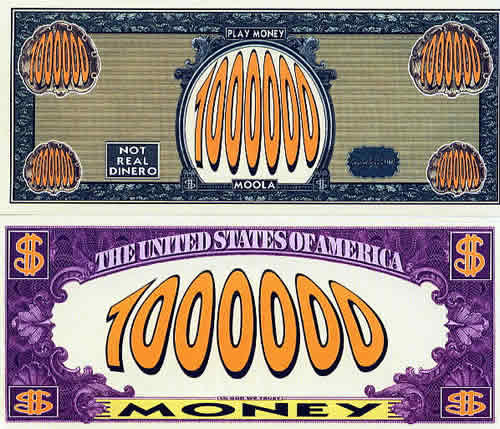
Counterfeit Money from Other Sources
While the Internet is a convenient source for fake currency, you will also find it available from other sources. Here are a few to try:
- Grocery Store – Most grocery stores have a section with toys, and you can often find a packet of play money hanging in this area. A larger retailer like Wal-Mart may have just as many options as a toy store.
- Toy Store – While a grocery store may only carry one type of play currency, a toy store should have a number of options. You child may be thrilled to get a million-dollar bill or one with a cartoon character on the front.
- Monopoly – If you want to know where to get fake money for your child, don’t forget about one of the most popular board games around. I’m talking, of course, about Monopoly, and the phrase “Monopoly money” has even become synonymous with fake currency. While it doesn’t resemble real money at all, and is printed on flimsy paper, the bright pinks and blues may keep some younger kids more interested than plain old green.
- Make Your Own Fake Money – If you’re more of a hands-on type, you and your child can create your own fake money. This is an excellent activity to do together, and it will allow your youngster to demonstrate their creativity. Just get some construction paper (white or green would be best), cut it into rectangles roughly the size of real bills, and draw whatever pictures you want on the front and back.
Now that you know where to get fake money for your child, it’s time to begin the process of teaching them about how the economy works. You may be surprised at how fast they pick up these lessons, and parents with more than one mortgage and steep credit card debt might expect to receive some sound financial advice from their kids.
Make Your Own Tye-Dye T-Shirts – For Kids
Create Tie-Dyed Clothing
While people often associate tie-dye styles with the hippie culture of the ‘60s and ‘70s, it’s been around far longer than most would imagine. In Peru, for example, examples of tie-dyed clothing have been traced back to somewhere between 500 and 800 A.D.
The art of tye-dyeing remains popular to this day, and our article is devoted to showing you how to make your own tye-dye t-shirts. Kids love tie-dye designs, and the vibrant colors and patterns allow them to explore their creative side while making something they can wear around the house and during casual activities. Grown-ups may also want to get in on the act, allowing the whole family to look like they’re going to Woodstock.

Tie-Dye Materials
Before you begin the tie-dyeing process, you’ll first need to gather together the necessary materials. I recommend the following:
- Bowl of soapy water (a large bowl works best)
- 100% Cotton T-shirts (one or more, depending on how many tie-dyed shirts you wish to make)
- Rubber bands
- Marbles or coins (tied into the fabric to achieve particular tie-dye designs)
- Latex gloves
- Salt (you’ll need one cup per dye bath)
- Fabric dye (multiple colors work best)
- Buckets (at least 2)
- Paper towels
- Plastic bags (sealable)
- Plastic bottles (spray and squeeze)
- Duct tape
- Garbage bags
- Tye-Dye Shirts for Kids (and Adults)
Now that you’ve assembled all your materials, it’s time to jump right in and start experimenting with the groovy world of tie-dye.
- Step #1 – First we’ll need to set up the dyeing area. This works best outside, especially since the dye you’ll be using is permanent. Find an old table or other outside workspace and cover it with a few garbage bags. Use the duct tape to secure the bags to the workspace. Keep the paper towels and a trash can nearby, as well as soapy water for washing your hands (or you can use latex gloves).
- Step #2 – Before your 100% cotton t-shirts can be tye-dyed, they’ll need to be prepared. This is accomplished by soaking them in water for a few minutes. Some dyes may also require the shirts to be soaked in soda ash beforehand (which results in more vibrant colors). If so, add the soda ash mixture–which should be included with the dye–into the water while soaking for 20 minutes. If the soda ash wasn’t included, you can always buy some at your local crafts store.
- Step #3 – Once the t-shirts have been soaked, use the rubber bands to tie off sections of the shirt. This will allow the dye to color certain sections while leaving others less affected. For the best results, use a combination of tying and multiple dyes to create a multi-colored piece of apparel. The following are the most commonly created patterns when learning how to make your own tye-dye t-shirts: circles (large or small), single stripe, multiple stripes, and a spiral design. Experiment to find the pattern you like best.
- Step #4 – Now you’ll need to prepare the dye bath. This can be accomplished by following the directions on the package of dye you’ve purchased. It’s also a good idea to dissolve one cup of salt into warm water and then add it to the dye bath. This will allow for more vivid colors, as well as helping the dye to set.
- Step #5 – Now that the dye bath is ready and the shirts have been tied, place them into the dye mixture. Allow them to soak for several minutes (I suggest at least 10), then wring them out and place them inside a plastic bag (making sure to seal it up).
- Step #6 – The tye-dyed shirts should be allowed to sit in their individual bags overnight.
- Step #7 – The following day, put on your latex gloves, remove the shirt from the bag, and take off the rubber bands. You’ll want to rinse the shirt to remove any excess dye, and you should always begin with warm water and then change to cool. When the water becomes clear, you’ll know that the rinsing process is complete. Be careful not to get any dye on your clothes, or it will stain the fabric permanently.
- Step #8 – Put the shirt in the washing machine and wash it with cold water (no detergent). Once the cycle is through, it’s smart to remove the shirt and run another cycle with detergent and warm water to remove any additional dye which may have come off in the machine (otherwise, your next load of clothing could be dyed).
- Step #9 – To dry your tie-dyed shirt, you can either hang it up or put it in the dryer on the coolest setting. When in doubt, hang it up to dry.
- Step #10 – Once the shirt has been worn for the first time, it’s recommended that you once again wash it separately just in case any dye remains. From that point forward, the shirt should be safe to put in with your normal load of clothes.
Congratulations, you now know how to make your own tye-dye t-shirts for kids (and adults). Once you’re outfitted and in the mood, put on some Hendrix, plug in a lava lamp, and get ready to feel those good vibrations washing over you.
Preschool Crafts – Making Paper Penguins
Everyone loves those cute, flightless birds known as penguins, and their distinctive shape and coloring makes them an ideal subject for an art project aimed at younger children. Even if you’ve never tried your hand at preschool crafts before, the simple instructions provided below will have you making paper penguins in no time.
But before we list the easy-to-follow steps, let’s take a look at the various species of penguins. Not only will these give your child a little more creative freedom when it comes to the project, but it can also serve as a springboard to a lesson about these adorable creatures.
- Emperor Penguin – The largest species of penguin, they can weigh up to 100 pounds. They have bright yellow ear patches, white bellies, and yellowish breasts.
- Macaroni Penguin – Has a yellow and orange crest which extends from the center of the forehead back to the neck. Bill is a mixture of orange and brown, while the iris is red.
- Chinstrap Penguin – Known as the most aggressive type of penguin, it has a thin black band running under its bill (which makes it look as though it’s wearing a black helmet with a chinstrap).
- King Penguin – The second largest species of penguin. Bright orange patches around ears, with silver-grey markings on their back.
- Fiordland Penguin – Most birds of the species have between 3 and 6 white stripes on their face, but their most distinctive feature are the yellow eyebrows that extend over the eye and slope downwards on the neck.
- African Penguin – The only species of penguin that breeds in Africa. A black stripe runs across their chest, and each penguin has black spots on their chest that are unique to the individual bird.
- Humboldt Penguin – Medium-sized penguins with a pink base on the bill, black breast band extending to the thigh, and a white border running from behind the eye to around the throat. Found on the coasts of Chile and Peru.
- White-flippered Penguin – A small species of penguin with distinctive white markings on its flippers.
- Royal Penguin – Have a white face and chin, with black and yellow plumage running from the base of the bill to the back of the head. Orange beak.
- Erect-crested Penguin – Notable for its yellow eyebrow stripe that forms an erect crest (for which it is named).
- Gentoo Penguin – A large species of penguin which has a white stripe on the top of its head. Of all species of penguins, they can swim the fastest underwater.
- Adelie Penguin – Tails are a bit longer than most penguins. Feathers at the base of their bill, and white rings around the eyes. Usually measure between 18 and 30 inches in length.
- Little Penguin – Only 12 to 13 inches in length, this smallest species of penguin is recognizable for its blue plumage.
- Rockhopper Penguin – Divided into the Western Rockhopper Penguin, Eastern Rockhopper Penguin, and Northern Rockhopper Penguin.
- Yellow-eyed Penguin – Native to New Zealand. A yellow band runs from its eyes to the back of its head. The head and the iris of the eyes are a pale yellow. One of the rarest species of penguins in the world.
- Magellanic Penguin – Medium-sized species of penguin with two black bands between the head and breast, and a white band that begins behind the eyes and rings around the throat.
- Snares Penguin – Reddish-brown beaks, with a patch of skin near the base. A yellow crest begins at the bill and runs to the back of the head. They breed in The Snares, a group of islands near New Zealand.
- Galapagos Penguin – Lives further north than any other species of penguin. White border begins behind the eye and meets at the throat. Two black bands run across their breasts, with the lower band extending down to the thigh. Found on the Galapagos Islands.
Making Penguins Out of Paper
For those who enjoy preschool crafts, this project will allow you to make penguins out of paper and a used yogurt container. The process takes very little time, and it’s an excellent way for younger children to learn about the world around them and explore their creative side. With a little experimentation, any of the penguin species described above can be made.
Before you begin, you’ll need to collect the following items:
- Yogurt container
- Glue (Elmer’s Glue will work just fine)
- Scissors
- Pencil
- Hole punch
- Construction paper (you’ll at least need the following colors: white, black, yellow, orange, pink, and brown)
Now it’s time to use our supplies and create a penguin!
- Step #1 – First, we’ll create the penguin’s body. To do this, you need to take black construction paper and cut a section measuring 3 ½ inches wide by 7 ½ inches long. This will be glued onto the yogurt container to cover up the label.
- Step #2 – For the penguin’s head, cut a circle out of the black construction paper and glue it near the top of the body. The head should extend up beyond the yogurt container.
- Step #3 – Now we’ll create the white area found on the penguin’s stomach. To do this, first take a sheet of white construction paper. Take your pencil and draw an upside-down letter U that measures 3 ½ inches long. Draw a line to connect the two ends of the U, and then cut out with scissors. Glue this to the front of the penguin’s body, making sure to keep the base of the U flush with the bottom of the yogurt container.
- Step #4 – Next up are the wings. Take some more black construction paper, and draw out a teardrop shape that’s 2 ½ inches long and 1 inch at the widest section. Cut another piece of paper in the exact same way, and you’ll have yourself two wings ready to be glued on. If you like a more three-dimensional look for your paper penguin, you can fold the wings in half (vertically) prior to attaching them.
- Step #5 – Now we’ll create the eyes. Take your hole punch and white construction paper, and punch out two white circles. Now do the same with a piece of brown construction paper. Trim the brown circles to make them smaller, and glue them onto the white circles (thus creating the pupils for the eyes). Once this has dried, glue the completed eyes evenly onto the penguin’s head.
- Step #6 – Take the pink construction paper and cut out two rectangles that measure 1 inch by ½ inch. On each rectangle, use your scissors to cut one ½ side into a wavy pattern. Fold up the straight edges of the other ½ side to create a tab, and use this area to apply glue and attach to the base of the penguin’s body. This will create the feet. If you desire a more complex look, you can do the same with black construction paper and overlap with the pink paper (giving the penguin feet that are pink on top and black on the bottom).
- Step #7 – To create the beak, draw a diamond shape onto the orange construction paper with each side measuring ¾ inch. Then fold the piece of paper in half to give the beak a three-dimensional effect. One end of the diamond will need to be folded upward in order to create a tab which can be glued onto the penguin’s head. The beak should be attached just below the eyes of the penguin.
Congratulations, you’ve just created a penguin using nothing more than construction paper, an old yogurt carton, and your imagination. While more complex versions of the project can be constructed, this basic example of preschool crafts should engage youngsters and have them wanting to learn more about the subject.
How to Get Over Your Fear of the Dentist
You are not alone. Many people from all walks of life hate going to the dentist. Even a simple cleaning can be enough to strike fear in the heart of even the bravest person. Jokes are made to ease the discomfort. Dentists are painted as things to be feared in movies as a reflection of life. It’s understandable why the dentist might be frightening, especially to children. After all, the dentist’s office is full of strange and intimidating looking equipment and unfamiliar noises.
Where does the fear come from?
A fear of the dentist can come from any number of places. Whether it’s from negative experiences of the past or the uncomfortable surroundings, anxiety over a dentist appointment is a very manageable problem. A good dentist can help even the most anxious of patients have a pleasant visit.
First, find a dentist you trust
 The first necessary step to overcoming your fear of dentists is finding a good dentist. Talk to your friends and family for a good recommendation. If the people you know and trust feel comfortable, there’s a greater chance you will, too. If none of your friends and family can make a good recommendation, it’s time to hit the yellow pages or the internet. Look for ads advertising that a dentist is “gentle”, or frequently works with patience fearing dentists. If that’s not enough to help you make your choice, check out reviews online. Many popular review sites have customer reviews, which can be excellent references.
The first necessary step to overcoming your fear of dentists is finding a good dentist. Talk to your friends and family for a good recommendation. If the people you know and trust feel comfortable, there’s a greater chance you will, too. If none of your friends and family can make a good recommendation, it’s time to hit the yellow pages or the internet. Look for ads advertising that a dentist is “gentle”, or frequently works with patience fearing dentists. If that’s not enough to help you make your choice, check out reviews online. Many popular review sites have customer reviews, which can be excellent references.
Get clues from your first phone call
After you’ve decided on a dentist, it’s time to make the appointment. Listen to the receptionist. Is she friendly? Does she answer all of your questions and concerns as completely as possible? Friendly, helpful staff is often a sign of a friendly and helpful dentist. If you get a chance, swing by the office and take a look. An office that appears pleasant and busy is a sign of a successful dentist. To be successful, his customers must like his service.
Write up a list of concerns and bring it with you
When preparing for the visit it helps to think of what bothers you about dentistry. If it’s the sound of drilling, picking, and breaking teeth, many dentists will allow you to bring an mp3 player and headphones to tune out the procedure. Come up with a list of other concerns you have so you can discuss them with your dentist at your appointment. Having them on hand will prevent the added anxiety of trying to remember it all when you get there. It may also help to arrange to have a friend come with you to the appointment. Sitting in the waiting room is a lot less intimidating when you don’t have to wait alone. Practice some relaxation techniques in anticipation for your appointment. If you don’t know any, look some up online.
Voice your concerns, don’t try to hide your fear
At the office be sure to inform the dentist or dental hygienist of your concerns. Most dentists are more than happy to help you overcome your fears and make you as comfortable as possible. They are supportive people who are willing to help you overcome any past traumas and work to make the experience as pain-free and easy as possible. Your dentist may also be able to suggest ways to help manage your anxiety, such as visualization or even sedation. Your dentist is also there to answer any questions you have at the beginning of the appointment. Sometimes that knowledge alone can increase your comfort during a cleaning or procedure.
Dr. Takacs, a sedation dentist in Lexington, KY suggests that it’s helpful to change your perspective when it comes to dentistry. “Think of your dentist as a friend,” she advises. “Remind yourself that your dentist, like any other doctor, cares about your wellbeing and is there to help.”
It’s all too easy to think of the dentist as frightening, so sometimes it takes a little while to become comfortable with a different outlook. It’s easier to feel confident about seeing someone nice, friendly, and looking after your oral health than it is to think about someone who does root canals and drills teeth for a living. By focusing on the good, it’s easier to relax even before the appointment begins.
Sometimes getting over your fear of the dentist is as simple as finding a dentist that works well for you. Take some time to find a good dentist and to discuss your concerns openly. It can make a world of difference.
How to Screw Up a Business Card
Is there anything worse than a bad business card? Business cards can be “bad” for lots of different reasons, but does the particular reason for a business card’s awfulness really matter?
A bad business card means less interest in you and your business and makes you and your interests look sloppy and disinterested. Since a business card is a relatively easy thing to put together, making a mistake or putting out a terrible, unattractive, or misprinted business card says a lot about your skills.
Here are some of the most common ways that people screw up their business cards.
Leave Important Information Off
 How many times have you been handed a business card that didn’t give sufficient information? Business cards that lack critical information are worthless, wastes of money and time, and the most likely cards to be ignored or thrown away.
How many times have you been handed a business card that didn’t give sufficient information? Business cards that lack critical information are worthless, wastes of money and time, and the most likely cards to be ignored or thrown away.
Your business card should have your name, the name of your business, your contact information (including physical and web address), and maybe a business logo if you have an attractive one to add.
Make sure your business card contains a phone number where you or someone at your place of business can be reached during normal business hours. It should also have a valid email address, if you want to be contacted by potential customers via email.
Add Too Much Information
Even worse than a business card without vital pieces of contact info are those overly busy, tacky looking business cards so stuffed with information and details that you can’t make heads or tails of the card itself.
There’s no real need to put a “mission statement” or multiple phone numbers and email addresses on your business card. A recent trend in business cards has been to put not just one person’s name, but the names of the entire executive staff. Who cares what your bosses name and his bosses name are . . . this is your business card. A good website URL can clear up any questions your customers may have about the names and roles of the businessmen above you in the pecking order.
Too much information makes it look like you and your business are unorganized or heavy-handed, and cards that are stuffed with too many details are just as likely to be tossed out with yesterday’s garbage as cards that have too little information and too few details.
Print Incorrect Details
Putting incorrect information on your business card isn’t as big of a problem as handing out a business card with a bad design—if you catch the error and reprint the cards before handing them out. Sure, it adds cost and is wasteful to have to reprint business cards, but if you catch the mistakes in time, you can avoid embarrassing yourself and your business.
Now that everyone has an email address and website URL on their business card, it is easier than ever to put bad information on business cards. It can be hard to “spell check” a URL or email address, and a single incorrect symbol, number, or letter in an email address or URL can frustrate your potential customers and have them wondering about the legitimacy of your business.
That’s why your business card should be checked top to bottom, gone over with a fine tooth comb by more than one person to check for mistakes. Type in the URL of your website symbol by symbol directly from your business card the same way your customers will. Otherwise you run the risk of handing out bad info.
Get Too Gimmicky
There are sometimes good reasons for business card gimmicks, but most of the time a straightforward business card is best. Gimmicky business cards work best in small runs—print ten or twenty unusual cards to keep around the office for special clients or customers you think would get a kick out of these goofy cards. You should always have a more traditional business card to back up a business card built around a gimmick.
A business card gimmick can help certain people remember you or your business, but they often make it more difficult for a customer to keep track of your card. I knew a guy who had a business card designed that contained tiny seeds that (if watered) grew little watercress seedlings out of the top of the card. A nice gimmick, but pretty difficult to keep in a business card organizer wouldn’t you say?
Print Too Few Cards
One of the classic business card mistakes is simply not printing enough business cards. If you’ve spent lots of time and effort putting together your business card, running out during a meeting or on a lengthy business trip is a real amateur mistake, and is basically an invitation to your competition to step in and hand out their own cards in your place.
If you find that you usually print too few business cards, there’s a simple way to avoid this mistake in the future. Find a business card printer that charges less per card. Simplify your design to reduce costs and print three times as many cards as you think you’ll need. There’s just no reason to not have a business card every time you need one.
If you want your customers to question the ability of you or your business to get the job done, go ahead and make any of the above mistakes. Business cards can be designed and printed from pretty much any computer these days, and any idiot can use a business card template or printing service to put together a solid business card.
Avoid the above mistakes to avoid losing business and looking like a fool. Printing good business cards is easy enough if you approach the task with a little care.
A good way to make sure you have a GOOD business card is to have criteria or standards for your company. Look at this page for an example of guidelines for business cards.
How to Get a Credit Card
Credit Applications and Realistic Expectations
Due to the troubles in the economy, the standards for how to get a credit card have changed in the last couple of years.
When you have a credit crunch, underwriters naturally are going to tighten up standards and add restrictions to manage their risk. Interest rates are likely to increase.
So you want to get the latest information on being issued a line of credit through one of the major finance and credit institutions.
Even if you have bad credit or you’re a “credit ghost” (no credit history), you shouldn’t give up. You just need tips for how to get a credit card.
Apply for the Correct Credit Card
When it’s time to get your own credit card, do a little online research and find the type of credit card which fits your demographic. There is a credit card designed for every person in the world; you just have to find it.
There are debit cards specifically designed for kids and teens (see “Visa Buxx”), so it shouldn’t surprise you that there are credit cards for college students and credit cards for seniors, too. Find the one whose program you’re most likely to be accepted into and apply for this card. You might not be getting an American Express Card or a Visa Gold Card on your first try, but you’ll be able to get a credit card, no matter what your credit issues are.
In those particular cases, here are way to get a credit card if you have bad credit.
Explain Your Bad Credit
One fact many debtors don’t know is that you can add a personal statement to your credit report explaining any defaults or bad items on your history. If you have some issues in your recent past, use those 100 words to explain what happened. If you lost your job in the economic crunch or you went through a long illness or divorce, add that to your credit score. People understand these things and they show your credit problems are likely a one-time issue, not a pattern of trouble.
Get a Subprime Credit Rate
People with a bad credit history or no credit background have to be ready to deal with subprime credit rates. “Subprime” is another word for crazy-high interest rates on your credit line. You don’t have the history other people do, so you are asked to pay high margins when you borrow money. Remember, a credit card is borrowing money from a financial institution, even if it seems like charging is buying things and paying later.
Getting a subprime credit rate mitigates some of the danger the credit card company faces when issuing you a credit card. When you pay huge amounts in interest, you’ll cover the costs if you eventually default on credit.
Imagine you’ve gotten your first credit card and you only have a $1,000 maximum. Then imagine you max out your credit card and end up paying only on the interest for a year or two. Even if you pay $1,200 in pure interest, not paying down your credit bill, then default on your loan, the credit institution ends up with a net gain. Extrapolate that concept out to big sums of money in the tens of thousands of dollars, or across tens of thousands of debtors borrowing from a creditor institution, and you’ll see how even defaulting debtors still pay off for a firm.
Build Your Credit Score
The key to getting a subprime credit rate is to avoid paying interest. Don’t overcharge your card. Instead, use it for convenience, paying only what you can afford to pay off at the end of the month. When you do this, you avoid interest payments. Your bad interest rate doesn’t matter, but you begin to establish a positive credit history. Funny enough, you hear about creditors calling the people who pay off their bill every month and never pay interest “deadbeats”, because lenders make their money off the people who fall into the credit trap.
How to Improve Your Cholesterol
Lower Your Litoprotein Levels
Learning how to improve your cholesterol can extend your life by years, if not decades.
Not only that, lowering your cholesterol levels will improve the quality of your life.
Maybe both of those facts are axiomatic, but people who are trying to reduce their cholesterol numbers should be reminded that their life will improve, even if they don’t get to eat everything they’ve grown used to over the years.
When I list off a group of cholesterol improvement suggestions, you’re either going to completely revolt at the notion or try an unrealistic attempt to cut everything out of your diet, setting yourself up for a backslide.
Unless a severe medical condition has brought you to this article, I suggest you choose a half-dozen of the tips and try them out first. Take realistic steps to improve your health, then make incremental improvements as your body and mind adjust to the changes in your lifestyle.
Quick Cholesterol How-To Chart
Below is a quick set of tips for improving your cholesterol. While living healthier entails more than what’s on this list, if you can follow most or all of the following items, you should be in pretty good shape. That might be harder done than said.
- Eat Smaller Portions
- Eat Smaller Evening Meals
- Eat Less Red Meat
- Eat More Fish
- Eat Few Egg Yolks
- Eat Whole Breads and Cracker
- Eat Whole Grain Pasta
- Eat Whole Grain Cereal
- Eat More Legumes
- Don’t Eat Fried Foods
- Eat Less Saturated Fat
- Eat Only 3-4 Ounces of Fish
- Eat Only 3-4 Ounces of Poultry
- Eat More Soy Products
- Eat Much Less Refined Sugar
- Eat Less White Flour
- Eat Less Sugar of All Types
- Eat Fewer Fatty Condiments
- Drink Less Alcohol
That’s a daunting list of directions. Anyone with high cholesterol is better off consuming no alcohol whatsoever, but most of us already assumed that drinking alcoholic beverages is something not done optimally, anyway. Reduce as much as you can. In cases where you don’t feel you can cut foods out cold turkey, make an effort to reduce intake and reduce as much as you can.
In the case of the egg yolks, I’d suggest eating no more than two or three of these in a week’s time. Legumes include black-eyed peas and lentils, which are among some of the healthiest beans to eat. Refined sugars tend to be the sugars you find in candy, cookies, cakes, and a myriad of other goodies. It’s hard to avoid sweets altogether if you have a sweet tooth, but try to replace some of the refined sugars with fruits instead.
What is a Good Cholesterol Level?
There is no one answer for that question, so I’ll talk in generalities here. For your average person, a low-density lipoprotein or LDL cholesterol level under 130 milligrams per deciliter of blood is best. If you are considered to be an “at risk” patient, your LDL cholesterol level may need to be significantly lower.
For instance, someone with a history of heart problems or who’s had a heart attack in the past may need a cholesterol level in the 70 mg/dl range. Other risk factors that might change your optimum level of cholesterol includes smoking, diabetes, and high blood pressure. If you smoke habitually or you have either diabetes or high blood pressure, you need to keep your cholesterol level lower. Smoking hardens your vascular system, so when you have hardened arteries combined with high cholesterol, that’s a recipe for disaster.
What Is Low-Density Cholesterol?
LDL is considered the bad cholesterol, so this is the one most people look at when getting their cholesterol level checked. That doesn’t mean you should totally disregard your other cholesterol, though.
High-Density Cholesterol
HDL cholesterol is the good cholesterol (or is considered as such), because its appearance in large amounts tends to unclog your arteries. As a general rule, the higher this count goes, the better. But if your total cholesterol count (LDL and HDL combined) goes above 200 mg/dl, then you are still considered to have a high cholesterol levels.
How to Read an Electricity Meter
Reading an Energy Meter
You may want to learn how to read an electricity meter to track your monthly energy consumption, so you and your family can become more efficient energy consumers.
Or learning how to read an electric meter may be your way of keeping your energy coop or provider honest, checking up on their figures and seeing they aren’t cheating you on your electric bill.
Whatever your reason for reading the meter on your energy usage, reading an electricity meter is a good skill to have.
Once you learn the basics and start keeping your own records, the process will become second nature. That might happen right from the start, if you have the type of energy meter that’s easier to read.
How to Read a Digital Electricity Meter
A digital electricity meter looks quite similar to the odometer on your car. It should have a face on the gauge with five numbers showing, and these numbers should roll over like an odometer. Reading this meter is as easy as reading the mileage on your car.
The fifth number (going left to right) on the digital meter is going to change often. Every time this number increases, you have used another kilowatt-hour of energy in your house and around your property. When the meter reader comes to your house to read this gauge, or when the electric company’s machines back at the home office are transmitted this number, they are able to determine your energy consumption for the month by subtracting last month’s number from this month’s number.
You’ll want to do the same, so get a small notepad and jot down your monthly meter readings. Make certain to note what day (day, month, and year) you check your electric meter. Learn about the local rates, so you can figure out what your energy bill should be for the month.
How to Read a Dial Meter
The dial meter is going to be a lot harder to read. You’ll probably wonder why in the heck the electric company would use such a complicated device. I couldn’t really give you a clear answer to that question, but I can tell you how they’re read and make it much easier to decipher.
Once again, you’ll see five dials, so your electric reading should include five numbers. In this case, though, the dials look a little bit like a clock face, except the numbers go from 0 to 9, with the zero at “12 o’clock” on the dial. You’ll also notice that two of the dials–#2 and #4 running left to right–go counterclockwise, while dials 1, 3, and 5 go clockwise.
Reading the Dials Carefully
Read each dial carefully, taking note which way the dial runs (clockwise or counterclockwise). Whichever way they go, read them as if they start at 1 and go to 0. If the dial has passed a number, count that as that number. If it’s between a number (say the “1” and “2”), read this as the last number passed (“1” in this case).
Do the same for all four dials. The number you arrive at should be your electricity reading for the month. Most of the time, the higher numbers (or the ones furthest on the left) shouldn’t move very often, while the lower couple of numbers should move every month. Once again, this electricity gauge is tracking the number of kilowatt-hours of electricity you’ve used.
To get the amount of electricity consumption for the past month, simply subtract last month’s reading from this month’s reading.
When the Hand is Directly on a Number
When a dial hand is directly on a number, you might have trouble determining exactly how to mark the number. Let’s take an example of a dial that’s pointing at a “5”, but you’re uncertain whether it’s really on a five or only in the high fours.
Take a look at the hand on the right. If that dial has passed “0”, then you should assume it’s rolled over to the next higher number, in this case a “5”. The number on the dials should be “50”.
If the number on the dial to the right hasn’t yet passed the “0”, then assume it’s not rolled over and choose the lower of the two numbers, in this case a “4”. The number on the dials should read “49”.
Track Your Electric Bill – Read the Meter
That’s how you track your electricity meter. If you intend on keeping track of your own energy consumption, remember to keep track from one month to the next. Keep your notebook in the same place, preferably somewhere secure, but somewhere near to the electric meter, and keep the electric company honest.
How to Improve Your Blood Pressure
Blood Pressure Advice
When you’re researching how to improve your blood pressure, you’re going to hear a lot about what to avoid, what to cut out of your diet, and what not to do.
That’s can get your healthy living off to a negative start, though, so I wanted to offer a number of “what to do” tips for lowering your blood pressure.
You probably already know that lowering your sodium intake is huge in lowering your blood pressure.
The steps below help to lower your sodium levels by taking some action and introducing low sodium foods into your diet to replace the standard high sodium foods you normally eat.
Eat Fruits and Vegetables
Eating produce is one of the best ways to lower your blood pressure. Many fruits and vegetables that are low in sodium happen to be high in potassium, which is a good thing. Eat foods like tomatoes, oranges, bananas, baked potatoes (not french fries or tots), sweet potatoes, cantaloupes, spinach, winter squash, and beans.
Eat Healthy Fats
Not all fats are bad. Adding “healthy fats” to your diet can be a good thing, if you’re replacing the bad fats with new sources of nutrition. Unstaturated fats, including monounsaturated fats and polyunsaturated fats, are the good fats you’re looking for. Here’s a list of high-fat foods to look for.
- Olive Oil
- Olives
- Sunflower Oil
- Sesame Oil
- Canola Oil
- Soybean Oil
- Safflower Oil
- Corn Oil
- Avocados
- Almonds
- Peanuts
- Macademia Nuts
- Pecans
- Cashews
- Hazelnuts
- Walnuts
- Peanut Butter
- Soymilk
- Tofu
- Sunflower Seeds (watch out for the salt)
- Sesame Seeds
- Pumpkin Seeds
- Flaxseed
- Salmon
- Tuna
- Herring
- Sardines
- Trout
- Mackerel
Long story short, eating lots of fish and nuts tend to be a good thing. Peanut butter is good to mix into your diet a few times a week. Cooking in healthy oils is important. Dipping your bread in olive oil with herbs is a much better option than butter or margarine, and once you get used to it, you’ll come to look forward to that part of your meal.
Eat Whole Grains Instead of Starches
Whole grains help you retain your potassium. Common whole grain products you’ll find at the grocery store include whole wheat bread, whole wheat pasta, popcorn, teff flour, rolled oats, triticale flour, and whole wheat flour. Refined-grain products are not as healthy as whole wheat and include non-wholewheat pasta, white flour, white bread, hominy, and white rice.
Reading the packages of whole wheat foods can get tricky or even deceptive at times. If the first ingredient says “wholewheat”, you’re usually in good condition. But some products are colored with molasses or caramel coloring to make them appear like whole wheat products, while other products list wholewheat in their ingredients, even when it’s not the dominant ingredient. Pay close attention when buying wholewheat.
Eat Legumes
Much of this has already been covered, but I’ll mention it once again. Eat legumes like beans, seeds, and nuts. These are foods produced by plants to regenerate life, and eating legumes is a good way to increase the length of your life, too. Eating nuts, seeds, and beans is almost always a good idea.
Drink Low-Fat Milk
Low fat milk has all the nutritional value in calcium that whole milk has, but without fat content or with a much-reduced fat content. Buying 2% or 1% or skim milk is a good way to lower your fat intake and hardly notice it.
Eat Dark Chocolate (in small amounts)
Eating dark chocolate in small amounts introduces antioxidants into your bloodstream that activate nitric oxide. Nitric oxide relaxes your blood vessels. Remember that eating a lot of dark chocolate is not healthy. Also realize that milk chocolate doesn’t produce the same positive results.
Work on Your Inner Calm
Take ten minutes a day to work on your inner calm. Spend that time breathing deeply and clearly your mind about the past and the future. Focus on the moment. Listen to calming music. Clear your mind. Then take some more deep breaths.
Breathing deeply is a good stress-reducer throughout the course of the day, too. If you feel yourself getting stressed, take three deep breaths before you say or do anything. Other stress relievers include laughing throughout the day (it releases endorphins), enjoying time with children and family, and finding other positive activities that take your mind off your cares and concerns.
Get Moderate Exercise
Get your blood flowing every day with 30 minutes of moderate exercise. Get a 30 minute walk or two 15 minute walks during the day. Go to the gym if you prefer. Do something to increase blood flow, breathing capacity, and work out your muscles. All of this tends to release stress.
What Are RC Toys?
A lot of men, children and even women have started collecting R/C or remote control toys that they can play with or assemble during their pastime. It’s a hobby that provides real satisfaction especially for those who prefer to assemble their own RCs from scratch instead of buying the ready to run or ready to fly varieties. The challenge lies in getting the RC up and running after it has been fully assembled and the tiny machines are properly set-up. It can be a source of pride to show people that the RC you are controlling is something that you have made on your own. Whether you’re looking to play on land, sea or air, you’re bound to find something that you’ll like.
RC Helicopters
RC Helicopters have come a long way since they only used to go up or down, forwards and backwards. From simple 3-channel Remote control helicopters for beginners that can turn, hover and go up and down to those for experts that go all the way up to 6 channels. These allow you to complete almost any maneuver that a real helicopter would be able to do allowing you to make some pretty “death-defying” maneuvers. Replaceable parts means despite the many crashes you have (there will be a lot), you’ll be able to replace every single part, and keep your remote control helicopter for many years to come!
RC Tanks
From scale models modeled after your favorite wartime models and painted in camouflage, to tanks that have infrared sensors that allow you to battle your buddy RC tanks are a ton of fun. Ranging in price from less than $20 to those that are upwards of $100 you’ll have tons of fun with remote control tanks. Many are now what’s called airsoft tanks that can even shoot BB’s and emit both sound AND smoke to give you a more realistic experience. With tanks from the US models like the M1A2 Abrams to German tanks like the Tiger you’ll be able to play out your favorite battles from history!
RC Cars
From scale model race cars, upgradeable piece by piece just like their real life counterparts, to buggies that are the same and can be run or raced off-road there is an almost unlimited number of customization and fun you can have with these. It can get expensive, by upgrading from electric to the super-fast nitro-powered versions, so watch out and start slow!
In these modern times, R/C or remote control toys are becoming more popular than ever before. The forward and backward movement of simple remote toy cars is now part of the past as innovative RC toys are being introduced by the RC industry. It is now common to see people flying their gyro RC helicopters both indoors and outdoors, sail their scale model versions of RC boats and run upgradable cars at blinding speeds. The options for hobbyists and RC enthusiasts come aplenty at XenonProject.com. This toy and hobby company offers nothing but the best products and services associated with RCs. Anytime you are in need of a new RC to feature in your collection, you can always come to Xenon Project anytime and you will get practically anything you need for your RC hobby.
If you want to buy any type of RC, whether fully assembled or something that you want to set-up yourself, you can always visit the online RC toy and hobby shop Xenon Project where you’ll find parts and fully assembled versions of all your favorite remote control toys.. Certainly, you will be able to find something from the long list of RC helicopters, RC boats and tanks they have on display.
How to Get a Job on a Paper Route
How to Get a Job on a Paper Route
Once upon a time, a kid’s first job was having a paper route. Times have changed, and many newspapers distribute their papers with adults driving around in cars, but the paper route used to be the domain of kids. My own first job was a paper route–I’d wake up at 4:30 in the morning, bundle my papers, and jump on my bike to distribute newspapers in a twenty-block radius. You could make enough money with a paper route in the summer to support a decent comic book habit all year long.
Luckily, not every newspaper is against using kids for paper routes these days. Here’s a quick guide to getting a job on a paper route.
1. Contact your city newspaper and ask who you need to talk to about getting a paper route. If you’re lucky enough to live in a city with more than one newspaper, you have more than one opportunity to run a paper route. When you talk to the paper, make sure the schedule is something you can work with. If you have a commitment that would interrupt or otherwise affect your paper route, you’ll have to choose between the two. Some papers have morning routes and afternoon routes, so you may have more than one option.
2. If you can’t get a job right away, you can contact the paper or a paper carrier and ask to get a job as a substitute. Many paper carriers are contract workers and aren’t employed directly by the newspaper. These people are responsible for finding their own substitute workers.
3. You need a reliable means of transportation to run your paper route, either a bicycle or a car. Make sure your bike is serviced and reliable, with wheels that are full of air and unlikely to break. Remember that you’ll need to deliver papers even if the weather is bad, so make sure your bike or car can run in rain or snow. If your bike or car breaks down, you’ll still have the responsibility of delivering papers, so be prepared to deliver on foot if you have to.
4. Now that you’ve got your paper route and a reliable vehicle, there are some things to keep in mind. Bring plenty of water and a light snack just in case your route runs long. Delivering papers can be thirsty work, especially if you’re delivering them as a summer job, and you may not have time to stop and get a drink or a snack. Also, keep in mind that you are responsible for hiring and training a substitute paper delivery person in case you are sick or unable to deliver papers.
A paper route is a huge responsibility–people get very angry when they don’t get their newspaper, and they expect it to be in their driveway or on their porch every morning. You can make a good deal of money delivering papers, but it is also a difficult job that requires commitment. Good luck.
Middle School Science Fair – How to Make a Fake Volcano
Middle School Science Fair – How to Make a Fake Volcano
The old “fake volcano” is a classic science fair project for middle school students. Understanding how a volcano works is just part of the project–the highlight is the actual explosion of the volcano itself. While this may not be the most original science fair project, it is certainly a popular choice and has a cool visual element that keeps kids excited about the project.
The purpose of the model volcano eruption is to learn about volcanoes but also to learn about the chemical reaction taking place between the ingredients of the eruption itself.
Here’s how to make a fake volcano for your next middle school science fair project.
Materials
1 box of modeling clay
Newspaper
Baking pan (disposable)
500ml empty plastic soda bottle
4 tbsp baking soda
1/2 cup vinegar
Red food coloring
Liquid dish detergent
Alka-seltzer tablets
Funnel
Plain paper
Pens or pencils
Scissors
Assembling the Volcano
1. Line the baking tray with a few layers of old newspaper. You can find disposable aluminum baking trays at the grocery store if you don’t want to risk ruining the one from your kitchen.
2. Place an empty soda bottle in the middle of the tray. Here’s the tough part–you need to mold the clay material around the bottle to form a basic volcano shape. Volcanos are generally shaped like mountains with a giant open crater at the top.
3. Get creative–draw pictures of buildings and people on the scrap paper. Then cut out the buildings and people with scissors, leaving a small tab at the bottom of each.
4. Bury the tabs on the bottoms of the drawings around the volcano’s base. They should stand straight up. The tabs help hold them in place.
5. It is time to start the eruption–add a few drops of red food coloring to the bottom of the soda bottle.
6. Fill the bottle with warm water using a funnel. Once the water is about three inches from the top of the bottle, stop filling.
7. Place six drops of detergent into the bottle.
8. Pour the pre measured baking soda into the bottle using a funnel.
9. Add the vinegar to the mixture by pouring it through the funnel. You can add an Alka Seltzer table to make the eruption last longer, but you don’t have to. Remove the funnel quickly to allow the chemical reaction between the vinegar and baking soda to occur.
Since the “eruption” will probably ruin the clay of the volcano, you can only really get away with a single eruption. Make sure your middle school student knows how to make the eruption happen, since they probably only get one shot at it.
The point of this project is two-fold–your student should study volcanoes and how they erupt, but they should also understand the chemical reaction going on inside the model volcano. Make sure they understand why baking soda and vinegar react the way they do, otherwise you’ve just made a cool clay model without learning anything about science.
How to Make a Barbie House
How to Make a Barbie House
If you’ve ever shopped around for a house for Barbie, you know the market’s pretty limited. You’d think the people at Mattel would understand that Barbie has a lot of stuff and needs a house that can hold it all. But no–most of the commercially available Barbie houses are too small for Barbie’s extensive wardrobe, not to mention her collection of cars and (let’s face it) boyfriends.
If you want a Barbie house big enough for the average Barbie collector, you’re going to have to take matters into your own hands. Building a Barbie house isn’t a huge project–you should be able to put together a sweet new pad for Barbie in a single afternoon.
Materials You’ll Need
Different sized paint brushes
Cheap plastic “bookcases” or shelving units
Cardboard
One or two yards of indoor carpeting
Glue
Paint
Scrap wallpaper
Cardboard
Hobby saws or knives
Assembling Barbie’s New House
1. Your first step is to gather your materials. The most important feature of your new Barbie house is the small plastic bookshelves or shelving units that actually constitute the house. Make sure the shelves you buy are tall enough to allow Barbie and her friends to stand up inside. Also, you should decide how big you want the house to be. Determining the number of rooms and floors for Barbie’s new mansion is key to figuring out how many plastic shelves you need.
2. Assemble the plastic shelving units. Be creative–if you want a two-story house for Barbie, you should buy a three shelf unit so you can remove one of the shelves and use it for a front porch or an adjoining pool house. Your imagination is your only limit.
3. Barbie wants fancy carpeting, so pick up a yard or two of nice (but thin) indoor/outdoor carpeting. Just cut the carpet to fit the floors and glue it down. Not every room in Barbie’s house needs carpeting . . . maybe Barbie is a hardwood floor or tile girl. Buy materials to suit the look of the interior of her house.
4. If you want, you can purchase two shelving units and hinge them at the back, so that Barbie’s house can open for more living room. Either way, you’ll need to use cardboard or thin hobby wood to cover up the plastic “walls”. You may not even have to wallpaper the back and side walls if you find good enough wood to cover the walls.
5. If Barbie doesn’t like wood paneled walls, use scrap wallpaper to cover both sides of the interior walls and one side of the back and side walls. This is another time when you should get creative. Wallpaper comes in all styles, and most wallpaper or home improvement stores have deals on scrap or older styles of wallpaper.
6. Now it is time to decorate the exterior of Barbie’s new house. Plastic outside walls just don’t do–so cover the exterior of her house with shelf paper in an attractive color, or (even better for Barbie’s style) go ahead and paint the exterior an attractive color. Hobby stores also sell imitation wood and brick exteriors. Remember to do whatever Barbie wants.
7. Barbie’s house looks pretty plain without windows and doors–using a hobby saw or sharp knife, cut out an appropriate number of window and door holes. Barbie’s house should have a front door and a back door, and maybe a side door if Barbie’s house comes with a pool or hot tub. As for windows–get creative. Usually, homes have an even number of windows, or at least a balanced look to the windows themselves. A few windows of different sizes should look just fine. Be sure to decorate the exterior of the windows with shutters or dress up the inside with curtains or drapes made from old fabric.
8. You have the option of attaching cardboard walls to the bookcase using glue if your shelving units are difficult to paint on or glue to. You can attach pretty much anything you want to the cardboard interior walls.
Keep In Mind:
Barbie has a lot of furniture and a lot of friends. Make sure your rooms are big enough for slumber parties, dinner parties, and just hanging out time.
Some rooms in Barbie’s house are smaller than others–bathrooms and closets are generally smaller than bedrooms, and living rooms and kitchens should be the biggest rooms of all.
Every type of room has its own style of wallpaper. You wouldn’t want flowery, girly wallpaper in Barbie’s gym, and you wouldn’t paint a bathroom the same way you’d paint a dining room.
Keep Barbie’s size in mind when it comes time to cut windows and doors. If Barbie can’t fit through the door, she won’t be happy with her house.
The biggest thing of all–make sure that there’s a place in your house where Barbie’s new mansion fits. Otherwise, your favorite Barbie collector won’t be able to play with it.
How to Purchase Precious Metals Online
How to Purchase Precious Metals Online
If you want to buy precious metals online, you can’t go into it willy-nilly. Buying precious metals is a serious investment. Not only will you have to make sure you’re buying from a legitimate precious metals dealer, you need to consider how you’re going to store and protect your investment.
Precious metals are good investments, especially for long-term asset protection. Precious metals aren’t affected by the forces that can make a country’s economy fluctuate. They are liquid assets, meaning you can easily turn them into cash. They are also portable–you can take your investment with you and have a physical representation of your investment rather than some set of numbers on a printed page.
Here’s a quick guide to buying precious metals online.
1. For starters, there are five different ways you can invest in precious metals–coins and bars, certificates, precious metals mutual funds, stock in mining companies, and gold and metal futures.
2. If you are investing in precious metals to diversify your investment holdings, you should always invest in tangible metals–coins or bars. Before investing in tangible metals online, check the US Mint’s approved list of metals dealers.
3. Precious metal bars (also called bullion) is usually made up of the purest form of metals. Metal coins (also known as numismatics) are minted coins, usually minted to mark special occasions. These may not be as pure as bars or bullion.
4. Search for reputable online precious metals dealers. Usually, the best place to buy precious metals online is a dealer that also has a land-based business. To make sure a dealer is reputable, check how long the metals dealer has been in business.
5. Shop around. Different dealers have different markups and fees for selling or storing precious metals. The most popular way to invest in gold, for instance, is the 1 troy ounce coin or bar–these are easy to buy and sell and easy to store, but buying in small sizes usually results in higher fees. Heavier amounts of precious metals will cost less in the long-haul, but are more difficult to store and protect.
6. Choose to buy precious metals certificates online if you don’t want the hassle of storing and protecting physical metals. A metals certificate indicates that you own a specific quantity of a specific metal, but you don’t have to do any physical storage of the metal yourself.
7. Another good online precious metals investment is to invest in stocks and mutual funds that are investments in precious metals. Precious metals funds are the most stable metal investment on paper, mostly because they are diversified and managed unlike stocks. A purchase of stock is an investment in a single company.
Investments in metal futures are the most dangerous form of metal investing, because these investments are subject to the same market fluctuations that make national economies go up and down.
Investing in precious metals is a smart choice when the economy is in trouble, but you should always keep track of your investments by looking at the daily market price.
How to Buy Gold Online
How to Buy Gold Online
How to Buy Silver Bars
How to Buy Silver Bars
With all the hubbub about investment-grade gold, it is easy to forget about humble silver. Silver is cheaper than gold simply because there’s more of it. Silver is an investment equal to gold in terms of expected profit, and you can afford more of it by virtue of it being less expensive.
If you want to buy silver bars, the process is fairly simple. Here’s a quick guide to buying silver bars.
1. Learn About Silver
You need to know just enough about silver to be able to know if the price you’re going to pay is a good one. High quality (investment-grade) silver bars are always stamped with the bar’s weight, the name of the mint, and the quality or “fineness” of the silver. Investment-quality silver is usually .999 Fine. This means that the silver bar is at least 99.9% pure.
The size of the silver bars themselves will vary from the smallest single ounce wafers to gigantic 1000 ounce silver pieces known as “pricks.” The cost of the bar is figured by the current ounce price of silver–you can check this price in your newspaper’s financial section or online. Don’t expect to pay the price of silver–dealers always add a premium to cover their own costs.
2. Open an IRA Precious Metals Account
IRAs (Individual Retirement Accounts) are great ways to protect your investment from taxation. Because there are complicated rules about opening these accounts, check with the IRS (specifically publication 500) before you decide to open an IRA precious metals account.
3. Secure Your Investment
Since precious metals are easy to turn into cash, they are easy targets for theft. The brokerage firm you invest in silver with may offer what is called a “custodial” service to store your silver and other precious metals, for a fee of course. You could also rent a safe deposit box at your bank or purchase a high-quality safe and keep your silver safe at your home.
4. Choose the Size of Bars You Want
As long as the silver you buy is at least .999 Fine, the brand doesn’t matter as much as the size. Smaller silver bars cost more per ounce but are good for people who want to buy small lots of silver at a time. For large purchases of silver, you can buy it in 100 ounce bars–you save a little money buying in large chunks like this. Remember that the largest size silver bars (1000 ounce) weigh 68 pounds–you’ll probably want to arrange to have them stored professionally. Ever tried to move a 68 pound bar of silver around in your minivan? It’s tougher than it sounds.
5. Find a Dealer
You can buy silver bars directly from the mints themselves or from online precious metals dealers. There are also lots of jewelers and coin dealers that carry silver bars and other forms of precious metals. The US Mint keeps a list of trusted Bullion Dealers.
6. Watch Your Investment
The whole idea behind buying silver bars is to turn a profit, right? That means watching the market price of silver. While you’re at it, keep good records of your silver purchase for tax purposes.
How to Play Clue
How to Play Clue
The classic board game Clue was invented in 1944 by an Englishman. Then called “Murder!” the game was designed to be played during air raids, hours-long periods where many English families waited for long boring hours in bomb shelters with nothing to do. Eventually, the game would be published as “Cluedo” and finally simply “Clue.” The game appeared in America in 1949.
Clue is a detective game, where players are presented with clues to try to figure out who “the murderer” is. Played on a board that is a layout of a mansion, containing rooms with clues and secret passageways, Clue is really just a guessing and logic game in which players role dice to walk around the mansion and inspect it for clues before finally making a judgement call about the murder itself.
Clue Rules
To start the game, three cards (one suspect, one weapon, and one room) are chosen at random and put into a secret envelope so that no one can see them. These cards are “the facts” of the murder. The rest of the game cards are handed out equally to the other players.
Players roll the dice and move along the Clue board, entering rooms to make accusations of murderer, weapon, and room.
Since Clue has six characters, six potential murder weapons, and nine different rooms, there are 324 possible outcomes. Guessing isn’t the best course of action.
Players make accusations by saying “Professor Plum, in the Library, with the candlestick.” Other players then show their own evidence to disprove the accusation. Players show cards (or “evidence”) to the person who made the accusation to disprove it.
Clue Instructions
Setting up the Clue board is easy.
Shuffle the 21 game cards in their different groups. Randomly pick one card from each group. Put these cards into the envelope marked “Solution Cards” and place them in the cellar where there’s an “X.” Shuffle the rest of the cards and deal them out clockwise one at a time to each player. 
Place the character pieces on the starting squares marked with their names. Place each “weapon” token randomly in the different rooms.
Clue Strategy
Most of the real strategy behind Clue involves tricking your opponents when it comes time to make accusations. A common trick is to guess three cards you’re holding in your own hand, to confuse the other players into thinking that you must have guessed something right. Altering your opponent’s perceptions of how the game is going by making them think you’ve made a correct guess is the best way to throw them off your lead.
A little known rule of Clue is that no character may enter a door if another character is in that space on the board. This is the best way to “block” an opponent from entering a room and winning the game.
What Is “Cluedo?”
The original name for Clue as it was marketed in England in the 40s was “Cluedo”, a play on the word “Clue” and the word “Ludo”, which is Latin for “I play.” Cluedo isn’t just a different name, though.
The game Cluedo includes many more characters, weapons, and even rooms in the mansion. That game was meant to be played by nine players over a period of a few hours. Since there were more characters and weapons, there were over 1,000 possible combinations so that each game was vastly different from the one before.
Other than that, the main differences between Cluedo and Clue as we know it today were aesthetic. Different names, different weapons, and a different name for the mansion that the game takes place in.
How to Play the Game of Life
How to Play the Game of Life
The Game of Life is a classic Milton Bradley board game in which players go through an entire lifetime–getting married, starting a career, having kids, and earning inheritance and through investments are all part of the game, as are some of the downsides of life, including death.
Players move through the Game of Life as they would move through their normal life, spinning a wheel to determine the course of their life and making important decisions along the way. Decisions about having children, what jobs to take, education to pursue, and how to retire.
You “win” the Game of Life by having the best life you can have, though the real winner is determined by the game based on their retirement. There’s usually no clear “winner”, since different people will be satisfied with different lives. Not everyone wants to retire to a mansion, for instance.
Game of Life Instructions
Set up the board by placing the spinner on the center pole, testing to make sure it spins right. You should also set up the mountains and bridge pieces in the right spaces.
Next, shuffle the Share the Wealth cards and deal them to the players. Deal one card to each player. The rest of the cards are placed face down on the game board.
The banker should be picked next. Also a player in the game, the banker will handle the game’s money.
Each player should pick a car and a game piece. You can pick to play as either a male or a female. One peg per person, either blue or pink.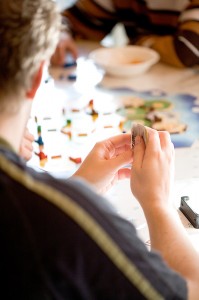
Set-up the other pieces of the board, including houses around the board.
Finally, figure out who will “go” first. Each player spins the spinner, and the highest number is the first to move.
Game of Life Rules
The first player spins the wheel and moves their car that number of spaces. Move the car following the directions on the different squares on the board.
Moving clockwise, each player spins the wheel and follows the instructions. Play continues this way until each player has reached the end of the board. Technically, the player with the highest amount of cash at game’s end is the winner.
Game of Life Strategy
There’s not a ton of strategy to winning The Game of Life. Luck plays a big part in your progression through life, but so does wise use of your money.
Since the goal of the game is to win the most cash, all your decisions should be made with earning the most hard currency. That means buying insurance as often as you can (in case of disaster later), purchasing stock certificates to increase your cash flow later in the game, and making every decision with the almighty dollar in mind.
Any time you land on the Lucky Day spaces, go ahead and gamble for the larger payout. Your odds are 5 to 1 against winning, but if you land on all the Lucky Day spaces, you have a good chance of winning at least once.
The Game of Life is popular for families and among younger children. Not exactly a strategic game, the Game of Life is more of a “time killer” than a really in-depth board game.
How to Play Monopoly
How to Play Monopoly
Parker Brothers classic real estate board game is the most popular board game in history. Millions of copies of Monopoly have been sold since the game first appeared in 1935. Based on neighborhoods the game’s inventor was familiar with from his summers spent on the Jersey shore, Monopoly involves buying and selling commercial and residential real estate.
The game is iconic in every sense. The design of the game has stayed true to the original, though alternate versions of the game appeared nearly as soon as the original. You can still buy the “classic” Monopoly played by people since the time of the second World War.
There’s lots of amazing facts about Monopoly, including the fact that over $100 trillion in Monopoly money is printed every year. For a game with such an interesting history, Monopoly is still evolving, releasing new versions with significant changes to game play on a yearly basis.
Rules
The standard game of Monopoly is full of rules–for a complete breakdown of Monopoly rules, you need to read the instructions that came with the game.
Further confusing people trying to learn to play the game is the fact that “house rules” are not just tolerated by actually encouraged by the game’s manufacturer. Your house rules are likely very different from my own, but probably include bonus amounts for different players (using the Free Parking and Go spaces) and rules about buying, selling, and auctioning properties.
Here’s a general look at the rules of Monopoly.
Players take turns rolling dice and moving clockwise around the board. Depending on what square you land on, you could draw a card, buy a piece of property, pay rent, or any number of house rules outcomes.
If a player doesn’t buy a property, the bank auctions it to the highest bidder. If the property you land on is already owned and unmortgaged, you have to pay the owner a specific amount of rent.
Players who roll doubles must rolls again after finishing a turn. Three sets of doubles in a row land the player in jail.
During a turn, players have the chance to develop the properties.
Players move around the board collecting rent from other players as return on their property investments. The winner is the player who either has the most money after a specific period of time or the last player to go bankrupt.
Instructions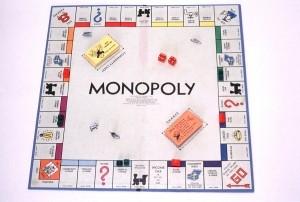
Setting up the Monopoly board is easy. Each player selects a token to represent themselves. You pile the Community Chest cards in one spot, Chance cards in their spot, and get ready to hand out cash.
The player who will act as the bank should hand out the cash. House rules on cash amounts vary, but the game board calls for $1,500 split up like so:
Two $500
Four $100
One $50
One $20
Two $10
One $5
Five $1
Strategy
The most commonly used Monopoly strategy is to buy up or trade for all the orange properties. That’s because they are the most commonly landed-on properties, thanks in part to the Chance cards “Go to Jail”, “Advance to St. Charles Place”, “Advance to Reading Railroad” and “Go Back Three Spaces”. Placing a hotel and a bunch of houses on the orange properties nearly guarantees you a win.
Though they’re cheap and easy to develop, avoid the two purple properties after the Go space, “Baltic” and “Mediterranean”. They are the two least landed-on spots on the entire board.
Monopoly has been hugely popular since the game appeared nearly 90 years ago. Every home should have a copy of Monopoly–if nothing else, look into modern variations of the game which attempt to bring the put the simple joy of Monopoly in the hands of people who may not otherwise be interested.
How to Play Canasta
How to Play Canasta
The goal of the game of Canasta is to score more points than your opponent by making melds or “canastas.” The almighty Canasta is a card meld made up of seven cards of the same rank.
Canasta Instructions
Deal 15 cards to each player. Then both players take turns drawing one card from the stock and then discarding one card on the discard pile.
After a player draws a card, they can start to form “melds” if they want to. Cards get melded in columns of at least three–you can form melds of Kings or Fives or whatever. Three Fives in a row is a meld, as if four. Sequential melds don’t exist, so don’t try melding “four-five-six”. Once a card is formed into a meld, it cannot be drawn back into your hand. Discard ends a round of play.
You can choose to take the entire discard pile instead of the face-up card, but only if you can instantly meld the top card.
A hand of Canasta ends when one of the players has no cards left in their hand, or when there are no cards left on the stock pile. Players then compute their score, and begin dealing a new hand. A player can only go “out” when they have at least one Canasta. An entire Canasta match is over when one player reaches 5,000 points.
Canasta Rules
There are lots of specific Canasta rules about melding that have to be picked up as you learn the game. For instance, no game of Canasta is allowed to start with a red three or a wild card. These rules are different from game to game, and picking them up is a matter of repetition.
Canasta Points
Here are the point values for scoring in Canasta.
Fours, Fives, Sixes, Sevens, and Black Threes are worth 5 points.
Eights, Nines, Tens, Jacks, Queens, and Kings are worth 10 points.
Deuces and Aces are worth 20 points.
Jokers are worth 50 points.
Red Threes are worth 100 points.
Canasta Bonuses
“Mixed” canastas are worth different bonuses than other Canastas. If a canasta has no wild cards, it is considered natural. If it has some wildcards it is considered mixed. “Mixed” canastas are worth 300 points, “natural” canastas are worth500 points, and a canasta made of nothing but “wild cards” is worth a huge 1,000 points.
The player that first “goes out” earns a bonus of 100 points.
If a player plays all four Red Threes on the table, their score of 400 points is automatically doubled to 800 points.
Canasta Strategy
The most important part of Canasta strategy is basic hand management. That’s why Canasta is a great way to learn more complex games like Bridge. This means known when to hang on to certain cards and when to lay them down to form melds. Because you only draw one card (and discard one card) at a time, managing your hand is super important.
Balancing your melds is important as well. This means not playing a ton of melds as fast as possible, but playing enough to score more than your opponent. This skill really just comes with Canasta experience.
Canasta is not as popular now as it once was, but for fans of heavily strategic card games, it is a great introduction to basic strategy for meld-making games. Difficult to learn and sometimes hard to find a group to play with, Canasta has great rewards for patient card game fans.
How to Play Rummy 500
How to Play Rummy 500
It is important to learn the different kinds of sequences that are in play in Rummy 500. They are typical card game sequences–three of a kind, three consecutive, etc. You can also build on other players sequences to get rid of cards and score points. This is called “playing off” and is an important part of game play and strateg.
Rummy 500 Instructions
Rummy 500 uses an entire deck of cards. You can play Rummy 500 with between two and five players. The goal of Rummy 500 is to be the first player to score 500 points.
You score points in Rummy 500 by playing cards. Different cards and sequences have different values.
Rummy 500 Points
Any cards you play in a round of Rummy 500 is worth a certain number of points.
Next, you count the score of the cards remaining in your hand. Subtract the score of the cards remaining from the score of your cards played total. After you subtract, you have your final score.
Cards numbered 2 through 9 are worth 5 points.
10s, Jacks, Queens, and Kings are worth 10 points.
Aces are worth 15 points unless the ace is part of a suit with a 2 and a 3, in which case it plays the part of a numbered card, and is only worth 5 points.
If an Ace is placed off in a sequence, it is also only worth 5 points.
Your final score can be positive or negative. Negative scores are subtracted from a player’s overall score.
The first person to reach 500 or more points, wins the game. If two people reach 500 during the same hand, the player with the highest score total is the winner.
Rummy 500 Rules
Deal seven cards to each player.
Undealt cards are placed face down on the table for the stock pile. Flip the top stock card face up and start a stack next to the face down card.
Each player takes a turn, either drawing the top card from the stock pile or picking up cards from the discard pile.
That player can then play any of the other cards in his hand that make legal sequences.
Play ends by discarding. Discards have to be made face up so other players have a shot at them. Picked up cards can either be played in a series or among a series that already exists on the table.
A hand of Rummy 500 is finished when the first player discards their final card.
Scores are counted up and added to the previous score totals.
Rummy 500 Strategy
The most commonly used strategy trick in Rummy 500 is to pick up a large stack of cards from the discard pile to form multiple melds and sequences. You can really rack up a lot of points by doing this, if you can go out early enough to not have those cards count too badly against you.
Another great trick is to avoid playing Ace, 2, 3 sequences in favor of using the Ace as a much more valuable part of a face card sequence. By using your Aces when they’re worth triple points, you get to the final score of 500 faster.
Rummy 500 is a popular variation of Rummy that takes little concentration. It’s a great game for playing with drinks or at parties, as you can easily have conversations around the table as you play.
How to Play Euchre
How to Play Euchre
Euchre is a fast paced “trump” game that takes just a second to learn. Trump games are popular all over the world, and since Euchre only requires four players, it is an easy game to play with little set-up.
Euchre, pronounced YOO-kerr, is the game that gave our modern deck of playing cards the Joker. In the traditional American version of Euchre, the wild cards are suited Jacks, and not Joker cards. But in the game as it was originally played, Jokers were wild.
Euchre Instructions
You win a game of Euchre by being the first team to score 10 points.
A Euchre deck is made up of 24 cards — all four nines, tens, Jacks, Queens, Kings, and Aces. This simplifies game play, making up just six different ranks in four different suits. Modern games of Euchre use a standard poker deck with the Jokers and twos through eights removed.
Cards are dealt two or three at a time to all players. The deal moves from left to right until all four players have five cards. This leaves four cards undealt.
The top card of the undealt four cards is shown face-up as a “proposed trump.” The actual trump is decided during bidding.
If the first bidder wants to make the proposed trump the actual trump, he says “Pick it up” to the dealer. The dealer then must pick up this card and get rid of a card from his hand. The other option is to say “pass” and the trump decision must then be made by the next player. Any time a player says “Pick it up”, the bidding is over and the game begins.
Euchre Rules
The team who declares the trump suit has to win at least the majority of tricks to “score”. The majority of tricks means winning at least three.
The team that makes the trump are known as the “makers.” If the makers don’t earn three tricks at least, they’ll lose their bid and score for the other team. Being set is known as being “Euchred”.
Non-trump suits are ranked normally–Aces high then King, Queen, Jack, on down to nine which is the lowest rank. Often the strongest card is the trump-suited Jack, known “Left Bower.” The second highest trump card is the Jack of the same color but a different suit — he’s called the “Left Bower”.
Euchre Strategy
Teams can score two points by winning all five tricks. Winning all five tricks is called a “march”. Euchring a team, meaning you cause them not to meet their bid, scores two points as well. Since it is much easier to set your opponent than it is to go on the march, Euchre is easier to win with good defense than with good offense.
You should consider going “alone” as often as you can in an attempt to score the most points possible in Euchre. Going alone is difficult–it involves playing against both opponents with your hand without the help of your partner–but it is worth four points if you win all five tricks.
Euchre is an easy bidding game that you can learn in a single hand. Euchre is a card game based on defensive strategy, and can teach basic bidding and trick winning strategy. Luck has a hand in the game, as the deal plays a big role in how you play, but a little luck combined with a little strategy makes for fun card gaming.
How to Play Stratego
How to Play Stratego
Stratego is one of those “easy to learn, hard to master” board games that are always popular for a certain segment of the gaming population. Variations of Stratego exist for different brands, things like Lord of the Rings, Star Wars, and Simpsons. Though Stratego is not as popular as it once was, the complex strategy involved in this war game mean it will always have a special place in the world of board games.
Most of the learning part of learning to play Stratego involves simply learning about the different pieces. There are twelve different “units” in the game of Stratego with different properties. They range from the “flag” piece that is the object of the game and doesn’t move to the higher units like the Marshal and the Generals. Learn how each piece moves and how they’re used and you’ve got the basics of Stratego.
Stratego Rules
You start play when you move your pieces in such a way that they interact with your opponent’s pieces. In a conflict, the highest ranking piece always beats the lower ranking piece. Bombs always win unless they are diffused by a miner piece. The spy piece always wins when it attacks, no matter the rank of the other piece. The only piece that doesn’t get killed by the spy is the marshal.
Battle continues until one player located and “captures” the other player’s flag piece. You look for the flag piece by moving through your opponent’s pieces and revealing which space is occupied by which piece.
Stratego Strategy
The strategy of Stratego lies in how to set-up your pieces. For instance, surrounding your flag with bombs will make it harder for the opponent to capture your flag. Only the miner piece can defuse bombs.
The spy piece is crucial to your success in Stratego, so learning to use the spy means learning to win. Avoid placing your spy too close to the front line, because your spy will be captured before it does its job. The trick lies in placing the spy piece exactly far back enough to be protected, but close enough to the line to get him in position later in the game.
Another great strategic trick in Stratego is to use “misdirection.” You can “fake” a flag location by sticking two bombs in one of the back corners protecting some useless pawn piece. Your opponent will think your flag is protected by bombs and go after it.
Stratego Instructions
To start a game of Stratego, each player chooses a color or side of the board and starts to set-up their pieces.
Each piece needs to be set-up on your side of the board. The two lake spots on the board are there to “bottleneck” the front line, so use that bottlenecking to your advantage.
Stratego may have fallen a bit by the wayside in light of the rising popularity of more obscure classic games like Carcassone and modern games like Tikal, but the basic strategy you learn playing this classic board game will help you in other strategy-based games. Want to be a better chess player? Learn to play Stratego.
Popular Family Games
Popular Family Games
While just about any board game can be enjoyed by the whole family, some games are just classic “family” oriented games. In general, that means they’re good for a wide range of ages and players.
Here’s the five most popular family games.
5. Boggle
Though Boggle is described as being “for 2 or more players”, we’ve found that more than five or six makes the game very difficult. Boggle is listed as being for ages “8 and up”, though you may find that many children younger than 8 are perfectly capable of playing.
In Boggle, players compete with each other to find as many words as possible in a 4×4 grid of jumbled letters. There’s a three minute time limit, after which point totals are added up based on the number of words you’ve found. The only words that count at words that the other players didn’t find.
Boggle is a fast-paced “word game”, and the easy game play and quick setup make it a repeat play for many families.

4. Chutes and Ladders
This is a pretty boring game, especially for people above the age of six. Unfortunately, it is also most kid’s favorite game when they are younger. The reason this appeals to families is because kids demand to play it. They understand the simple way you play the game, they’re drawn to the colors and the drawings, and once kids win a few rounds of this simple “progression” game, they’ll want to play again and again.
Many different versions of Chutes and Ladders exist, but they’re all pretty much the same. Buy this one for the kids, but try to get them into Monopoly as soon as you can.
3. Checkers
Checkers boards are as easy to find as 7-11s. You can buy checkers and chess sets at retail pharmacies, big box stores, and even travel versions at gas stations and truck stops. Checkers is popular because almost everyone knows how to play, and because kids and adults alike both love to “jump” the opponent, form Kings, and dominate a Checkers board.
Part strategy game (similar in many ways to Chess) and part “capture” game, Checkers is playable as young as five years old and is a game the whole family can agree on.
2. Jenga
Jenga is a simple board game involving player’s using their fingers to gently draw blocks out of a pre-fabricated structure. A strange board game, in that it involves more physical and less intellectual skill, Jenga appeals to kids because of the dramatic way in which the Jenga blocks fall to the ground. Older people like Jenga, too–it turns out that there’s plenty of strategy in removing Jenga blocks.
1. Clue
When I was a kid, Clue was my family’s main board game. If you grew up in the 80s, your family may have been the same. Clue is one of the earliest “simulation” type games in which you pretend to be something you’re not, in this case, a detective investigating a murder. The board is unique–a layout of an old mansion complete with secret passageways and murder weapons. Clue is playable as young as 8, and “junior” versions exist if the game is still a bit too “grown up” for your kids.
Popular Card Games
Popular Card Games
Games that use cards instead of boards or other items are called “card games.” This word refers to everything from poker and blackjack to Old Maid and Spit in the Ocean. Card games are as varied as board games, with games for all ages and skill levels.
Here are the five most popular card games, ranked in order of number of players.
5. Spades
Down South, it isn’t a get-together until someone pulls out a deck of cards and starts dealing a game of Spades. Spades is technically a variation of bridge, a simpler version with a shorter duration. There are endless variations of Spades, including the popular “jailhouse rules” which penalize sandbagging, a tactic by which players underbid intentionally. Spades is a game of the middle and lower class in America, but a game that most people know how to play.
4. Whist
Whether you think of Whist as “poor man’s Bridge” or not, you have to admit that it is incredibly popular. There was a time in the 20th century when Whist was the game young people played–these days, it has an older audience. A typical Bridge variation involving bidding and trick-taking, Whist is popular because it is easy to play while distracted.
3. Hearts
Professional poker players are Hearts fanatics, getting together in secret to bet piles of cash on the game. The game of Hearts involves matching and double-crossing, though it isn’t a “bidding” game, making it one of the few really popular card games that don’t involve bidding. Hearts is as much about screwing the guy across the table from you as it is about playing the right card at the right time. A very “social” game, Hearts is a standard inclusion on pre-fabricated computers, pointing to its widespread popularity.

2. Texas Hold’em
Yes, Texas Hold’em exploded in popularity over the last ten or fifteen years. Even without the recent Hold’em drama, the story of Texas Hold’em is a unique story in card gaming. First thought up (and eventually popularized by) poker sharks in Texas, Hold’em is the most popular poker variation. Since the game of poker is one of the most popular card games in the world, it could be said that Texas Hold’em is the most popular card game in the world. The standard card game of the World Series of Poker, Texas Hold’em is the gold standard for card game variations.
1. Bridge
This game is popular everywhere in the world. I wouldn’t be surprised to find Martians playing Bridge.
Bridge is a contract bidding game, and inspired dozens of game variations that themselves became popular card games. You can still find Bridge strategy in the newspaper and all over the Internet. Wherever card games are played, you’ll find a Bridge game gathering. Considered by many to be the hardest card game in the world, Bridge is constantly adding to its massive fanbase, spreading from one generation to another.
Card games have been around for hundreds of years, and even though we’re living in the age of the Internet, when everything is instant and online, physical card games are still very popular.
Popular Board Games
Popular Board Games
Ask any anthropologist–board games have been around pretty much as long as human civilization. Whether we’re talking about the simple game “Go” (played as early as 300 BC) or the more complex modern games like “Settlers of Catan”, board games are popular because they’re fun, they allow for playful competition, and your whole family or group of friends can play together.
Here are the five most popular board games listed by total number of games sold.
5. Risk
Though not as popular now as it was thirty or forty years ago, the game Risk is the classic world domination board game. Though multiple versions of Risk exist, the classic game can take hours or even multiple gaming sessions to complete, and maybe it is this complexity that is hurting the game’s popularity.
4. Scrabble
Though many people think of Scrabble as a “word game”, it is really a game of mathematics and strategy. That’s why mathematic brains almost always beat “word people” at a round of Scrabble.
Played with two to four players, and having inspired an almost religious following among board game fans, Scrabble is enjoying a surge in popularity thanks to new versions of the game and a couple of documentaries centering on Scrabble players.
3. Checkers
Sometimes called “poor man’s chess”, checkers doesn’t get the kind of respect it deserves. The simple game of checkers is nearly as complex as chess, and there are endless variations of checkers to be found online and in gaming books. There are tournaments in checkers, both in America and around the world.
What seems like a simple game of “capture” is full of strategy, and long nights have been punctuated by murmurs of “King me” for hundreds of years.

2. Chess
It is difficult to track the sales numbers for games of chess–unlike Monopoly or many other board games, chess boards are manufactured by thousands of different companies. But this game’s popularity can’t be denied. Tournament chess, school chess teams, and the presence of chess in our popular culture establish this as one of the most popular board games in the world.
1. Monopoly
The best-selling board game of all time is still the “go to” board game for many people. Since the game appeared in 1935, more than 80,000,000 units have been sold. Parker Brothers prints more than 181 trillion dollars in Monopoly money every year, more than the total of real money that exists in the world.
Monopoly is unique for two reasons. First of all, it’s a real estate game. Secondly, there are many different versions of Monopoly to choose from. This year saw the release of “U Build Monopoly”, a version in which the game’s board is a little different every time you play.
Board games will always be popular because they bring people together. If you’re looking for a way to kill a few hours, or want to take your friends on in some serious competition, pick up one of these classic board games.
How to Prepare for Your First Child
No other event in your life – not marriage, not a new job, not even a month-long vacation to Switzerland – will alter your life as much as your first child. From sleep and work to exercise and running errands, babies will rock your world. Just how can a nine-pound bundle change so much in the course of a day?
Consider your pre-baby routine as it stands now. When you and your spouse want to see a 9:00 movie, you head out and do it. Need a haircut? Make an appointment and go. And when you’re super tired after a long week the Saturday sleep-in is non-negotiable. Newborns have a different idea on how your life should run. They need to eat every three hours. Around the clock. They get fantastically fussy just when your hands are full preparing dinner. And after weeks of getting up at night, when you feel a deep tired ache down to your bones, desperately needing a night (not a day, not a week, but just a single night) off, babies pick that night to randomly wake up at odd hours. Which means you’re up too.
But lest you swear off the whole ordeal, understand that bringing children into the world is a supremely important task. Life as we know it ends without babies. Children simply illuminate how selfish we are with our time. No article or blog can prepare you for that realization, which lies at the core of why babies are so difficult. You’ll simply have to run through the fire knowing that billions of others have done the same and survived. There are, however, a few ways to prepare for selfless giving that break the ice a bit and prepare your current routine for baby.
Select a list of reliable babysitters.

How to Prepare for Your First Child
You will need time away from the baby with your husband. Repeat eight times. Then repeat again. Even as early as a month after delivering, you both need to spend time as a couple, because that’s who you were first. When Junior grows up and hits the road, you don’t go with him. And if you have a ridiculous notion that as long as you stay with your spouse through the child’s early years and then split when he goes to college, you failed as both parent and spouse. The last day of your marriage is more important than the first. So get the sitters lined up and keep dating! Make sure your babysitters (especially for a newborn) are older and have CPR training.
Define “help” to extended visitors.
Don’t wait until birthing recovery (which is amazingly painful and lingering) to let your family know the best way to support you when baby gets home. Define it clearly for your mother-in-law or it will be the most miserable week of your life. The best advice I got was to tell people staying with me to help with cooking, cleaning, and other house stuff so I could relax with our new baby.
Organize your house and keep it clean.
Don’t be insane about it but having a place for everything in your home will make life so much easier when baby arrives. The only thing worse than sleep deprivation is sleep deprivation in a pigsty. Cut the cable to hire a maid if you can’t seem to get it done yourself. Routines for housework are great. I always unload the dishwasher in the morning and stick dirty dishes and utensils in it throughout the day before running it at night. Laundry is done during three days each week. I alternate cleaning the carpet and tile every other day so it stays relatively clean. If you’ve worked until the baby comes this will be a great transition to being homebound for a while. You might be tempted to think the house will stay clean because you’re “at home all day to do it”. Good luck with that.
Find friends with kids and help them out.
Your schedule is wide-open right now, whether you know it or not. Get some buddies who are a bit further along on the journey and soak up any information you can from them. Volunteer to change diapers, feed their little Princess, or just clean house. It becomes immeasurably harder to help each other out after your baby comes, so use your enormous amounts of time and be an extra hand to another new mom. You’ll also get a good refresher on baby care.
Practice 3-minute showers.
I always put my first in the swing in our bathroom while I took a rapid fast shower, since I preferred to nap when she did. While it was a bit over-stimulating to her, it worked out for us in those early weeks. Gone are the days of 20-minute showers followed by half an hour to primp. Even if you make the time to do it when hubby gets home you have other things to worry about. You still need to take a shower and look presentable, but just do the basics.
Play with your new baby equipment.
Open and shut the stroller. Do the same with your play yard. Stock up on all sorts of rechargeable batteries and have them ready for the annoying toys Aunt Mildred gives to you. Practice installing your car seat, removing the infant carrier and lifting the handle up and down. Even stick a baby doll in it! Making these routine things automatic will remove some of the stress after delivery.
Arrange once-a-week help from a friend.
This is different from getting date-night help. Once-a-week help can be from your mom, cousin, or someone else with a young baby. This is your time to get a haircut, grocery shop, or take a long nap if you need it.
Don’t buy a bunch of stuff. Especially not blankets.
Unless you just moved or truly have no friends you will be bestowed with more unnecessary frills than you could hope for. The pint-sized snuggly crib animals and homemade blankets will come out of the woodwork. Plus it’s easier to buy things you know you and your family need. A solid percentage of baby junk is just that. Wait a couple weeks before blowing your wad. And when it comes time to buy baby stuff, buy used or use coupons to save money on a purchase that is likely only going to last a few months before it’s grown out of.
Read two or three baby books, but no more.
The best way to find good baby books is to watch other moms whose children respect them and behave. Then ask them if they would recommend anything that helped them. Most of the literature on the subject of babies is completely contradictory and will drive you insane if you take it at face value. Observe other moms and get the scoop directly from them. Authors and folks with letters after their names don’t know you, your child, nor your unique circumstances.
Stop working early, if you can.
The shift from full-time work to full-time baby is immensely tough. To stop work a couple days before birth and then transition to the home immediately is too much stress, even though many women make that same path. I’m convinced that lack of mental, emotional, and physical preparation for such a life change contributes to post-partum stress. Stop a few weeks early and get your mind set on this meaningful yet daunting shift. You need time to talk with your spouse and outline your new responsibilities.
Avoid intentional sleep deprivation.
Most pregnant women have a tough time sleeping anyway. But there’s no need to “get in the routine” of up every 3 hours. Get your rest now and get to bed early to prepare for the labor marathon and ensuing weeks of sleeplessness. It’s really not that bad. You get to spend time nursing or bottle-feeding your little one. That time is so limited and precious that you’ll eventually miss doing it.
If you’re like I was before children, the thought of giving up every inch of myself for a baby terrified me. Each part of the daily routine is turned over on its head to make way for an infant. What I didn’t expect was the accompanying feeling of acceptance through all of it. We can’t head out with our kid-less friends until midnight. Or eat dinner without having to jump up a dozen times. We cherish things like singing kid songs, going to bed early, and reviewing pictures of the new bundle. But neither of us mind that change. The desire for the things we used to do is gone and we don’t miss it.
How to Become a Teacher
How to Become a Teacher
The old adage, “Those who can’t do, teach.” is a load of crap. As a fourth generation teacher (my great-great-grandmother taught Arithmetic in the early part of the 20th century) I can promise you that a teacher does more work and earns greater rewards than any other occupation.
If you’re wondering how to become a teacher, follow these steps:
Forget everything you’ve heard. There have never been more routes to becoming a teacher than there are now. As the population increases and the demand for teachers grows, so do the methods of becoming a teacher. You used to have to go to a teacher’s college or normal school to learn how to become a teacher, but there are now alternative and emergency certifications and plain old bachelor’s degrees. Because every state has different requirements for earning a teacher’s certificate, your own means of becoming an educator may differ from the plan outlined below. But most people in America will find these baby steps useful in their pursuit of a career in education.
The Process of Becoming an Educator
The process of becoming a teacher can start in many ways. You can enroll in a certificate program at an accredited university (even some online programs offer teacher certification courses) or look for “alternative methods” for teacher certification. Both traditional and alternative teacher certification programs are designed in such a way that you can get your certification or degree while you work another job. It’s common for teacher’s certification courses to take place at night or on the weekends.
Once you finish your degree or certification program, you’ll have to pass a test (called Praxis) to determine your academic abilities, skill at education, and the extent of your knowledge in your area of certification. Once you pass the Praxis tests and complete your certification program, you can apply for the physical teaching certificate from the state in which you want to be certified. When you are granted your teaching certificate, you’re free to apply for teaching jobs wherever your teaching certificate is recognized.

How to Become a Teacher
Public schools require one of these certificates, but many private schools are willing to hire teachers without certification. The difference is often your pay rate — private schools often save money by paying teachers less than public schools, although this isn’t always the case. Even if you want to teach at a private school, a certificate could help you earn more money, get jobs more easily, and make your employer more comfortable with your abilities as a teacher.
Examples of Teacher Requirements by State
In California, the state that boasts the highest average teacher salaries in the country, there are several “incentive” programs to convince people to enroll in teacher certification courses. There’s no one answer to the question of “how to become a teacher in California” — in fact, California has been recognized for its teacher certification programs. BTSA (Beginning Teacher Support and Assessment) is a state-funded teacher induction program that helps newly credentialed teachers in finding and keeping work.
The state of Illinois (with a low cost of living and a relatively high compensation rate for its teachers) is one of a handful of states in the country that will honor just about any state’s teacher certificates. The state of Illinois is also one of just a few states that automatically recognizes people who have completed necessary coursework for teacher certification and automatically recommends the state grant them a license. Because of the low cost of living and the state’s willingness to recognize other state’s certificates, Illinois is one of the most “teacher friendly” states in the country.
Though the state of Mississippi has one of the lowest starting salaries in the country for teachers (less than $29,000), they are ranked number one in terms of giving raises, with teachers earning over an average 50% raise in the first ten years of their careers. Wondering how to become a teacher in Mississippi? Thanks to one of the country’s worst job performance records in the recent past, the state’s teacher certification requirements have gotten tougher in recent years. If you want to teach in Mississippi, you’d do well to earn a teaching certificate at the college level, and those prospective teachers with Master’s degrees will find it that much easier to get work.
Benefits of Teaching – It’s Not Just about the Money
Depending on what part of the country you teach in, the money alone could be enough to draw you toward a career in education. In California, for example, the average teacher’s salary is around $60,000, with an average of a 50% raise over ten years.
Some states compensate their teachers far less. South Dakota’s average teacher salary is almost half of California’s, at just $34,000.
Aside from salary, teacher’s unions across the country fight hard for their members, providing good pensions and health insurance benefits long after retirement.
There are more benefits to being a teacher than a paycheck. No joy in the world compares to seeing a student grasp a concept right in front of your eyes.
Once you’ve been a teacher for a few decades, you may find yourself teaching the children of your former students, or even the grandchildren. Seeing generations of a single family through their formative years is a benefit unto itself.
Don’t forget summer — unless you teach in a year round education district, teaching offers you a couple of months’ worth of built in vacation during your students’ summer break. But many teachers find themselves tutoring or working other jobs during their time off, either to make ends meet or keep themselves busy.
If you or someone you know wants to know how to become a teacher, take encouragement from the fact that educators will always have work. A teaching certificate is the perfect fall back option for any other career, any many people who burn out at other jobs find themselves gravitating towards a career as a teacher. If you’re looking for a career with rewards beyond your bank account, consider becoming a teacher.
Resources
- Hipteacher
- Open Directory: Reference: Education: K through 12: Educators: New and Prospective Teachers
- Yahoo Directory: Teacher Education
How to Get a Baby Sitting Job
How to Get a Baby Sitting Job
Knowing how to get a baby sitting job can be a good way to make extra cash. The more families you baby sit for, the more money you can make.
To be a good babysitter, you need to be reliable, punctual, organized, safety conscious, mature, and trustworthy. You also need to have people skills . (That’s what is required when dealing with unruly or needy children.) Being fun, firm and patient is a good start toward having those people skills.
Baby Sitter Qualifications
No hard and fast rules or state laws affect babysitters, but most parents want to hand their children over to an older youth. You should probably be 12 years old or older to babysit. Having a babysitter training certificate is even better.
Babysitting Courses and Classes
You can find informal babysitting instruction courses by looking at the bulletin boards at your school or local YMCA. Carry a pen and paper with you so that you can write down this information. Many modern parents prefer to hire babysitters who have some type of babysitting instruction or education behind them, so take advantage of these courses if you can, especially if you have no previous babysitting experience.
Getting a job baby sitting the neighbor’s kids is the easiest way to get started. Family members are another good place to find potential baby sitting clients. Depending on where you live and how large your family is, you might be able to get all the babysitting gigs you can handle. But if you need to broaden your pool of potential clients, you should definitely have some child care courses under your belt. Having lots of options enables you to pick and choose which kids you get along with. And you can prioritize the parents who pay more for the babysitting services you provide, too.
Baby sitting and child care classes are usually easier to find in the spring and early summer.

How to Get a Baby Sitting Job
How to Get a Babysitter Job
The first step is to get the word out that you’re in the market for babysitting gigs. Babysitting and informal nanny jobs are best found via word of mouth. (So you needn’t put together a resume.) Ask your parents to tell their friends that you are now a baby sitter and that you are ready to sit their children for money.
You should also tell any babysitters you know to consider you as a “backup babysitter.” You can create a network of contacts so that you’ll have steady work as a babysitter.
But be sure to get your parents’ permission before advertising yourself for babysitting jobs.
Baby Sitting Job Specifics
It’s a good idea to set limits on your babysitting. Stipulate exactly what times in the day or week you are available, how many kids you can babysit at once, and what age groups you’ll sit for.
Keep the following questions and their answers in mind when you’re looking at prospective babysitting clients:
- How Many Children Do You Babysit at Once?
- What Age Groups Do You Babysit? Babies? Toddlers? Tweens?
- How Late Are You Available to Babysit?
- Are You Available on Weekends?
- How Many Hours Will You Work at One Time?
- Is This a Only a Summer Job?
- Do You Babysit Problem Children?
Don’t be so restrictive when you’re answering these questions that you’re useless to potential customers. But you do want to leave time to get your homework done. And you have family responsibilities and extracurricular activities to think about too. Keep your parents’ curfew in mind too.
Many parents need babysitters when they go out at night or on the weekends. Part of being a babysitter is giving parents time to have a social life, so this can sometimes impede on your social life. But that’s why you’re getting paid. You’re trading your time for your clients’ money.
Safety Issues
Once you get a baby sitting job, you’re going to have responsibility for one or more children, so learn some basic babysitting safety.
Safety Checklist
- Emergency Numbers
- First Aid Kid
- Smoke Detector & Fire Extinguisher
- Emergency Exits
- Fire Escape Plan
- Swimming Pool Safety Policy (if applicable)
- Child’s Medical Background (Allergies, Medications, Conditions)
- Family’s Internet Access Policies
- Family’s TV Watching Policies
Handling Emergency Numbers
When writing down emergency numbers, get the mom and dad’s full names, the dad’s phone number, the mom’s phone number, an emergency contact for the next nearest relative, and a phone number for a trusted neighbor. Also make sure you know the major emergency phone numbers, such as 911, the Police Department, the Fire Department, Poison Control, the Family Doctor, and the preferred hospital.
Print up a sheet of paper with a line beside each of these items, then have one of the parents fill these out when you arrive. If they seem to be in too much of a hurry, have them point you to their list of emergency numbers. Program these into your cell phone if you need to.
Media Access
Some families have strict Internet access and television watching policies. Find out what your clients’ rules are for television and Internet usage in advance.
How to Become a Nanny
Becoming a baby sitter is good preparation if you later want to become a nanny. Being a nanny is way more involved than being a babysitter, but if you find that you enjoy spending time with children, you might be a good nanny candidate.
Nannies spend more time with children, seeing to their basic needs and instructing them in basic life skills. A nanny needs to know first aid and household medical skills, and a nanny needs to know how to cook. Nanny instruction courses can make you better qualified to become a nanny. And being better qualified almost always means making more money.
Getting a nanny job is more like getting any other job. You’ll need a resume with a list of your appropriate experience and education, and you may need a certificate. Unlike most babysitting jobs for teens, a nanny might have to undergo a routine background check.
Getting Your First Baby Sitting Job
Getting your first baby sitting job is a big responsibility. Being a babysitter means that you’re being entrusted with a parent’s most precious thing in the world, so work hard to be worthy of that responsibility. Good babysitters are hard to find, so if you’re dependable, you’ll be in demand.
Resources
- Open Directory: Kids and Teens: Teen Life: Babysitting
- Open Directory: Kids and Teens: Teen Life: Babysitting: Courses
- Open Directory: Kids and Teens: Teen Life: Safety Tips
How to Become an Actor or Actress
How to Become an Actor or Actress
Being a world famous entertainer is a glamorous dream. If you want to learn how to become an actor or actress, you’re going to need patience, perseverance, and the ability to take criticism. Most people in the acting profession wait years for their big break, going to endless auditions and improving their ability to act. Persevering doesn’t guarantee that you’ll become a big star, but it does mean you’ll give yourself a chance.
You’ll need certain skills to become an actor or actress. You’ll also need to take certain steps to move forward in the profession. These skills and steps comprise the traditional path to becoming a Hollywood, Broadway, or television actor.
Move to Los Angeles or New York City
You won’t be “discovered” in Peoria. People need to move to the places where the jobs are in their field. Acting jobs are found in New York and Los Angeles, so if you want to become an actor or actress, that’s where you need to be.
If you don’t want to move to one of these two cities, your chance of getting a job becomes much lower. You might become a skilled stage actor in a local theater, or enjoy a hobby as an amateur actor or actress in community theater, but you’re not going to become a big time celebrity or Hollywood star. If have no interest in living in Manhattan or LA, that’s all right. But you won’t become a successful film actor.
Take Acting Classes
Join a drama club or take a drama class. Be on stage performing and get whatever instruction you can. Learn the craft and decide whether or not you enjoy being in front of an audience.

How to Become an Actor
Successful actors and actresses improve their acting ability their entire lives. While models, singers, athletes, and celebrities of all types might get acting jobs, if you’re none of those things, improving your ability to act is your ticket to the big time.
Find a good class and an acting instructor you trust. Learn your trade.
Get a Head Shot
A head shot is a photo you include with your resume. Producers are looking for people with the right look for a part, so your head shot tells them if you have the look.
Before having your head shot taken, get your hair styled by a professional.
To become a famous actor, it helps to be attractive and have nice features, especially if you’re female. But even if you aren’t, there are jobs in television and movies that need an unorthodox look or an everyday kind of attractiveness. Character actors are often the most-skilled actors on the set.
Build a Resume
Start building a resume of the acting work you’ve done. Get in front of an audience or camera any chance that you can, so that you have something to put on your resume. Do school plays, commercials, and anything else you can.
Once you start to build up your list of acting accomplishments, drop the less impressive performances off your resume. This way your resume is constantly improving.
Contact Agents & Casting Directors
Write a brief cover letter, then send your head shot, resume, and cover letter to the casting directors and agents in the city. Follow up with an update every 4-6 months of your current projects.
Getting an agent is important, because they can help you network for jobs. Do your homework and sign with a reputable agent. A good agent will be able to advise you on which acting gigs are realistic and which acting gigs will help your career move forward.
Getting an agent and sending your resume and head shot around gets you in the game. A producer might not think you’re right for their current project, but that doesn’t mean you won’t be perfect for their next production.
Read the Trade Papers
The trade papers let you know what’s being casts and where to send your head shots. Read the trade papers all the time, no matter how depressing your lack of current work might get. Keep your eye on the prize. Most actors didn’t become famous overnight.
The trade papers you need to read include Variety, Backstage, The Ross Reports and Dramalogue. Finding online trade publications that keep you updated too. Any publication that gives you the names and mailing addresses of relevant producers and directors should be among your reading material.
Network the Entertainment Scene
Accept invitations to any industry events or industry parties you’re invited to. Entertainment is a who you know business. Networking and meeting new business contacts is essential.
Even if these people may not be on top of the world, almost everyone at these industry parties is ambitious. A few have big talent. You never know when one of these people will become the next big actor, director or producer. Make friends with everyone and avoid making enemies.
Get Ready for Disappointment
Read a few Hollywood biographies to see how long some people faced disappointment and rejection. Actors and actresses talk all the time about the dozens and dozens of auditions where they read and never got the callback. That’s the nature of the business.
Keep persevering, keep networking, keep improving, and you might just get your big break. The acting profession is one of the most highly competitive fields in the world. Who doesn’t want to be a movie star?
Keep Your Head in the Game
If what you’re doing doesn’t seem to be working, take more classes and improve your craft. Stay at it in the gym and don’t get out of shape. Look at everything you do as a way to further your acting career.
Resources
- The New York Conservatory for Dramatic Arts: Industry Tips: The Ins and Outs of the Acting Business
- Open Directory: Arts: Performing Arts: Acting: Actors and Actresses
- Open Directory: Arts: Performing Arts: Acting: Actors and Actresses: Databases and Casting Services
- Open Directory: Arts: Performing Arts: Acting: Education
How to Draw Anime
Anime is a fantasy style of art invented in Japan but loved the world over. Anime and manga are both known for “big eyes and small mouths.” Learning how to draw anime means learning the principles of anime sketching, then starting to sketch your own favorite characters in the Japanimation industry. When you’ve gained a certain amount of competence in the craft of drawing anime and manga characters, you can try your hand at creating your own.
What Is Anime?
Manga is a type of Japanese comic book published in serials by manga studios. These comic books read from right to left. Manga books are more mainstream in Japan than comic books are in the United States, and adults find little social stigma in reading manga titles.
Anime are animated cartoon movies which are often based on popular manga. Book length light novels are also converted into anime and manga, if they’re popular enough. Anime movies have certain conventions that don’t appear in American cartoon animation, such as a lower frame rate and different artistic styles. For people in North America, the terms “anime” and “manga” are synonymous, and when people talk about drawing anime, they mean drawing manga characters.
How to Draw Manga
Get an 18×24 drawing pad or portable sketchbook, a pencil sharpener, several 4H to 6B drawing pencils, a kneaded eraser, a nylon eraser, a blending stump and black ink pens of various weights.
Sketch basic shapes to get used to your drawing instruments. Draw cubes, cones and spheres.
Look at how others draw anime. Study the lines used in these sketched pictures.
Starting an Anime Sketch
Drawing boys and girls in anime style requires getting people’s proportions and shapes right, first. Then you use a slightly different than realistic head to body ratio for smaller children. Draw eyes large and round and set them lower down the face than you would a normal human’s eyes, without eyelashes. This gives them a more innocent appearance.
Use tiny circle for the mouth and nose, while showing ears on a boy’s head. Make the feet larger in relation to his body than normal.
For older boys, make the face more angular in appearance. The eyes should be smaller and almond shaped instead of round. Add no eyelashes for older boys, but make the nose and mouth more defined.
The body of boys in manga or anime tend to be longer and thinner, so elongate the body. Consider a 1-to-8 ratio on the head to body for older boys.
Drawing Manga and Anime Girls
Girls should have round heads with large rounded eyes. Like young boys, a manga girls’ eyes should be further down the head. The bigger the eyes in proportion to the head, the younger the character looks.
For anime females, you want the hair to cover the ears. Use a 2-to-1 ratio for her head. The body should be short and be twice the height of the head, which should give a rounded look to a little girl.
For older girls, draw smaller eyes and add eyelashes. Her mouth should be enlarged, while her face should be more angular. Give her either longer hair or a more stylish look, while lengthening her body. At its maximum, the head to body ratio should be 1-to-8.
Making Anime

How to Draw Anime
For drawing anime, you’ll need a few extra tools. Buy a registration system, which keeps you paper in alignment when sketching and re-sketching. Buy sturdy animation paper, a light table, and non-photo blue or carmine red erasable color pencils.
Install Video Editing Software
Add video editing capability by installing Adobe Premiere for PCs or iMovie for your Mac. Consider what you’re going to do for audio taping, and buy sound-mixing software appropriate to what you want.
Brainstorm
Get a story idea. For your first anime story, make it small and quick. Don’t get too ambitious to start, or you’ll frustrate yourself. Choose a story with one character with one goal and a few obstacles. You can write your epic with a cast of thousands and dozens of plot twists after you’ve gotten some more experience in the craft.
Write a script. Don’t write 1-hour and 30-minute screenplay, but something you can put on video in a limited amount of time.
Draw a Storyboard
Draw a storyboard. This is a comic book style blueprint of your anime. It’s comparable to a rough manga version of the finished anime.
Scan the Storyboard
Scan the storyboard panels into your video editor. Record a soundtrack to fit with your scanned images, then sync these sounds on the video editor at a pace of 24 frames per second.
That means a lot of pictures, and it’s going to look like a slideshow to begin with. Keep producing new anime pictures, making liberal use of your registration system.
Produce Model Sheets
When producing your animation, you want visual references for each character. These are different poses and facial expressions from a wide variety of angles. This means you’re going to be drawing your characters over and over again, streamlining their look.
Work on Backgrounds and Setting
If you want to get a little more detailed and advanced, consider adding backgrounds and foreground items. Use your image editor to see how different color backgrounds look.
Produce Layouts
Layouts are precise and accurate storyboards. This is getting closer to the finished product. Once you have these, splice these into your animatic device and sync them with your soundtrack.
Once you have the rough layout, finish the job by editing out needless shots and story points. You want as little edited out as possible, since this represents a lot of work. Still, if the final product has slow moments or superfluous material, it’s better to edit it.
Drawing Anime – Suggested Reading
As you can see, drawing anime to be turned into a short movie is a lot of work. Big anime studios go a step further to add “main animation’, along with extra detailed work on color and ink.
If you want further instructions in how to draw anime cartoons and manga characters, consider buying a “How to Draw Manga & Anime” book at the local bookstore, such as Hikaru Hayashi’s How to Draw Manga (this one’s available in multiple volumes) or How to Draw Anime & Game Characters by Todashi Ozawa. Most decent size bookstores these days have a whole assortment of books that help, with step by step instructions.
Resources
How to Install a Dishwasher
Doing it yourself doesn’t require the services of a contractor, so save money on your next home installation by learning how to install a dishwasher yourself. While dish washer installation isn’t hard, there are one or two safety steps to keep in mind.
Turn off the Utilities
Turn off the circuit break that controls power to your kitchen, so no electricity is throwing through the sockets you’re going to be working around. Electricity safety is key when installing new household appliances.
Next, turn off the water main flowing into your house and kitchen. You should find this in your yard somewhere. Also, shut off the hot water pipe underneath your sink, to make sure residual hot water doesn’t link into your work area. Make sure any standing water or pipe water is removed before you begin.
Remove Your Old Dishwasher
Assuming you have an old dishwasher in your kitchen, unscrew clamps or screws that are holding the dishwashing appliance in place. Disconnect any pipes or electrical cords that are attached from your appliance to the kitchen.
Remove your old dishwasher with the help of a friend. The dishwasher is heavy enough that one person doesn’t need to try manipulating it alone.
Inspect the Dishwasher Space
Now that you have the old dishwasher out of the way, inspect the empty space and learn what you have available to you. Learn where the holes for cords and pipes run, and the best way to reattach an appliance. You should have holes in your cabinet running to your sink drain and from your water supply, as well as a hole for a power cord. Drill holes if none exist.
Install a Dishwasher Air Cap
Remove the hole plug with a quick hammer punch. This shouldn’t take too much trouble. Once this is done, install the air hose and air gap underneath the sink, setting them in place with slip joint pliers and a locknut. Make sure the air gap cover faces towards the sink drain.
Installing the Dishwasher
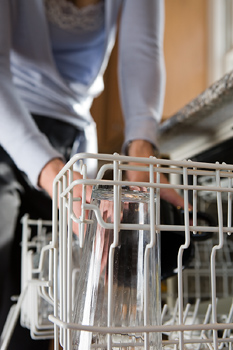
How to Install a Dishwasher
Next, move the new dishwasher in the vicinity of your dishwasher hole, leaving enough room to maneuver. Attack water supply tubes through the aforementioned holes. Position the dishwasher in its place without pinching any connectors.
Attach electrical cords through the protective sleeve, then attach the wires by color. Attach the ground wire, which should be green (that is, green wire to green wire). Attach the white wire with white wire, then the black wire with black wire. Once this is done, plug the electric cord into the wall socket.
Connect Water Supply
Attach the water supply tube from the sink to your valve. Look for the flexible looking tube, then attach it to the valve’s second outlet. Secure the tube by tightening with a wrench.
Clamp the Short Drain Hose
The short drain hose is going to connect to the garbage disposal, if you have one, as well as the large outlet on the air gap. Pinch clamps on both ends of the shorter drain hosing, then do the same with the long drain hose, which should go on the drain outlet at the bottom of the new dishwasher appliance.
Check Your Work
Before you shove the dishwasher fully into your cabinet nook, make certain every connection is tight and the wiring and washer fits. Align the dishwasher with the countertop and your cabinets, to make sure everything looks nice and uniform.
Once this is done, make certain the dishwasher sets in place, by screwing the dishwasher into the counter. Turn on the circuit breaker and your water supply and run a cycle, to check for any leaks or other problems.
Installing a Dishwasher
Learning how to install a dishwasher from scratch doesn’t require electronic knowledge or handyman skills, but it’s a good idea to have your installation manual beside you as you work. Every new dishwasher should have an owners manual. If you have any other questions, don’t be afraid to ask the handiest person in your family, or even that neighbor who seems to know about handiwork.
Resources
- Hammerzone.com: Installing a New Dishwasher
- Open Directory: Home: Consumer Information: Appliances: Dishwashers
How to Repair a Denim Comforter
Denim comforters tend to be pretty durable, so learning how to make minor repairs on denim should let you keep the comforter in working shape for a long time. Here’s how to repair a denim comforter with minor sewing tips.
Search for Denim Fabric
Buy light or medium fabric, unless you have a heavy sewing machine. Heavy denim tends to be stiff, so it can gum up many home sewing machines.
Wash the Denim Comforter
Before making repair, consider washing the comforter to remove any residual stains on the fabric. Denim is tough enough to take multiple washes, so you might as well start with a fresh and clean comforter.
Check stains before you dry the denim comforter, though. If you have tough stains, it might pay to take your favorite comforter to the dry cleaners.
Pre-Washing Denim
Pre-wash the denim fabric, before you saw it onto your denim comforter. Treat this denim like it’s any other colored wash item. Dry your replacement denim the same way.
If the first wash doesn’t appear to do the trick, rewash some 2-3 times to soften your fabric, before patching.
Place Heavy Needle on Sewing Machine
 If you plan on sewing over thick denim seams on your comforter, place a heavy sewing needle onto the machine. This keeps you needle from bending or breaking while you patch the denim.
If you plan on sewing over thick denim seams on your comforter, place a heavy sewing needle onto the machine. This keeps you needle from bending or breaking while you patch the denim.
Cut Your Denim Patch
Cut the fabric with a pair of scissors. For especially heavy or difficult denim fabric, consider cutting one layer of denim at a time. Flip your pattern over to cut the second piece.
Sewing Your Blue Jeans Comforter
Once it comes time to sew, sew flat-felled seams, which are 3 stitch lines, with 2 securing multiple layers of fabric. Here’s how you sew a flat-felled seam.
Stitch a standard 5/8-inch seam with wrong sides together. Trim one side of the seam allowance to one-eighth of an inch. Next, press the seam allowance to one side, keeping the longer side on top.
Next, fold the untreated edge under your trimmed edge, then press it into place. Then saw a stitch line to close this fold.
Routine Repairs on a Denim Comforter
Sometimes, you may not need to make such radical repairs to your denim. Instead you can re-stitch seams that have pulled out with a sewing machine. In fact, you can use a fabric hoop to make small enough stitches to stick your denim comforter by hand.
Another option is to add bright patches you buy at the store, instead of similarly colored denim. If you have multiple holes to repair, this could give your comforter a whole new look. In either case, while you’re making repairs, check for weaknesses in the denim fabric, so you can add a reinforcing patch, to head off repairs at a later time.
Finally, check the edging all the way around your denim comforter. This is a common place for stitches to unravel, because this is the part of the blanket likely to drag across the floor as you carry it, so check and make any preventive maintenance to keep your denim comforter intact.
Repairing Denim Comforters
As you see, learning how to repair a denim comforter requires a little bit of sewing skill, but not too much. Be careful, if you aren’t used to sewing with a machine. Making sure you don’t hurt yourself is much more important than making sure you place a patch on your denim comforter.
How to Get Gum Out of Carpet
If you have kids around the place, it’s only a matter of time before you’ll have to figure out how to get gum out of carpet. Not all bubblegum is the same, and not all gum stains are the same, so I’ll give you several options for cleaning gum out of the living room floor carpet.
The important thing is that you don’t freak out: these things happen. Besides, it’s easy to step on gum in the grocery store parking lot and track it in, so you might be the culprit, after all.
Below are several methods for getting gum of your carpet. Keep trying them, until one works.
Freezing Gum
Freezing gum often works. Once you get gum cold enough, it starts to harden, making it much easier to separate from the carpet. There are several ways to apply freezing temperatures to gum-stained carpet.
One, get a bag of ice and hold it on the gum. Hold it yourself for a couple of minutes, or place the bag over the gum for 15-20 minutes. This should make the gum completely frozen, so it becomes a matter of peeling away the gum.
Two, get canned air like you use to clean your keyboard and spray it directly onto the gum. Compressed air, when it gets cold enough, makes gum brittle. Then it becomes a matter of breaking the gum and picking it off the carpet.
Use Peanut Butter in a Pinch

How to Get Gum Out of Carpet
Peanut butter is known to change the consistency of gum, so that it’s easier to remove from the carpet. This is a gross feeling, messy looking process, but it works in a pinch.
When you finish removing the gum, use a standard carpet cleaner to remove peanut butter from the carpet. Don’t use this method too often, because peanut butter can stain some carpets.
If there is remaining gum in the carpet after the peanut butter treatment, lighter fluid is known to get out small amounts of gum, by breaking it down. Don’t use lighter fluid near an open flame or heat of any kind. Use carpet cleaner to thoroughly remove lighter fluid.
Using Carpet Cleaners on Gum Stains
Use a spray-on stain cleaner that is specifically designed to remove carpet problems like old gum. There are several industrial strength or specialty carpet cleaners which are designed to get rid of tough stains.
Goo-Gone Spray-On is another alternative. Goo Gone advertises itself as eliminating “gooey, sticky, gummy, greasy problems”. A bottle costs around $7.
De-Solv-It and Orange-Sol are two more citrus-based products that rid your carpet of troublesome stains. Both are known to break down gum stains.
Steam Clean if Nothing Else Works
If nothing else has worked – and that’s pretty unlikely – rent a carpet steamer and remove the gum from your carpet with a steam cleaner. Use the recommended cleaning solution for the steamer you’re using, go over the trouble spot time and again, and these chemicals should remove the stain.
How to Remove Gum from Carpet
Still need more help with how to remove gum from carpet? If none of the above carpet cleaning methods have worked, that isn’t gum in your carpet: it’s an alien symbiote. You’re going to need to call in the space marines. Between the ice, peanut butter, lighter fluid, carpet cleaners, enzyme cleaners and steam treatment, something is going to break down that gum and get it out of your living room.
How to Play Craps
Learning how to play craps lets you play the cool game at the casino, where all the people who love the action go. Craps is also a social game and a betters game, because if you make the conventional bets, you and the people to the left and right of you are likely to be making the same bet. When all of you have money riding on the same proposition, it creates camaraderie.
Besides, the craps table is where people go to be seen on a casino floor. Sure, the poker table is full of characters trying to be cocky like Phil Hellmuth and or have their own “look” like Jesus Ferguson, but if you’re amidst a bunch of slot machines and blackjack tables, that big spectacle over at the craps table is going to stand out. It only helps that playing the dice is a lot more fun than counting cards or hitting the spin button.
Guide to Playing Craps
Some new casino gamblers shy away from the craps area, though, because all the casino staff huddled around and all the crazy looking bet options overwhelm them. Craps is easy to learn, though, so read this guide to playing craps and start playing craps at the casino.
Craps Basics
Craps is a dice game played at the casino. Craps players place bets by setting chips in various betting squares that have a variety of names. You’ve probably seen from tv and movies that, in craps, you want a 7 or 11 to start, but if you roll something besides a 7, you need that number again before those numbers come up again.
Rules of Craps
Learning how to play craps is mainly a matter of learning what all the various betting options are. While the names of the bets might sound difficult, they’re actually pretty simple, once you start to list them. After that, craps rules are about “what not to do”, which falls into the craps etiquette category.
With that in mind, let’s look at the craps bets.
Craps Betting
Pass Line Bet – This is the basic bet and the one you’ll probably make most of the time. You bet money on the “pass line” on the original roll, which is called the “come out” roll. When you see a black laminated market saying “off” on the table, you know it is a come out roll.
When the dice come out as 7 or 11, you win even-money. On a 2, 3 or 12, you lose your wager. Any other set of numbers – 4, 5, 6, 8, 9, 10 – is called “the point”. You’ll see the dealer turn the off button over to reveal “on”, and then set that button on a particular number. You and everyone who made the pass line bet know you need that number again, before another 7 is rolled.
The house edge on this wager is one of the least of all craps bets, which is why good gamblers make this wager most of the time.
Don’t Pass Bets – The Don’t Pass bet is the opposite of the Pass Line bet (almost). On come out roll, if you get a 2 or 3, you win. On a 7 or 11, you lose. That leaves the 12, which is a push, like every other total. In Lake Tahoe and Reno, the 12 is a win and the 2 is a push (no idea why).
When you place the “Don’t Pass Bet”, keep in mind you are betting against most of the other people at the table. For this reason, “Don’t Pass” betters are called “wrong betters”. It’s a bit of an unfriendly act and craps etiquette states you shouldn’t really play up these wins, jumping up and down and whatnot, when you get the win (and the rest of the craps players lose).

How to Play Craps
The house odds are slightly higher on the Don’t Pass Bet than the Pass Line Bet, so if you want to go with the odds always, bet on the Pass Line.
Come Bets – This is a bet for those who are tired of waiting for the point to be thrown. It’s like the Pass Line bet, but is made on any roll.
Don’t Come Bets – Like the Don’t Pass bet, but made on any roll.
Place Bets – You bet on a particular number to be rolled before 7. The odds tend to be much worse on these bets, especially 5, 9, 4 and 10. 6 and 8 are in the range of the Pass Line bet, but still are worse odds. Though “place bets” pay odds, they are considered sucker bets.
Buy Bets – Same concept as the place bets, where you buy a number to beat 7, but with different payouts. Once again, the house edge hovers around 5%, so these are a bad idea.
Big 6 and 8 Bets – Like place bets, except the payouts are different. The house edge is over 9% on the Big 6 & 8, so bad that it’s illegal for the casino to have these bets in Atlantic City. Las Vegas casinos often have other sucker bets, instead of these, on this part of the felt.
Hard Way Bets – You bet on the “hard way” to roll a positive number, before a 7 or that same number is rolled the easy way. For instance, the hard way to roll 4 is to roll two 2’s. The hard way to roll 6 is two 3’s; 8 is two 4’s; 10 is two 5’s.
Let’s assume you bet on a “hard 6”. The dice need to come up 3-3, before a 4-2, a 5-1 or any combination that makes 7 comes up. You get big payoffs on this bet, but the house edge is absolutely huge. In other words, don’t make the hard way bets.
Lay Bets – You bet the 7 comes up before one of the place numbers (4-6, 8-10). Because this is likely to happen, you give the house odds on this happening. If you want to win a lot, play this bet, but know your payback percentage won’t be the same as a pass line bet.
Put Bets – Pass line bet you make without going through the come-out roll. Casinos offer odds on these bets.
Proposition Bets – These bets are always resolved on the next throw of the dice. You bet on unlikely circumstances to happen, and get odds between 4-to-1 all the way to 33-to-1. Unfortunately, these have among the worst odds at the table, and most knowledgeable craps players never make prop bets.
Field Bets – The gambler bets on the next roll being a 2-4 or 9-12. The odds pays 1-to-1, though the 2 and 12 pays a little more in most places outside Las Vegas and Reno. Decent house edge.
Taking the Odds – After you have made a pass line bet, you can “take the odds” after the point has been made. You can usually bet a multiple of 3-5 times your original bet on taking the odds. This is an additional wager that the point is going to be rolled before 7. You win better than even money when this happens. This is a bet with no house edge (you heard right – no house edge).
Taking the odds doesn’t lower the expectation that you lose, but it does lower the house edge, all things accounted for.
Laying the Odds – The opposite of taking the odds, so you are betting that a 7 is rolled before the point.
Craps Etiquette
It’s essential that you understand craps etiquette if you plan to play at live games, especially in a casino setting. Be sure you follow these tips.
- Never use the word “seven” at the craps table, because it’s considered bad luck.
- When you throw the dice, bounce them off the side of the table.
- Don’t put drinks on the table.
- Don’t cheer when you win and others lose.
- Players take turns throwing dice, until they seven out. Pass the dice, if you don’t want to throw.
- Know the rules at busy tables, so dealers don’t have to help and slow down the game for everyone else.
- Don’t lean on the table. Don’t sit down. Stand up like a craps player would.
- Tips the dealers, especially helpful dealers. One way to make a bet is to place a Hard 8 bet and announce “boys” or “for the boys” – that is, for the dealer.
- Don’t point out people making sucker bets.
- Don’t jack with the dice before you throw them.
- Toss the dice – don’t literally throw them.
- Don’t use two hands when throwing the dice.
- Don’t place a bet after the shooter has the dice.
- Don’t whine and complain about everything. Negativity is bad.
- Don’t hold your drink over the craps table. You don’t want the bad blood that comes with spilling your drink on the table and causing it to stop down for repairs.
- Don’t tap cigar or cigarette ashes onto the felt.
- Respect other players’ superstitions. Craps players are notoriously superstitious, so don’t do something to foul up their superstition.
- Men shouldn’t announce this is their first time to play craps. Male craps virgins are considered unlucky.
- Women should announce this is their first time to play craps. Female craps virgins are considered lucky.
How to Get Rid of Underarm Stains on Shirts
You need several techniques for how to get rid of underarm stains on shirts, because there are certain things you can do for white clothing that you can’t do for color garments. Also, you’ll find yourself in all kinds of different situations, so you want to have several stain-fighting techniques at your disposal.
Most of the time, armpit stains appear on white t-shirts and other white apparel. That’s because the deodorant we use tend to build up a residue that isn’t always washed away in the washing machine. This especially shows up on white clothing, so we need a special cleaner to get rid of those ugly stains.
Read the stain removal tips below, to give you a number of options. Follow the directions to the letter, because some of the suggestions specifically warn against use on color clothes.
-

How to Get Rid of Underarm Stains on Shirts
Clorox
– Clorox is chlorine bleach, but it needs to be applied immediately after you get home from whatever put the sweat stains on your shirt. Only do this for white shirts and don’t use it too often, because it tends to wear out the garment faster. Chlorine bleach is also bad for the environment. Oxyclean works just the same. - Hydrogen Peroxide – Buy a 2-3% solution and put 1-2 teaspoons on the armpit stain in question. Rub the stain, let the solution sit, then add it to the wash. Once again, don’t add hydrogen peroxide to color clothes, as that’s going to ruin the garment about as quick.
- Clarsskin Underarm Cleanser – Clars Skin is a product marketed to help people get rid of shirt stains left over from deodorant. If you’re really serious, buy some Clarsskin Stain Remover.
- Baby Wipes – Believe it or not, baby wipes are known to get stains out of clothes, because they are alcohol-based cleaners. The great thing, they don’t hurt color clothes. The smell is going to be awful at first, but might be just the thing you need to get rid of tough underarm stains on shirts. These can help out on the town, though keep in mind you may have to deal with smells and crusty stuff.
- Borax – Boric acid also gets rid of stains. Mix the powder with water to make a paste. Rub the paste onto your shirt stains and let it sit for 30 minutes. Brush away the dried boric acid, then throw it in the wash.
- Enzyme Cleaners – Enzymes specifically designed to remove stains work like gang busters. Enzymes are proteins made from amino acids, and are most famous as the fluids that help humans and creatures digest food. Enzymatic cleaners get rid of the rough stains, so they should be able to get rid of armpit stains. Use as directed on the bottle.
Getting Rid of Underarm Stains on T-Shirts
One of the techniques for how to get rid of underarm stains on shirts we listed above should be able to help you with your problem. There’s nothing worse than just getting out of the shower and wearing a shirt right out of the washer, and looking like you have nasty armpit stains. This is not a way to impress the ladies, so learn how to get rid of underarm sweat stains and deodorant stains and never get caught in this situation again.
How to Cure Wood
When you are using wood on a building project, that wood almost always needs to be cured. Those who buy wood at the lumber store aren’t going to need to dry their wood, since the lumberyard has dried the wood already. But if you are using your own lumber, you’re going to know how to cure wood.
Wood Curing Techniques
First of all, “curing wood” is the process of drying wood out from its living, organic state. A tree is full of moisture in the form of water and sap. This moisture needs to be out of the wood, before it makes suitable building material. There are several wood curing techniques, however, this guide only covers the air drying method.
Air drying wood is the cheapest and easiest way to cure lumber, but this might take you a year (or perhaps even more) to dry out the wood properly. Drying the wood in a kiln is the other option, but this is a lot more involved. A kiln is a furnace used to either burn or dry various materials, such as bricks, porcelain or lumber (different kilns for each).
Collect Stickers
Stickers are pieces of wood cut to put between layers of stacked wood. This lets air flow past each stick of wood, making it dry out faster. Remember that stickers need to be the same wood type as the lumber you are curing.
You use stickers for air drying wood. They are simple 1×1 pieces of wood. Remember that certain species of wood need to dry out, before you turn it into lumber. Check on the Internet for information about your wood species, if there’s any doubt.
Lay Out Lumber to Dry
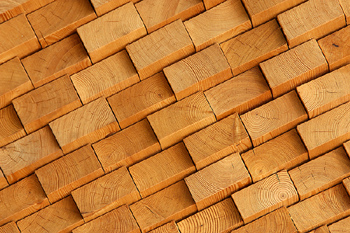
How to Cure Wood
Place logs on the ground in 8-ft long pattern. Make sure the base logs are same species of wood as the wood you’re curing, with these stacks about 3′ to 4′ apart, so it’s easier to pick them up later. Place freshly cut lumber on these logs, so they are not touching the ground.
Layer the logs as you stick by placing stickers between each layer. In this way, you can stack lumber up to shoulder level or so. Don’t go so high that stacking or unstacking risks strains, tears and pulls, or is otherwise troublesome.
Air Cured Wood
Let the open air dry out the wood by letting the lumber sit for several months. Buy a moisture meter and use this to determine the amount of moisture content in your wood. Check an online moisture chart for your wood species. Each species has a different optimal moisture level for building.
Store the Cured Wood
Once the wood is properly dried, place the logs in a ventilated barn where it can remain dry, until use. You don’t want moisture constantly on or near your wood, because the wood is going to reabsorb a great deal of moisture. Not only does this make it hard to work with, but moist wood is likely to become warped or moldy. Both of those are really bad for construction projects.
Go to the Local Sawmill
If open air wood curing doesn’t sound like it works for you, consider kiln-dried lumber. For this, you’re going to need access to a professionally built kiln.
Find a sawmill in the area and ask the sawmill owner is they have kilns available for drying private lumber. It costs between 40-60 cents per board foot to dry wood this way, but that tends to be the easiest way to cure your wood.
If the sawmill doesn’t offer kilns for individuals, ask them if they know of a local kiln. Sawmill owners tend to know the local scene.
How to Build a Toy Box
Most households with children have a problem with toy proliferation. Kids collect toys so quickly, that your house is likely to have action figures, dolls and toy vehicles laying everywhere. Learning how to build a toy box lets you store toys every night, while building a storage item that is sized to your living space.
Steps for Building Toy Boxes
We’ve outlined the steps for building toy boxes in the following passages. Be sure to pay attention to the measurements and sizes before you begin cutting.
Collect Toy Box Materials
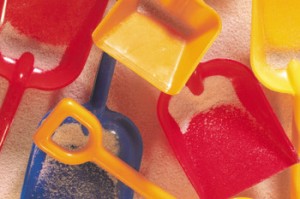
How to Build a Toy Box
Buy the wood supplies to build a toy box with. You want un-warped wood that is free of knots, which make nailing difficult, if not impossible.
Buy two 1×10 boards at four feet in length, one 1×8 board at six feet in length and one piece of 3/4th inch particle board or plywood. Also, you’ll need ten 2 & 1/2 inch double-wide corner braces, six 4-inch strap hinges and screws to fit each.
Other building supplies you’ll need are a square, a screwdriver, a saw, a jigsaw, a drill and bit set, a sander, sandpaper, wood glue and polyurethane.
Cut Lumber to Proper Size
Cut your wood supplies into the proper lengths for toy box construction. Cut each of the 4-foot 1×10 pieces of board into a 34 inch long piece and a 13 & 1/2 inch piece. This should give you 2 34-inch 1x10s and 2 13.5-inch 1x10s.
Cut lid pieces from your 6-foot length of 1×8. Cutting this piece should produce two 34 inch long lid pieces.
The particle board or plywood is going to act as the bottom of your toybox. Cut this into one 32 & 1/2 inch by 13 & 1/2 inch piece.
Sand the Wood Materials

How to Build a Toy Box
Now that you’ve cut your wood, sand the edges of the freshly-cut pieces to make them smooth. This is also the stage where you cut handles into the side pieces, by cutting a circle pattern in the side pieces. Cut these together, so both side are exactly equal in size.
Building the Toy Box
Place your bottom plywood piece on a level surface. Place the two side pieces onto the bottom of the toy box. Screw in corner braces for the back and front of the toy box, then add a corner brace at the top of these pieces.
Add the end pieces onto the toy box construction by attaching them to the corner brackets.
Building the Toy Box Lid
Next, place your 2 34-inch long lid pieces on the toybox. Make sure both are flush on the container. When these are flush, add your 3 flush hinges to both pieces spaced properly, then attach these hinges to the back of the toy box.
Adding Stain or Finish to the Toy Box
Add finish to the toy box. If comfortable doing so, disassemble the container and apply finish thoroughly, which should preserve the box better. Paint the hinges, if you want the box entirely the same color. Place finish on the inside of the toy box, too.
Toy Box Decoration
Consider adding decoration to the toil box. If you paint, add a coat of primer first. Two coats of paint is going to look better than one.
Also, consider adding your child’s name to the toy box. If you have multiple children, build a toy box for each, then stencil their names to their respective boxes. This gives them each a sense of possession and responsibility.
Add polyurethane when your finished with all staining, painting or other decoration.
Glue for Added Stability
Apply wood glue to your toy box, to give added stability. This way, your toy box isn’t rickety and unstable.
Building a Toy Box
Mastering how to build a toy box lets you add an inexpensive and practical component to your kids’ bedrooms. Once you perfect building your own toy boxes, you can even build them as gifts for the family and neighbors. If you never reach that point of carpentry skill, you can still have a practical toy container for your children’s toys.
How to Build a Fish Tank
One way to save money in this economy is to make those household items you would normally buy in a store, so learning how to build a fish tank keeps you from buying a store-bought fish storage tank. Another advantage is the ability to make a custom-made fish tank fitted to your room, while also making fish tanks as large as you wish.
Building a fish tank requires the proper materials, but these are going to cost a lot less separately than all together. What you need are five pieces of glass, silicon sealant, acetone, silicon carbide sandpaper, and several household items like duct tape and paper towels.
Determine Size of Fish Tank
Determine the size of your fish tank, which also tells you how thick the tank walls need to be. You don’t want to get this part wrong, or else your glass could shatter, leaving your fish dead, your carpet ruined and a huge mess of broken glass.
To calculate the glass thickness you need, use the chart provided as a guideline for the thickness of aquarium glass you need.
Order from the Glass Cutter
Find a local glass cutter and place an order for five pieces of glass. This includes the bottom, the back and front walls and the side walls of the aquarium. You should have your calculations ready, so ordering glass sides should be simple.
Sand the Rough Cut Glass
Use silicon carbide sand paper or emery cloth to sand down the glass edges of the glass you receive. Be careful transferring these glasses pieces from the glass cutter to your car, and from your car to your home. The edges are going to have a sharpness to them, which is a major reason why you’re going to want to sand them down.
Once this is done, mark the 5 pieces of glass as to which are going to be the bottom and the sides, using a simple felt-tipped market. Make certain you can later remove the black markings.
Building an Aquarium
Tear off roughly 15-20 five to six inch strips of duct tape, then touch them lightly to your work table, so you can use them later quickly and with ease. Start with the bottom piece of glass in your aquarium, with the inside of the fish tank facing up.
Use acetone around the edges of this glass piece. Acetone is a flammable organic compound that is the active ingredient in paint thinner and nail polish remover. You can use acetone to clean the surface of your glass, making it easier for the silicon sealant you’re about to apply to work.
Place Duct Tape on Aquarium Bottom
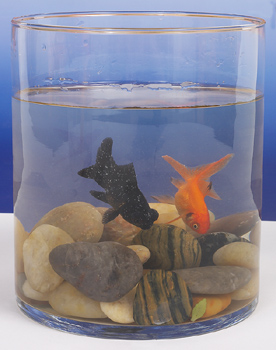
How to Build a Fish Tank
Fix 8 strips of duct tape to the bottom of your fish tank, so that enough of the tape is sticking out and up, that you can later affix it to the other pieces of glass. Place two strips on all four edges of the glass, equidistant apart.
The duct tape is going to keep your glass tight and secure while the sealant works to cement the glass sides together. Once the process is finished, you’ll take the duct tape off (that’s later, though).
Affix the Front to the Fish Tank
Take the front piece of the fish tank, determine which side you want to face out and spread a sealant bead along the length of the bottom of the aquarium, along the side you determined to be the front piece.
Collect the front piece of glass and press it firmly onto the silicon sealant. As you do this, take the two front pieces of duct tape and fix then to the front glass. This should help hold the front to the bottom of the fish tank, while the sealant works its magic.
Add the Sides to the Tank
Next, add sealant to the left side or the right side of the bottom glass – whichever you want to attach next. Follow the same step with both sides that you did with the front. Press firmly against the side, then fix duct tape to help the two glass pieces together.
Continue doing this for all four pieces of wall glass, doing the front, then the two sides, then the back wall of the fish tank. Once you perform this task, the form of your aquarium should come into shape.
Add Sealant to the Inner Lining
Now that you have the aquarium walls in place, add sealant to the inner lines of the fish tank. Do this with the inner lines where the four wall pieces connect to the bottom of the tank horizontally. Then do the same where the four walls connect to one another vertically.
You should now have sealant holding all the pieces of the aquarium together. The sealant is not only is what cement the fish tank, but holds water inside. Let the sealant dry for 24-36 hours before doing anything else with your fish tank.
Filling the Aquarium
After your sealant has dried, fill your fish tank with water. For the next 24 hours, check to see if there are any leaks forming along the joints of the fish tank. If no leaks appear, you have built your fish tank and it’s time to add fish, rocks and anything else to make your aquarium a pleasant and healthy environment for your fish, while making it striking for your guests.
Make Your Own Fish Tank
Learning how to build a fish tank may not give you a huge cost advantage over store-bought aquariums, but it does let you to custom build fish tanks to your home, office and surroundings. Understanding how to make your own fish tank also gives you the advantage of understanding basic fish tank repair.
How to Repair a Toilet
If you are a homeowner or landlord, learning how to repair a toilet yourself lets you save considerable money on toilet repairs. With a plunger or two and a screwdriver set, you have all you need to handle most toilet plumbing concerns. Commodes aren’t so complicated that you need a professional, most of the time.
Inspecting a Toilet
First, learn what is affecting your toilet. Remove the toilet lid and start to investigate. Start by inspecting the “ball cock”, which is the valve attached to the floating apparatus in the toilet tank. This should look like a plastic ball on the end of a long rod of some sort.
When inspecting the ball cock, check to see whether water is leaking from this valve. If so, then the ball cock needs to be either cleaned or replaced. Clean it first and, if this doesn’t work, replace this device.
Check the Tank Flap
The tank flap is a rubber cone which you can find in the bottom of the tank, fitting into the tank hole. Push on the tank flap and see whether this stop water from running. If so, then the tank flap isn’t covering the hole entirely and needs to be replaced. Take this piece off the toilet to the hardware store, to make certain you buy the right size.
Toilet Repairs – Turn off the Water
Once you have made your inspection and it’s time to make toilet repairs, turn the water flow off. There should be a metal twist valve on the piping between the toilet and the wall. Flush the toilet to remove as much water as possible from the commode.
Tank Flap Toilet Repairs

How to Repair a Toilet
As mentioned before, take the tank flap off the toilet assembly. This should be easy to remove. Use the broken flap to size the replacement, then replace with relative ease. Once finished, turn the water flow back on, replace the toilet lid and you have made repairs on your toilet.
Ball Cock Diaphragm Toilet Repairs
The ball-cock diaphragm is a little harder to replace than the tank flap, but it’s not that hard. Take the cover off the ball cock, then remove the screws that hold down the top plate of the device. You’ll need a screwdriver to perform this step.
Note that the float-control arm may be spring-loaded, so be careful when removing, to see essential parts don’t fall off and get lost.
Removing the Toilet Diaphragm
Next, remove the toilet diaphragm from the toilet, taking careful note to remember which side is the “up” side. Inspect the diaphragm to see whether there’s an obvious reason it’s broken, such as a small household objects or gravel lodged into the device.
After inspecting the toilet diaphragm, decide whether to clean or replace it. If cleaning doesn’t work, you’ll have to replace. All you have to do is to place the diaphragm where the old one sat, then screw in the top plate. Turn the water flow back on and you’re ready to go.
Repairing a Toilet
These are the basic steps to learning how to repair a toilet, but these tend to be the most common problems affecting a toilet. If repairs on the toilet system itself don’t work, you most likely have problems with plumbing in the wall and it’s time to call a plumber.
How to Buy and Sell Stocks and Bonds
Study the Difference in Stocks & Bonds
Learn the two major different types of capital investments in the market. There are a lot of other ways to invest your money, from CDs (certificates of deposit), equities, real estate, mutual funds and so on. But if you want to learn the basics of investment, start by studying how to buy and sell stocks and bonds.
- Stocks – A stock is a share in the ownership of a company. Each stock represents 1 unit of ownership interest. The value of that stock rises or falls, including past profits and future outlook. The trick to stocks is to buy low and sell high, though knowing what “high” and “low” is tricky. Some stocks pay a quarterly dividend, based on profits.
- Bonds – A bond is a loan made to a corporation, government or city. These are debt securities, where you are guaranteed a rate of interest on the loan, until the maturity date (When the loan is paid back).
Stocks and bonds are two quite different transactions, though most big dollar investors eventually diversify their portfolio over a range of the two. Stocks tend to be more volatile, but offer the greater lure of profits. Bonds tend to be safer investments, but have a fixed rate of interest (profit).
Don’t Follow One Guru

How to Buy and Sell Stocks and Bonds
When investing in stocks and bonds, don’t follow the advice of just one individual. Do your own research by reading numerous market experts and analyze the logic of their writing. Everyone has advice for playing the stock market and getting rich through investment, but it stands to reason that not all of them are right.
When investing in stocks, learn who the management of the company you’re investing in is, then learn about their experience. Read annual reports, then read quarterly reports. Read industry news and press releases from potential investments. Learn about this company’s major competition.
Once you study the market yourself, then compare this against what the experts and gurus are telling you. You should be able to see whether they make sense, once you can fill part of the role as your own investment advisor. If you say to yourself that you don’t have the time to learn the market this way, that’s true: find one small part of the market and learn it well.
Open a Brokerage Account
This how you start to buy and sell stocks and bonds. Once you start to understand the fundamentals of market investment, open an account with a brokerage that lets you buy and sell stocks, along with bonds. The general rule is: the more money you pay to a brokerage, the more work they do for you.
So if you want to hire a full-service broker who handles the research and investment angle of your portfolio, you’re going to end up paying higher commission fees. If you want brokers who simply execute the buy and sell orders without getting a lot of advice, hire a discount broker. These brokerages tend to release some of their investment research, but leave the thought process largely to you.
Buying and Selling Stocks & Bonds Online
You can hire an online brokerage and handle all of your money transactions over the Internet, if you want to. Research and choose the e-brokerage you like the most, such as eTrade, ScotTrade, OptionsXpress or TDAAmeritrade. Open an account, knowing you’ll need to apply and link to your bank account. You’ll need to include social security and personal information, so find a reputable online broker.
Once you have an online stock account, fund the account with a limited amount of funds. I suggest $500 to $2000 for beginning investors, and no more (unless you are a person of means). Don’t invest so much that a full loss hurts your future.
Now you have the tools to trade online. It’s a matter of making buy and sell orders and having your broker execute them on the trade floor. Learn the difference in a market order and a limit order and you’re ready to start investing.
Consider Investments in Mutual Funds
Mutual funds are a good place to start investing in the stock market. A mutual fund is a pool of money that invests in a wide range of investment opportunities, often from a particular industry or a particular type of stocks, bonds and other securities.
There are two advantages to a mutual fund, at least for the beginning investor. One, the fund is managed by an expert, who is handling the research and making the investments, so you are investing in this person’s expertise. Two, the investment is diversified, so the mutual fund is less likely to falter than stock in one single company; you’re already diversifying. Of course, the profits aren’t likely to be as great, either.
Buying and Selling Stocks and Bonds
It doesn’t take long to learn the basics of how to buy and sell stocks and bonds. Mastering the art of investment takes a lifetime of study and experience. That’s why I suggest you dip your foot into the pool at first, because you are going to be learning how to invest as you are putting your hard-earned money on the line.
How to Build Stairs for a Deck
Building stairs for a deck is a pretty simple procedure, once you’ve built a deck or patio. So far, we’ve covered “How to Build a Deck” and “How to Build a Patio”, but we’ve only brushed over the building of stairs. So to complete our series, here’s “How to Build Stairs for a Deck“.
This is going to be simple, in comparison to the rest of the project. Most of the time, you stairs are only going to require a few steps spaced out evenly, and are hardly the equivalent of building a staircase inside the home. Getting the incline right can be tricky, but in the case of a few steps, a few trial and error calculations should suffice. Learn what the “rise to run ratio” is, then build stairs according to an acceptable ratio.
What Is Rise to Run Ratio?
- Rise – The height between two steps on a staircase.
- Run – The depth of the step on a staircase. Also called the “tread”. Indicates how much room your foot has to step on.
The conventional approach is to make the run and the rise x2 (twice the rise) should equal between 24″ and 26″. So if the rise is 8 inches (x2 = 16), then the run should be 8-10 inches. If the rise is 10 inches (x2 = 20), then the run should be 4-6 inches (clearly unacceptable). You’ll quickly see the outer limits to what the rise should be, keeping in mind that the ideal tread path should be about ten to twelve inches.
Measure the Vertical Distance
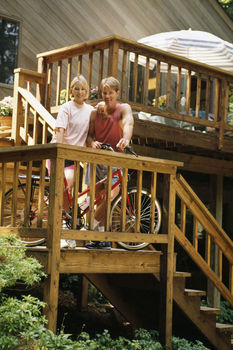
How to Build Stairs for a Deck
When preparing to build your staircase, first measure the vertical distance the stairs need to climb. A rough riser height is 7, so divide your vertical distance by 7, to give you the number of stairs you need. This is a rough number, since your rise isn’t likely to divide perfectly into 7.
Calculate the total run of the stairs by multiplying your tread depth by the number of stairs you have, minus one. The -1 is figured in, because the final step is your deck floor. When you get this calculation, you know how far out from the patio your staircase should start.
Measure the Stringers
The “stringers” are the up and down boards that support your treads, which rise and are nailed to your stairs. Imagine walking up the stairs and stubbing your toe as you do so – the stringer is what you would stub your toe again. Usually, a stringer is a piece of 2×12 lumber.
The stringer is important in measuring your overall rise from the ground to the deck. Using rise and run calculations, make your measurements and mark them along the stringer.
Cut Stringers – Set Stringers into Place
Next, using a hand saw or circular saw, cut the stringers out. Set these boards into place on your deck. Cut them to shape with a hand saw, adding a stringer every 16″ along the width of the stairway.
The bottom of the stringers should rest on a cement footing. This footing can be either a prefab cement slab or a poured cement base.
Install the Treads
Once you have the stringers on your stairs, add the treads to your staircase. The treads are the actual steps. The width of the steps should be easy to figure, since the stringers are already in place.
Screw the treads to the stringers by using galvanized decking screws, using 2×6 boards cut to the proper length.
Building Stairs for a Deck
Mastering how to build stairs for a deck has one or two tricky aspects, but after building a full deck or patio, this should be a pretty simple process in comparison. Be careful to calculate rise and run correctly, because you want to build steady and secure stairs, so people from 3 years to 83 years old can make it up the stairs.
How to Build a Log Cabin from Scratch
Those wanting to build a nice structure for camping and seclusion on your farmland or lakeside property can learn how to build a log cabin from scratch, creating a nice live-in residence for relatively cheap. If you pay a carpenter to do the same work, you’ll be out thousands of dollars.
Building log cabins from scratch is an elemental undertaking, which takes you back to the frontier days of America. There’s something quintessentially American about having your own simple log cabin in the woods, so instead of using a cabin kit, build your own frontier cabin from scratch. Like the frontiersmen who did so before you, you don’t have to have specialized skills to build your own cabin or lodge house.
Make a Log Cabin Design
Start your log cabin design by determining the outer dimensions of the lodge. Make this assessment based on the existing lumber supply, specifically the length of the available logs you have at your disposal. Log cabin kits come with a log cabin blueprints, so you can use that, if you have the plans or a friend who used a kit.
Find Log Cabin Real Estate
When finding the plot of land on which to build your log cabin, find land that is level, but which drains well. This means finding a strip of land that is slightly elevated from the land surrounding it, but which is level in and of itself.
You can choose land with underbrush, rocks and trees on it, though you’ll need to remove these impediments, if you do. Visualize the land without the obstructions, if you have trouble finding flat land that fits the bill, but isn’t covered with trees.
Prepare the Logs
Preparing logs for construction means you have to remove the bark and branches from the logs, as well as the knots. Once you have this cut, cut and shape the end of the logs to your specifications. Don’t prepare more log material than you need, because that’s both a lot of extra work and a drain on resources.
Consult your plans to know how many logs you need to prepare.
Digging the Post Holes – Know the Frost Line

How to Build a Log Cabin from Scratch
Learn the frost line for your region, so you can place postholes beneath the frost line. If you don’t, frost heaving can occur when the ground gets cold, moving the foundation of your log cabin and causing structural instability and damage. Most houses have the foundation and water lines underneath the frost line.
The frost line can change significantly from one region to the next. For instance, the frost line in the northern section of Minnesota is 5′, while it’s only 3.5′ in the southern sections.
Placing Log Posts – Log Cabin Foundation
Install your log posts in the holes, setting them in place with reinforced concrete. Next, add the main floor beams and joists in your log cabin. Once joists are in place, place playwood or wooden panels on top of them, to serve as the floor of your log cabin.
Prepare Logs for Wall Construction
You’ll build the walls of the log cabin next. When you get to this stage, cut notches in the logs, so the logs fit together and give the structure stability. These should fit together as snug as you can make them.
When building this section of your log home, leave spaces specifically for your doors and windows. Take this into account when preparing your logs beforehand.
Building a Second Story
To build a second story or supports for your roof, set loft supports at ceiling height. You’ll need to cut additional holes in the wall logs, if this is your intention.
Gables and Purlins
Build gables up to the height of the ridge pole, which is the highest portion of your cabin. Be careful when you building the center roof support structure, though, because this is the most dangerous section of the building project.
Purlins – Purlins are the structural support that cross the loft space of the log cabin.
Gables – The verticle part of the roof. Wall extensions that add support to the roof and building structure.
Roofing the Log Cabin
To build a roof on a log cabin, you need to frame out the roof. This process of determining gradient and pitch is not entirely different than what we told you about in “How to Build a Roof” (https://www.lifeguides.net/building/roof/), though a log cabin roof is more rudimentary than modern house roofs.
Frame out your log cabin roof using prepared lumber – not the standard logs you’ve used to this point. Use plywood to build the underside of your roof, while adding tin sheets on the top. You can buy tin sheeting at both your standard lumber yards and military surplus stores.
Install Windows, Chimneys and Stairs
Once you have the major components of your log cabin built, install the windows. Then built chimneys, doors and chimneys to the cabin.
Now that you have a log cabin built, it’s time to decorate the cabin. Bring in the wife or girlfriend to add a woman’s touch, or fit out your hunting lodge or summer cabin with fur carpets, hunting trophies and rugged outdoors relics.
Building Log Cabins from Scratch
Learning how to build a log cabin from scratch is more complicated than building a lodge from a log cabin kit, but you can regale your friends with all kinds of stories about the building process. If all of this sounds like a little too “backwoods” for you, buy a log cabin building kit and have your building supplies tailor made for you.
How to Build a Gazebo from Scratch
Discovering how to build a gazebo from scratch lets you add a centerpiece to your yard or garden, or a pavilion for a coming wedding or wedding reception. A gazebo not only gives you a practical choice to keep the sun off you in summer or precipitation of you the rest of the year.
A gazebo is an enclosed or open air structure, often octogonal in shapes, you can use for parties, dinners, snuggling or reading. Open air gazebos give you a breezy place to sit and visit, while closed gazebos allow you to be outside without having flies and gnats swarm you.
Place Your Gazebo
First, decide where your gazebo is going to sit. I mentioned earlier that a gazebo is a kind of centerpiece, which is something to consider when placing your gazebo. Gazebos are both something to be viewed and something to provide a view, so consider a space in the center of your property with plenty of room.
If your gazebo is raised and offers a nice view, this is even better. Consider local zoning laws and code regulations before selecting a spot for your gazebo, while choosing a place that is practical and offers visual impact.
Choose Materials
Garden gazebos might be made of wood, wrought iron or vinyl these days, so go through the list of potential gazebo building materials before deciding which to use. Also, consider whether you want raw wood or treated wood, if you choose wooden materials. Also consider whether you want to paint or stain the gazebo.
Gazebo roofs and windows need to be considered when collecting materials. Most gazebos have good roofs, while screens or windows have become popular choices in recent times. This is especially the case in areas where mosquitoes and flies swarm.
Building a Gazebo Kit
Many people buy gazebo kits when building a gazebo. Gazebo kits can cost between a few thousand and tens of thousands of dollars, so learning how to build a gazebo from scratch makes a lot of sense to households on a real budget. Gazebo kits can cost as much as you want it to cost, so only buy these if you have the money to afford them.
Gazebo Plans
Go online to find gazebo plans, if you want to build from a gazebo template. Building your own gazebo is labor intensive, so consider this before proceeding.
Building Gazebo Posts
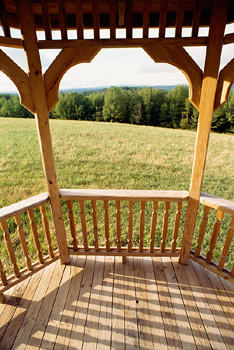
How to Build a Gazebo from Scratch
Place the gazebo posts in holes filled with premixed concrete. As always, understand the frost line in your area, so you know how deep to place your posts. Make certain your posts are level with each other, then brace the posts. When letting concrete to set, wait 24 hours before proceeding with construction.
Building the Gazebo Decks
Installing the gazebo deck requires you to connect planks with decking screws to the outer frame of the decks – that is, the board between posts. Use a level to make certain each plank is level.
Installing Joists
Your gazebo is likely to have a center deck post. Add joist hangers to the center deck posts, then add joists between the centerpost and the outside planks.
Make sure each joist is level with each other. Screw joists into the frame planks you set down earlier. Once you have the joists in place, add cross supports between them.
Gazebo Floors
Once you have the joists and their braces built, you can build the gazebo deck floor by nailing planks to the joists. Make sure the floor is level every step of the way.
How to Build a Gazebo Roof
Measure the distance from post to post across the diameter of the gazebo octagon. Your gazebo rafters should be half this length (or the length of the radius). Install cap plates to the top of all your posts, in preparation of adding rafters.
Add two opposite rafters with nails to the central hub of the gazebo. Once you do this, you have a truss.
Lift the Truss into Position
Use ropes to lift the truss to the top of the gazebo, positioning the truss in place by nailing it into the cap plates. You’re going to need assistants to help you with this step. Attach the other rafters with similar methods.
Once finished, add fascia board of one sort or another to the end of the rafters. This gives the roof a finished quality, while also protecting the roof and gazebo interior from whether damage.
Gazebo Roofing – Tongue and Groove Sheathing
Climb onto the top of the gazebo (testing first for sturdiness) and add tongue & groove sheeting on top of the rafters. This sheathing should be stapled onto the roofing felt. Using short roofing nails, add asphalt roofing shingles from bottom to top, one row at a time.
Gazebo Railing
Add rail sections to your ground posts with screws. Add a staircase of some sort. Once you have this finished, you have finished your gazebo.
Building a Gazebo from Scratch
Now you know how to build a gazebo from scratch. Gazebos take several stages of building, as you can see, but you don’t have to have professional carpentry skills to build your own gazebo.
How to Crochet
Learning how to crochet isn’t that hard, at least when you’re talking about basic crochet stitches. Learn basic crotcheting techniques to get started and see whether you want to learn more advanced crochet stitches.
What Is the Difference in Crocheting and Knitting?
Knitting uses two pointed needles to make patterns, while crocheting uses one hooked needle with a hook on the end. Crocheting requires hooking loops and pulling them through stitches, while knitting works several knits or loops across one needle. The debate about which is more useful – knitting or crocheting – is a debate that still rages between the two camps.
Crochet Stitch Patterns
Let’s discuss the four basic crotchet stitch patterns: the chain stitch, the single stitch, the double stitch and the slip stitch. Learning these crocheting methods lets you master the basics of crochet.
Chain Stitch
The chain stitch is the basic crotchet stitch, that you need to know to begin crotcheting. Right-handed crotcheters should hold the knitting hook in their right hand, looping yarn under the left index finger. Hold the knot between your ring finger and thumb of your left hand.
Wrap your yarn back to front around the shaft, using your hook to manipulate it. Once you draw the yarn you’ve wrapped through the loop of the aforementioned hook, you have made a stitch.
Counting Stitches

How to Crochet
The first stitch you make should not be counted among the knots. Otherwise, count stitches and continue until your pattern tells you to stop. Once you reach this limit, use a slip stitch to connect the ends to form a circle.
Making Slip Stitches
Connect the ends of your crotcheting together, which should form the crochet circle. Put your hook through the first chain stitch you made, while holding the yarn firmly and drawing the hook all the way through the two stitches made to form a circle.
Practicing Slip Stitches
Practice the slip stitch before you try to crochet a finished piece. Do this by stitching a foundation chain of roughly fifteen stitches. Insert your hook into the next stitch, then yarn over. Draw yarn through the stitch and loop, which should make one slip stitch, but still leave a loop on your hook.
Single Crochet Stitches
You’ll also want to make a single crochet stitch, inserting the hook from the front to the back in the center of the second chain away from the hook. This should place two loops on your hook.
The yarn over technique is when you wrap yard from the back to the front around your hook, then bringing the yarn through the pair of loops you have on the hook. Continue with this move until you have the full crocheting row finished.
Double Crochet Stitches
Now that you know the single crochet stitch, it’s time to learn the double-stitch in crochet. Place the yarn on your hook once. Then place your hook into the center of the chain by inserting it from back to front. Draw the yarn over, then through the 2 loops on your hook.
That’s all there is to the double crochet.
Learning How to Crochet
Learning how to crochet is learning how to perform the basic crochet knits. Once you master the basic loops and knits, then learn how to finish a series of knits, you’ll have mastered the basics of crocheting. Master what I’ve discussed above, then move on to the more advanced crochet techniques.
How to Build Kitchen Cabinets from Scratch
Once you learn how to build kitchen cabinets from scratch, you can save thousands of dollars on home improvements and design work. Building cabinets isn’t nearly as hard to do as roofing and other home ownership projects, so you can do this yourself, with the proper planning.
Graph Out Your Kitchen Space
Use graph paper to make a rough sketch of your kitchen. Build the sketch at 1/6th scale, so that each inch on the blueprint equals 6 inches on your kitchen floor. This scale isn’t set in stone: 1/8th or 1/10th scale work just as well.
Choose Cabinet Materials
Once you have a rough sketch, create kitchen cabinets on paper, playing around with the type cabinets you want, then deciding on cabinets you can afford.
Choose Cabinet Finish
Next, select a finish to put on your cabinets. If you have to stretch a budget, choose the more expensive material for the upper cabinets, instead of floor cabinets, because the higher cabinets draw the eye more than the lower ones.
Select Your Kitchen Design
Select your kitchen layout depending on what kind of cooking you do. If you cook a lot and have a little space, add an island to your kitchen. This gives you a bigger work table to do you cooking on.
Islands also give you extra cabinet space, because you can add cabinets to one side of the island or another. Find a place for a pantry, if you need a lot of storage space. Hallways work, if you don’t have enough cabinet space in the kitchen.
Measure the Cabinet Interior
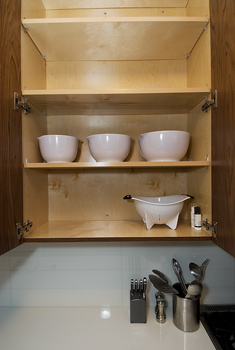
How to Build Kitchen Cabinets from Scratch
Determine the interior of your cabinet by measuring width and depth. If you are replacing old shelves, measure the width of the old shelves, so the thickness of the replacements match.
Cut shelves to the dimensions you measured. Use a table saw to do this, though you have the option of purchasing pre-cut shelves.
Place Brackets
Mark where you’re going to place brackets. Each shelf needs two brackets on each end, as well as 1 bracket along the back side of the shelf. Remember to use a level to make sure the brackets are level.
Drill holes for each bracket, then screw brackets into the holes. Once you do this, lay the shelf on the brackets and fix them into place. Add cabinet doors if you already had doors on the cabinet. If not, here’s how to build cabinet doors.
Cabinet Door Materials
If you want smooth doors with no designs, use 1/2 inch plywood for your doors. If you want carving or other designs on your cabinet doors, use 3/4 inch playwood for your project. Measure the length and width you need for kitchen cabinets, so you know exactly how much material you need.
Building Kitchen Cabinet Doors
Now that you have the materials, cut out your kitchen cabinet doors by transferring measurements to the plywood, then cutting out the form of each door.
Sand rough edges off the door. Add stain or paint, then let dry before attaching. In other words, do all the detail work on your cabinet doors at this point.
Attaching Cabinet Doors
Using 3/8th inch screws to attack hinges on either side of each door, mounted onto the cabinet. Hang the cabinet doors on the hinges at the appropriate position.
Think about where the best place for your door handle before attaching doors. For instance, lower cabinet doors need door handles high, while upper cabinet doors need handles low on the door face.
Building Kitchen Cabinets from Scratch
You can learn how to build cabinets from scratch by learning to build the cabinets in steps: planning the project, buying materials, building shelves and adding doors. None of these cabinet building steps is hard, though each involves precision work.
How to Draw Animals Step by Step
Drawing animals can be frustrating for beginning artists, because animals represent a huge variety of shapes, forms and features. Learning how to draw animals step by step requires learning a few basic concepts of animal anatomy. Eliminating these typical mistakes will improve your animal sketching skills rapidly.
Animal Studies
Before you get good at drawing animal sketches from memory, study pictures of the animals you want to draw. Study live animals any chance you get, too. You want to see how their anatomy works. Try to imagine them as broad shapes, which helps you when you start drawing animals from scratch.
How to Sketch Animals – Basic Shapes
When learning how to draw animals, first look at a photograph of the animal that you are going to draw. Start by sketching the basic outline of this animal, then draw the inner shapes of the creature. Don’t worry about details in the beginning.
Visualize the animal photo in an abstract way. Instead of visualizing an animal in the photo, imagine the animal to be simple geometric shapes like squares, circles and rectangles.
Connect the Shapes

How to Draw Animals Step by Step
Connect the basic animal shapes with lines, so the beast’s forms start to become noticeable. The lines you use here should be darker than the basic sketch lines, and they should start to dominate the picture. After you finish this step, the drawn animal should start to take shape.
Add Contrasts in Light and Darkness
Next, look at your photograph and notice the relative areas of darkness and light as they play on the animal’s form. Try to add these contracts to the sketch, getting the right amount of lightness, darkness and medium tones to the drawing.
Shade in the animal, not worrying about mimicking the animal’s features themselves. Once the shading is correct, you are closer to capturing a real image of this animal.
Drawing Details
Finally, once you have finished with the basic animal shape, connecting the animal’s outer lines and the basic shading of the animal, that’s when you should add details and animal features. Most beginning artists want to leap ahead to this stage of the depiction too early.
Instead, build the foundation of your animal drawing first, then getting more detailed as you go. When you draw an animal using this art method, you’re transferring the visual essence of the animal to the page or canvas, then filling in the details later.
Practice Drawing Animals
Remember to focus on the early steps of your animal drawings most. Once you start mastering this drawing technique, put a lot of time into sketching animals. Like any other skill, the more you practice the skill with the proper technique, the better of an artist you become. Mastering how to draw animals step by step, like everything else in this world, requires dedication and practice.
Resources
- Open Directory: Arts: Visual Arts: Drawing: Education
- Yahoo Directory: Visual Arts: Drawing and Sketching
How to Build a Closet in a Bedroom
If you have the floorspace, you can learn how to build a closet in a bedroom, adding much needed space to put clothes and other household items. Extra closet space adds value to your home and makes bedrooms a great deal more livable. You could say a private bed room without a closet is no bedroom at all.
Building a Bedroom Closet
First of all, determine whether you have the extra room to built a closet. There may be a reason why no closets were placed in a room, so see whether you have the footprint to place extra shelf space in your home.
Most rooms should have a little negative space to add a closet, if you’re willing to sacrifice a few feet in your private room. If that’s the case, then measure out a space for a closet. Use masking tape or a chalk line to mark your measurements on the floor.
Remove Baseboards – Remove Moldings
Remove the trim in that part of the room, by getting rid of the baseboards and moldings in the part of the room you’ll be building your closet. Remember to remove ceiling moldings in that corner of the room, too.
Remove Carpet in the Closet Space

How to Build a Closet in a Bedroom
In the part of the room you intend on building your closet, remove the carpeting behind the line you drew on the floor. If you want the closet to be carpeted, you can add carpet after you’re finished. You want everything out of your way, so you can build from the wooden floor underneath.
Install a Base Plate & Top Plate
Drill holes, so you can add a base plate and top plate to your closet. For those with wooden floors, drill holes directly into the floor. For those with concrete, you might want to add a 2×4 to drill into, or use a masonry bit to drill holes into the concrete directly.
Build Wall Studs
Next, build wall studs for your closet. We’ve covered wall studs before when we discussed building a wall in your home. Measure the distance between the top and bottom plates, then cut your primary wall stud accordingly. You want this to be next to the wall.
Set the wall stud in place by using drywall screws. Add a second wall stud the same way, then measure a bracer to place between the two studs, in order to stabilize the two wall studs. When you finish, repeat the same process on the other side of the closet.
Add Wallboards
Add the wallboards by measure the wall sizes between the frames, then transferring this to your drywall piece. Cut with a sharp knife, then nail or screw the wallboard to your closet frame.
Add Door Jamb – Install Doorstop
Measure you door jamb and doorstop, along with the wall joints. Using perforated joint tape, cover nail marks in the construction of the wallboards.
Build the Closet Door
Buy sliding mirror doors and door hinges from the store, installing the door according to the instructions on the store bought package.
Paint the wall board after adding spackling compound to cover the nail or screw marks on the wallboard. Finally, install a shelf or shelves, according to your whims, as well as a closet bar.
Closet Building Projects
Knowing how to build a closet in a bedroom, you either can add closet space to a room with no closet, or add a second closet for those family members who need more storage space. The project doesn’t have to be complicated or expensive, as long as you maintain your focus and avoid too many construction mistakes.
How to Build a Wind Turbine Generator
Learning how to build a wind turbine generator is only half of the project, when converting to wind power. You’ll also need to know how to mountain a wind turbine, so we’ll cover both projects in this article. Converting your home to wind generated electricity may not mean you go entirely off the energy coop, but it should lower your electricity bills and help the environment, as well.
Many people assume wind turbine generators are going to cost thousands of dollars to buy, but building your own turbine system lowers the cost into the hundreds of dollars. To start building your own wind turbine generator, all you need is a turbine blueprint, a manual, the necessary tools and components, and rudimentary building skills.
Homemade Wind Turbine
To start building a homemade wind turbine first put together the turbine assembly. Build the rotor assembly first. The rotor assembly includes the turbine blades. When the blades turn, they power the alternator in your generator, generating the electric power itself.
Convert a Recycled Motor
One option to building your alternator is to convert one from a washing machine. Alternately, you can assemble your own alternator from scratch. The materials you need for the alternator includes two magnet rotors and a stator disk.
The alternator creates alternating voltages in the electric flux as it sweeps across the magnet rotors. This is an important step in making the generated electricity usable for your home.
Building the Furling Tail

How to Build a Wind Turbine Generator
The “furling tail” is a the tail wing looking hinged tail on the bladed apparatus. The furling tail keeps the windmill pointing into the wind, so the generator produces the maximum energy. A secondary purpose of the furling tail is to make sure high winds don’t damage the machine, by angling the blade assembly away from the biggest winds.
Mount the Rectifiers and Heat Sink
Rectifiers convert the alternating current (AC) into the direct current (DC), which lets you charge a battery to power your household grid. When you mount the rectifiers on a particular piece of metal, this acts as the heat sink.
Balance the Turbine Blades
Mount the blades on your rotor by placing small weights on each blades, which helps the blades turn efficiently and smoothly when it sits in the wind. Once you finish this step, you has built your wind power turbine generator.
Mounting a Wind Turbine
Building the base of your wind turbine tower requires digging at least a 2′ hole and pouring concrete into the hole, along with steel piping. This is something you’ll need to study with the instruction manual I suggested earlier, because the last thing you need is to miscalculate the size hole and pipe diameter for the turbine size and tower height you are constructing.
Raise the Tower Pole
The wind turbine tower pole needs to be prepared next. Cut an exit hole for your turbine wiring, so it can run out of the wind turbine assembly to the ground. You need to mount the turbine on the tower pole, so the turbine catches the wind up high.
For the standard apparatus, you need at least four guy wires to support the tower pole. The higher your pole goes, the more guy wires (yes, not “guide wires”) you need for safety.
Mount the Generator
To finish the building of your own wind power turbine generator, mount your generator on the tower pole you raised. Connect rectifiers to the wires coming out of the wind turbine. Connect your power grid or batteries to the charge controller and ammeter.
Wind Turbine Generator Building Safety
When learning how to build a wind turbine generator, learn how to build a generator safely. Keep in mind that blades rotating fast enough to produce electricity is dangerous, if you aren’t careful. So whenever working with heavy equipment or working at a height, safety concerns come before everything else.
How to Build a Patio
Learn how to build a patio from wood decking, to extend your home and give you a place to entertain company and relax with family during the warm-weather and temperate months. Building a patio takes time and preparation, but there’s no one part of the project that a basic handyman can’t accomplish.
Planning to Build a Patio
Check with your local city zoning officials and housing authority to make sure you can build a patio on your property. Examine the back yard of your home and property, so you can map out where your wood patio is going to go. Make paper sketch of your patio deck, including the dimensions of your structure and where the stars go.
Building the Patio Foundation
Plan the foundation of your wooden patio by using 4×4 posts set on galvanized post anchors. Embed the anchors into concrete footings about 10 inches in diameter. To know exactly how deep to go, check the frost depth for your region and place the posts deeper than the frost depth, so the deck doesn’t shift in the cold weather months.
File the Paperwork
Once you have this plan ready, file your foundation plan, framing plan and building code permit with the proper authorities. Remember that you may need a zoning permit, as well.
Build the Patio Foundation
Using strings and batter boards, lay out a rectangular grid that should serve as the on-site blueprint for your construction. Remember to square off all the corners. If you aren’t familiar with how to do this, check out our page on “How to Build a Deck” under the paragraph “Lay Out the Vertical Surface”, for an easy description of how this is done.
Attach a Ledger Board
A ledger board is a framing attachment adjacent to your home that you can build off of. Begin construction by attaching a ledger board, so you’ll be able to build adjacent to the house. Make certain this is square with your plan. Mark joist locations every 16″ along this board.
Grade the Ground
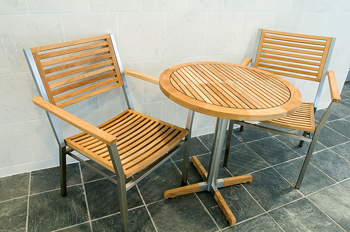
How to Build a Patio
Grade the ground underneath your patio, so water drains away from the house and out from under your patio. After the ground is graded, attach a black plastic sheeting on the ground across the scope of your patio, then keep it in place with stones or gravel. Gravel works best, since this shouldn’t block water from draining, but keep the sheeting in place.
Build the Patio Footings
Using a post hole digger, dig your patio footings to a depth below the frost line. Once this is done to specifications, pour concrete mix into the holes and set post anchors into the footing, making certain to do so before the concrete sets. The post anchors need to be galvanized, to maintain your post anchors.
Before these harden, make certain your anchors are in line and then plumb them, to make sure they are the proper depth.
Add the Joist Hanger and Joists
Add the joist hanger, a u-shaped piece of galvanized metal used to support the joists, to the ledger. Create the rectangle of the patio design by nailing a 2×8 to the outside of the 4×4 posts. Mark off where the joists should go along this board, every 16 inches.
Next, nail the joists between your ledger and joist hanger every 16 inches apart, so you have a series of boards running across the distance of your patio. You’ll lay your floor boards of your patio across these joists later.
Block off the joists anywhere you sense the patio might be unstable, then add the joists to your structure, running from the ledger to the outer edge of the patio.
Add Railing Verticals
Remember to add railing verticals before you add the decking. Install decking perpendicular to the joists, so the joists form a solid foundation. Using galvanized nails, nail the decking onto the joists. Leave about 1/8th of an inch between deck planks, for expansion due to heat.
If the deck elevation is uneven, use shims to adjust the elevation. You want the deck flush, so water drains properly. Don’t worry about your patio board overhanging, because you can saw them off later.
Install Trim Boards
Install trim boards around the edges of your patio, to give it a professional look. The upper piece of trim needs to be trimmed out, to account for the depth of the joist.
Also add treads and runners for the deck stairs. This is when you should add your stairs to the patio.
Stain to Maintain Your Patio
Once you’re finished building your patio, you want to add a stain or clear finish to the wood, to protect it from the elements. This also adds a finished appearance to the structure.
Building a Patio
As you see, learning how to build a patio is a matter of figuring out a lot of little skills, but there’s no one skill that’s unattainable for the moderately skillful person. What you need is planning, proper building materials and patience. Building a patio is something you don’t rush.
How to Grow Tomatoes
Grow tomatoes indoors produces beautiful fruit without most of the hassle of outdoor gardening. With today’s technology and limited outdoor space, growing tomatoes indoors is a fun, exciting, and delicious hobby. In the following passages we will show you how to grow tomatoes on your own.
Growing Tomatoes
To get you started growing tomatoes we’ve put together 10 simple steps for you to follow.
1. Decide where you will grow your tomatoes. A table for growing makes your job easier, but this is not a requirement. Look for a waist high surface that allows you easy access to your plants. Make sure, if you put your plants on the floor, that the floor isn’t too cold.
2. All tomatoes have two important requirements: light and proper temperature. You will need a system of grow-lights to do this properly. Don’t think you’re dropping a small fortune on these lights — cheap “shop lights” will work if fitted with PVC tubes to focus the lights.
3. You must also worry about the temperature where your plants will grow. A heated area works best, like a warm basement or summertime garage. Tomatoes need temperatures between 70 and 80 during the day and in the upper 60s at night. Anything cooler will cause the tomatoes to grow poorly and not taste very good.

How to Grow Tomatoes
4. Germinate your tomato seeds in a small pot with any good seed starter mix. Buying peat pots is the best choice, because they can be transplanted without disturbing the roots or digging out the plant. Keep your soil mix lightly moist, but never soggy. Place three tomato seeds maximum per each pot and wait about a week for germination.
5. It is time to turn your grow lights on for about 12 hours a day. An inexpensive light timer can make this job foolproof. Your grow lights should be an inch from the top of the plant, and raised as the plant grows taller, so hang these lights on a chain for ease of movement.
6. Once your seedlings are three inches tall, they need to be transplanted into larger containers. The minimum container size should be a five gallon pot, but bigger is always better at this stage, so you should leave more room for your plant’s roots to grow. Fill the pot with new potting soil and transplant the seedlings into your larger pot.
7. Sometimes more than one seedling will sprout in each pot, so you have to play God and thin them out. Remember to leave one seedling for each pot. Be careful when removing — roots are still quite delicate.
8. You should start fertilizing your plants as soon as they are moved into their new larger pot homes. Liquid seaweed is a great fertilizer, and an organic one, especially when you have recently transplanted your plants. Liquid seaweed adds tons of nutrients and is inexpensive.
9. Water your tomato plants thoroughly, but never too often. Do not, I repeat, DO NOT over water – too much water is as bad as too little. Allow your soil to dry out between each watering.
10. Now all you have to do is wait for the tomatoes to ripen! Eat and enjoy. I like mine with a little salt and a cold beer.
How to Read Music
Reading music takes a minute to learn but a lifetime to master. Many people go to school for years to learn how to read music. Here’s a quick primer on reading music.
Learning to Read Sheet Music
Learning to read sheet music requires that you understand some basic definitions and terms which we will discuss in the next few paragraphs.
The Clef
Start out by identifying what is called the “clef”. The first symbol written on a staff (the five lines that make up a piece of music) is the clef, and it informs the music reader which lines and spaces on the staff correspond with which notes. This is the first step in music reading.
Key Signature
Next up, something called the “key signature”. Right next to the clef you found already is one or more symbols indicating “flat” or “sharp” notes. Musicians call this group of symbols the key signature. If there are no so such symbols, then the key signature is “natural” (neither sharp nor flat). It may take some time to be able to “read” a key signature, but it will become more important the more music you read.
Time Signature

How to Read Music
Now let’s move on to the time signature. To the right of the key signature, if any flat or sharp symbols are there to make up a key signature, is a strange looking number known as the time signature, or “meter signature”. It looks like two numbers on top of one another — think of it as a fraction. The top number in a key signature tells you how many individual “beats” are in a single measure (or “bar”) of music. As an example, if the time signature reads like this — 3 / 4 — there are three beats in each measure. See the three there? That’s how you know.
The bottom number in the time signature will tell you what “sort” of note equals one beat. This number can be a 4 (indicating a quarter note), a 2 (indicating a half note), or a 6 or an 8, each of which indicates that certain type of note gets the beat.
Reading Music
Now you’re ready for some rudimentary music reading — read the notes and rests (breaks in the music) as they relate to the time signature. All music pieces are read from left to right. The symbols on the music either represent notes to play or rests to take pauses during. Since rests mean you should be silent, they do not communicate a specific pitch for playing or singing — though they show up on the same place on the staff as a note.
Reading music gives a person a whole new world to exist in — almost everyone can read books, and many people can hum a tune, but few people have the ability to look at a piece of music and determine what that music sounds like. Scientists tell us that the ability to read music increases brain power, performance on tests, and could even play a role in sexual selection — all this adds up to one thing. You need to learn to read and play music. Reading music offers a person a lifetime of joy that not many experience, so pick up a score and trudge your way through as soon as possible. You’ll be reading complex operas and symphonies before you know it.
How to Install Vinyl Siding
Vinyl siding is a great choice for covering your home. The main benefits of vinyl siding are its durability, the ease of maintenance, and how darn cheap it is compared to other siding alternatives. Another benefit is that learning how to install vinyl siding is an easy to understand process.
What is Vinyl Siding
Vinyl siding is made of PVC ( a chemical known in the industry as polyvinyl chloride) which is the same material used in commercial windows and even gutter materials. PVC is easy to maintain and cheap to produce, leading to its popularity. While wood siding is “naturally colored” and requires painting, vinyl siding comes pre-painted.
Installing Vinyl Siding
In order to get started installing vinyl siding first we need to inspect the product. When you pick up your vinyl siding, you’ll see that it comes in horizontal panels that have been made to look like wood siding. There will also be vertical panels. Included in the package should be trim pieces and a number of accessories meant to make installation easier.
Vinyl siding panels are twelve and a half feet long and include a flange across the top for nailing as well as a J-shaped flange on the bottom meant to interlock with other pieces of vinyl siding.
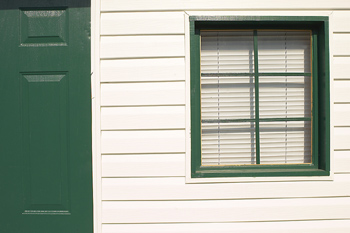
How to Install Vinyl Siding
Use the inside and outside corner posts to cover the ends of the siding panels at the corners of your walls.
As for any special tools you’ll need to install vinyl siding, you may need a nail hole punch (for prepping the siding for nails), a snap-lock punch for prepping siding panels where they will be attached to the home’s trim and an unlocking tool for separating the different vinyl siding panels.
The only really hard part of installing vinyl siding is that the PVC building material is known for expanding and contracting, even more so than other building materials. As a result, follow these easy five steps for installing your vinyl siding.
- Any time you nail on a new panels or an accessory, you should nail it in the center of the slot. This will keep the piece of siding able to move in any directions.
- Do not nail any piece of siding very tightly at all. Drive your nails as straight as you can and leave 1/16″ space between the head of your nail and the vinyl siding panel. Proper nailing means you should still be able to “shift” the panels or vinyl siding accessories a bit back and forth once they’ve been loosely nailed.
- Avoid driving a nail through the vinyl siding itself. If you need to do this, consider surrounding the hole with under-sill trim or a special nail hole punch to create a slot without damaging the vinyl.
- Remember to leave 1/4″ clearance between your vinyl siding panels where they join into the J-channels or corner posts mentioned above. Also leave this clearance at the ends of corner posts when they join with the eaves. Hot tip (or rather, “cold tip”), increase this wiggle room to 3/8″ if you’re putting in your vinyl siding in cold weather.
- Please don’t tighten up your vinyl siding panels during installation. Once these panels are locked into place, they should be hanging a bit “loose”.
Learning how to install vinyl siding is an easy weekend job and you can save tons of money by not hiring an installation company.
How to Build a Retaining Wall
The standard shape for American backyards is a beautiful long and sloping expanse of green. It looks pretty and leads to an efficient and fun yard, but active yards required level ground to really be enjoyed. If you want to put in a pool, patio, shed, playground equipment or just about anything, you’ll need level ground.
A simple way to fix a sloping yard is to put in a retaining wall. In this guide we’ll explain how to build a retaining wall step by step.
Building a Retaining Wall
Building a retaining wall can be accomplished by using just about any materials you have around — railway ties, natural stone, wood, concrete, etc.
Your average DIY backyard enthusiast will want to buy preformed “stones” (usually made of concrete) to build their retaining wall. These types of “stones” are built for easy installation, usually featuring a “lip” on the rear of the stones so that they lock together with other stones blocks placed on top of them. The main result of this? No need for mortar or cement to hold them together.
These interlocking cement stones build a solid and attractive wall that stands up to the pressure from sloping ground and gives the wall that beautiful “stepped back” look that everyone wants. Also, these “stones” are built tapered from front to back, so building a more visually interesting curved walls is easier than when working with straight materials like leftover ties or natural wood.
1. Lay your fist stone in a trench prepared for your retaining wall and make sure the trench is level by levelling out the stone, both side to side and front and back.
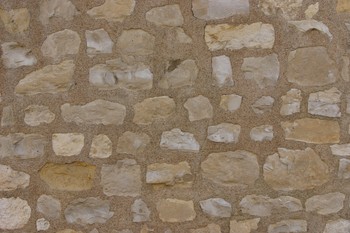
How to Build a Retaining Wall
2. Cut one of your concrete blocks for use later as the first block for the “starter course”. Go ahead and interlock that stone with the stone at one end of the foundation course.
3. Go all the way to the other end of your wall and lay a foundation stone to start that end. Run a long string between these two stones and check their levelness using a string level. Constantly check levels while building your retaining wall.
4. Begin laying down your second layer of wall, “interlocking” your stones with the first later, continuing to use the string as your guide for level.
5. Start to fill in your foundation trench with dirt (maybe the dirt you pulled up earlier for the trench) and start to tamp it down to make sure the foundation of the wall will hold.
6. Keep laying rows of stones, interlocking them and using a half stone to begin each second layer.
7. Once you’ve built up to your planned height, be sure to lay down some fabric or landscaping material behind the retaining wall and up the hill a few feet.
If your yard slopes less than 3 feet, you can use a simple pre-cast retaining wall like the one mentioned above. However, even if your yard has deeper slopes (more than 4 feet), you will still benefit from building a retaining wall from mortar less stones. You may need a series of retaining walls — test it yourself to see how much you need to build.
How to Build a Tree House
Treehouses are the stuff of childhood legend — what kid didn’t want to know how to build a tree house while growing up?
Having recently bought a home in a wooded area, I began to hear plenty of whining about wanting a tree house, and quickly realized what a cool construction project that would be.
Building a Tree House
While some treehouses are scarily complex, involving years of planning, plumbing systems, electricity, and other gismos, building a tree house doesn’t have to fit the Swiss Family Robinson bill.
All you need for a treehouse is a desire to build one, a supportive tree, and a few basic construction materials.
When looking for a good tree for a tree house, consider the following elements: tree height, thickness of branches, and any tree damage that may exist.
Unfortunately there is no “standard plan” for a tree house — every tree is different and requires different steps and tools. The basic idea of a treehouse is a large platform floating on top of tree branch supports usually with some comforts of home added. Make sure your treehouse design is evenly distributed weight wise and supported solidly by its own weight. Expect your finished treehouse to weigh about 700 pounds, so test your branches for support.
Tree House Framing
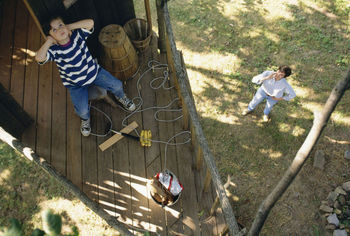
How to Build a Tree House
Your frame is the most important part of your tree house. If you build the frame ahead of time on the ground, you’ll save yourself time. Building on the ground also allows you to use power tools in your workshop rather than in the middle of the air.
If the floor surface of your tree is wide enough, you can make just about any frame you want. Use brackets to attach the uprights of the frame to the floor. Brackets make for a strong joinder, but remember that the floor will wobble a bit until you put your walls on.
The walls add lots of bracing and support and will square up even the wobbliest of frames once the walls are fit together.
Tree House Roof
Your treehouse will only be as good as its roof. All woods will survive for longer periods of time if protected from the elements — so don’t think of your roof as a treehouse “lid” — it actually extends the life of the house.
A flat roof must have a felt liner securely fastened and even sealed with a blowtorch or hot flame source. Any hole can cause a leak and ruin the treehouse. Puddles in your treehouse are no fun and will lead to a quick ruin. Be sure to paint the roof felt with a thick sealing paint. This lets water run off the roof.
Final Details
Add carpet to build a fancier treehouse or use a simple coat of paint to give it that extra “homey” feel.
Some treehouse enthusiasts who plan on camping out in their tree homes think about adding a wood burning stove. Be careful here! If fitted carefully, a wood burning stove turns a treehouse into a cabin in the woods, but be sure your stove is bolted perfectly to the floor and that you have surrounded the base of the stove with fire resistant materials in case embers or sparks fall onto your wood floor. Now that you’ve figured out how to build a tree house its time to enjoy!
How to Build a Wall in Your House
It’s nice having a large open room in your house, but you can also turn that room into a pair of private rooms, if you know how to build a wall in your house. Large open dens are nice for entertaining, but sometimes impractical, especially for people who work at home and want to have a private work area or computer room.
Adding an extra wall lets you set aside some of that space and make it yours. You’ll still be able to entertain, but you’ll have space for other pursuits. In this economy, though, most people don’t have the excess cash to be hiring a contractor.
Choose a Location
Choose the location for your new wall by assessing where the wall studs and ceiling rafter studs are in the room, because you’re going to need to follow the line of these studs when building your wall. Also, keep in mind light fixtures and windows. If your can’t draw a straight line while following the studs, without splitting the window or light fixture, consider building an L-shaped wall in the room.
Also consider where you’re doing is going to go, if you want to add a doorway to your new room.
Strip Carpet
Strip the carpet where you are going to build the wall, all the way down to wood. If you have a floating wood floor, strip it off. A hard wood floor needs no preparation.
Constructing the Wall Frame
Once you are down to solid flooring, build the bottom of your wall frame along the line you’ve chosen. Do this by adding 2×4 beams as a base for your dividing wall. Screw the beams in to make them secure, with 2 long nails or screws every 12″ along the line of the wall.
Adding Vertical Support Beams
Once this is done, place slots along the base of your frame large enough to insert vertical support beams, which are also 2×4’s. Remember to screw these vertical beams into studs in the ceiling, in order to make your wall secure.
The slots for your support beams add extra support where the beams most need it. You build these slots by stacking three short pieces of 2×4, three on either side of the beam, just wide enough to slide and fasten a vertical beam into it. Screw in the stacked short pieces of 2×4.
Repeat this process along the length of the wall, hammering nails diagonally to secure the beams. Place these beams every 16″ along the length of the wall.
Ceiling 2×4’s – Mirror Your Wall Frame

How to Build a Wall in Your House
After this, you’ll want to nail sections of 2×4 to your ceiling directly above the bottom wall frame. Whereever you have wall frame along the floor, mirror that will 2×4’s on the ceiling. Make similar slots directly above the floor slots. Use long screws, to make sure you hit the ceiling studs.
Make sure you don’t hit any wiring in the ceiling as you insert your screws. Once these are finished, secure your vertical beams into the slots on top and bottom.
Test for Stability
Once you reach this point, test your construct to see if it’s stable. If not, add more beams, or add extra nails, wood glue and screws, to secure what you have already built. Find the weak spots and address those concerns first.
Add Drywall Boards
Nail drywall to your vertical stud beams and the frames at the top and bottom of your construction. This is why you want studs at 16″ intervals, because your standard 48″ drywall sheets should fit conveniantly along your construction.
When you have the panels up, cover the seams between panels with either sheetrock tape or duct tape, to make sure there are gaping cracks in your wall for water or small animals to creep. Continue along the length of the wall on one side, cutting drywall panels to fit your wall, if needed.
Add Insulation
After you have one side of the drywall completed, add insulation to the interior of the wall structure. This helps with heating and cooling concerns, but also reduces noice from one room to the next.
Add Panels to the Other Side of the Wall
Once you’ve filled the wall with insulation, add drywall panels to the other wall, doing just as you did on the other side of the wall. Remember that plywood works instead of drywall panels for many rooms, but don’t choose plywood for water-intensive rooms like kitchens, utility rooms and bathrooms.
Painting Your New Walls
When painting your newly constructed walls, add a coat of primer, then paint with interior paint. If you prefer, add wallpaper. Add trim to the base of your wall in both rooms, while repairing any sections of the floor you had to tear out.
The painting, trimming and repairing part of wall construction lets you create the illusion that the wall was there all along, so don’t knock off work before you do a convincing job incorporating your new wall into the old house.
Building House Walls
Building house walls seems like a daunting task, but once you learn how to build a wall in your house by breaking it down into its component parts, there’s no step in the process that’s too difficult for someone with a few handyman skills.
How to Build a Deck
Completing a deck project requires a lot of steps, but none of those steps in how to build a deck are that insurmountable. Once you build your own addition to the house, you’ll want to show it off to the neighbors and family, because you should have a sense of accomplishment in finishing a wood deck.
Building Deck Steps – Design
The first building deck steps begin with deck design. Keep in mind a number of factors when designing your deck. Water drainage is key, because you want water to run off your wooden deck. If not, that becomes a huge problem, so you want your deck elevated somewhat, but install railing for a deck more than 36″ off the ground.
Beginning deck builders should use simple materials, such as composite decking material, dimensional lumber and good hardware. Consider pressure treated lumber as an option, but be prepared to deal with excessive sawdust.
Finally, determine the amount of climate and temperature factors you need to factor in. If you live up north, evaluate frost line and damage from soil expansion and contraction. If you live in a place like Texas, keep in mind similar problems brought on from extended periods of 100 degree heat.
Get a Building Permit
Many local building authorities require residents to submit a building plan for a project like a wooden deck. When submitting such a design for a building permit, include rough structure plans and the distance from the property lines. One advantage of this step is that you get profession feedback on your deck plan.
Setting the Ledger
Set the deck ledger against the house wall, attaching the ledger with lag screws. Make sure you this against a flat surface. Use shims to create a flat surface, instead of removing house siding (which causes leaks).
Install Flashing
Install flashing between your wood and the house. If you have stucco, skip this step.
Layout the Vertical Surface
Prepare the ground you’re building on for construction, by setting a string between all four corners of the proposed deck. Your deck surface needs to be square and level, then define where your vertical supports need to go. Make sure your layout is square using basic math.
That is, use the Pythagorean theorem, where A-squared x B-squared = C-squared. You may be running for the hills when I say that, but it’s nothing to get freaked out about. Here’s why.
Once you have your lines marking off your deck surface, measure 3 feet along one line and 4 feet along the other. Mark both points. Then measure directly between those points, so you have measure the lines of a triangle. If this comes out to 5 feet, your layout is squared. If not, keep working with it, until it is on every corner.
Concrete Footings – Check Deck Footings
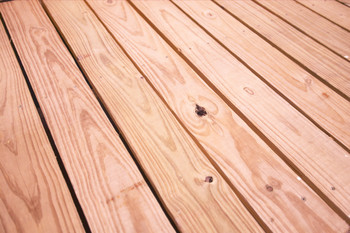
How to Build a Deck
Have the building authority inspect your property for foundation concerns. Remember to dig for footings below the frost line, to keep the deck from shifting during freeze cycles.
Cast concrete footings in the ground. After you do this, attach concrete piers on the top, which are there to hold the posts.
Let the footings set for a week before continuing with the project.
Test the Plumb (Depth)
Check for plumb by cutting a post longer than needed, the setting it in post anchor. Once inside, mark the plumb with a line level. Make sure this mark is the same height as the bottom of your proposed joists (support beams).
If your joist is going to sit on a beam set on your post, remember to subject the height of that beam, then mark and cut that beam.
Secure Posts
Once you have this measured, set the post in the mooring and secure it. Do the same for all your posts, but remember to mark and cut each of them separately, because they’re likely to have height variations.
Secure Beams
Either bolt or nail your beams into place. Attach who many ever joists or braces you need. Add rim joists, while making certain they are square. These are the boards you’ll be nailing your deck to, so squaring them is important.
Mark a Ledger
Your ledger is a length of board horizontally attached to the side of your house, which is meant to hold up that edge of your deck. Starting at one edge, mark the joist locations along your ledger. Use a scrap piece of lumber to take marks off your ledger, then transfer those marking to the beam of wood opposite your ledger. This should keep things squared.
Fasten the Joists in Place
One you add joist hangers, fasten the joists in place. Remember to keep the bowed side of the joists face up. Add blocking, if you don’t think the structure is stable enough.
At this point, set posts for any overheads, benches or railing that are in place. Install any railing that go through the deck. Install any plumbing or wiring that goes underneath the deck.
Add Finish to the Foundation
Once this is done, add any protective finishes you believe the underside of your deck will need. The bottom of a deck is going to be a moist, dark place, so adding a protective finish should help maintain the foundation of the deck.
Lay the Decking Boards
Cut your decking boards to the proper length. Starting with the ledger, lay them across the joists. Remember to keep the convex side of the board up, because this is more attractive.
If you’re going to err, let the boards run long. This can be adjusted later. One their are in place, nail or screw the boards to the outer beams and joists. Decide whether you want spacing between the boards, or you want them flush.
Prepare for Final Board
Set aside a slimmer or a wider board for your final board, to plan ahead. As you approach the end of the deck, try to gauge which boards are going to fit best on your deck.
Once finished with this part, cut the longer boards to make them uniform.
Railings and Stairs
Complete the deck with any outer railings or stairs. Add benches and other amenities, as needed. On the outer part of your deck, add protective finishes you deem necessary.
Deck Building Tips
Building a deck has several tricky steps and there’s a lot of terminology you won’t encounter in your normal day, but you can learn how to build a deck, if you don’t mind a little work, a little math and maintain your patience. Follow these deck building tips, don’t get frustrated by any obstacles or setbacks, and you’ll have a deck on your house in no time.
How to Build a Roof
Building a roof on a house can be a complicated, time-consuming and difficult process. Don’t get any illusions that roof building isn’t work. But if you’re wanting to build a pitch roof for your shed or other standing structure on your property, there’s no reason why you can’t learn how to build a roof and do it yourself.
Roofing Guide
In this roofing guide we’ll outline all the steps necessary for building a roof.
Choose the Type of Roof
Select which type of roof you want to add. The most common choices are slanted roofs, hip roofs and double pitch roofs.
- Slanted Roof – A “pitched roof” is a roof with more than 15 degrees gradient. These roofs are designed to redirect rainwater and other precipitation, so it doesn’t stand on the structure.
- Double Pitch Roof – A double-pitch roof is a roof with two different gradients. You’ll often see these one gazebos, but houses also have them.
- Hip Roof – All sides of are angled down, so there are no vertical sides or gables on the roof. Square hip roofs have a pyramid shape, but you’ll see rectangular hip roofs, too.
Use Software to Design the Roof
You’re better off using software to design your roof, if nothing else to get a basic idea of how much material to buy and where to begin.
Here are several options to help you get started. Figuring the pitch without some kind of pitch calculator can be a nightmare for amateurs.
Measure the Dimensions to be Roofed
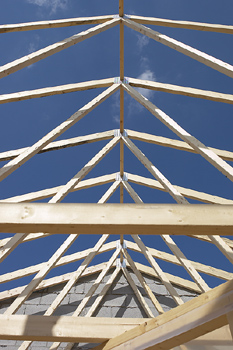
How to Build a Roof
Before you can begin calculating your roof dimensions, you’ll need to measure the dimensions of the structure you want to roof. Once you have these numbers, plug them into the software to get your calculations.
Once you have your roof calculator work done, print it out to get an idea of the material you need, as well as a printout of the what the finished roof is supposed to look like.
Purchase Materials
Now that you have your calculations, decide how much material you need and purchase building materials. Once you have the materials on site, you’ll be ready to start the roof project.
Cut Main Frame Pieces
Start by cutting the main frame pieces of your roof. Assemble these pieces one-by-one. Try the first one for size, before you cut all your lumber. Make adjustments from this cut rafter piece.
Once you have your pieces cut, assemble the rafters.
Keep in mind you’ll need an assistant for the roofing part of this project. Getting help is a key factor.
Add Braces to the Rafters
When you have the rafters finished, add braces in key locations along the rafter framework. You want these bracers perpendicular to the rafters, so they fit in-between each of your rafters to add stability.
Cover the Rafters
Next, cover your rafters with plywood and tar paper. As you do this, mark parallel lines on your tar paper with chalk. Marking lines on the tar paper is essential for shingle placement later.
Shingle the Roof
Nail shingle onto the roof starting at the bottom of the roof, working up to the peak of the roof. Your shingles need to overhang your plywood by 3/4″ on the bottom and sides of your roof. Work one row at a time, from bottom to top of the roof, all the way across the face of your roof.
Building a Roof
Building a roof is a job, so be considerate to the helpers on your roofing project. Once you know how to calculate the pitch of your roof, you know how to build a roof. After that, it’s a matter of having the patience and energy to get on the roof and do the work needed.
Remember to be careful on the roof and on ladders, because you’re going to be significantly off the ground. Also be careful using any power tools you use while roofing.
How to Draw Cartoons Step by Step
Drawing cartoons lets us poke fun at the people and things in life that need to be taken down a peg or two, or simply lets a cartoonist express his or her own unique perspective on life. Learning how to draw cartoons step by step lets you become a cartoonist, which allows you to express yourself in a way you never have before.
Cartoonish drawings are about humorous exaggerations of life, highlighting a person’s features and proportions to point out something otherwise notable, but not always noticeable, about them. Cartoons can be used to lampoon people or produce satire of the events in our lives. Here’s a beginners guide to drawing cartoon characters.
Draw the Basic Shapes
Drawing cartoon characters is about simplification. Draw simple shapes or outlines of the person you want to draw. A man’s head needs to be an oval. A woman’s head is an oval, but with a “v” shape at the bottom of the oval (for a chin).
Drawing the Torso
The chest of a man and woman also need to be ovals, but larger than the head. Leave enough space for a stick figure neci, but make this a tiny gap. Draw the waist as an upside-down triangle, which represents the hips and crotch of the cartoon people. Make a female’s hips a little wider.
Drawing Human Limbs
Start human limbs with a simple line. Draw all four. In human anatomy, human legs are 2.5 times taller than a human head, while legs are 3.5 times tallen than a human head. These might be exaggerated in a cartoon, though, so if you want to exaggerate a person’s feature (legs perhaps), make the proportions larger.
Filling Out the Body

How to Draw Cartoons Step by Step
Thicken the arms, legs and body by drawing parallel lines alongside the lines already on the paper. This takes the limbs from stick figure drawings to 2-dimensional figures.
Bisect the Face
When drawing human features, you might want to bisect the face up and down and side to side with cross shapes. This should look something like a plus symbol on the face, which lets you gauge where the eyes, nose and mouth should be. Adjust the cross shape to account for perspective.
If you want to depict something looking up, adjust the cross shape to really look like a “t” or a cross, by place the horizontal line higher on the face.
Cartoon Facial Features
Facial features should be simple in a cartoon. For eyes, draw a curved line with a circle underneath the line. Draw eyebrows as two curved lines just above the eyes.
The nose should have a larger cone shape for a man, while having a smaller cone shape for a woman. These should be directly along the vertical line on the face.
Lips and/or mouth depictions for a woman should include a flat “m” for the upper lip and a curved line for a lower lip. Add the man’s mouth by drawing a curved line under the nose.
Adding Clothing to Cartoons
Clothes should be depicted in as simple of a fashion as possible, with lines to show the bottom of a dress or a few geometric shapes to draw a man’s suit, with a belt simply being a couple of parallel lines across the waist.
Drawing Cartoons Characters – Practice Like Mad
You’ll need repetition to master how to draw cartoons step by step. You want the cartoon sketching process to become second nature. Like drawing in a realistic fashion, you still want to pay attention to the concepts of human anatomy, and you want to pay attention to distinctive features.
All of this comes with practice, though. Once you learn the basics of how to draw cartoons step by step, it’s going to come easier and you can start to play around with the medium. Soon enough, you’ll be able to add funny pictures to your humorous insight into the world around you.
How to Install Laminate Flooring
Laminate offers a low maintenance options that is a lot easier to install than hardwood flooring, so figuring out how to install laminate flooring lets you refurbish your home without an independent contractor. Installing a laminated floor isn’t so hard that you need professional help.
Buying Your Laminate Flooring
When purchasing your laminate flooring, measure your flooring to determine how much material you need. Measure the corners, closets and other cut-out spaces of the floor.
When making your purchase, overshoot when you buy material. Buy 10% to 20% more material that you think your need, according to your measurements. You’ll find some of the laminate are going to be discolored, while you’ll probably have some pieces that are damaged from mistakes you make. Whatever extra you have left over should be saved to replace damage spots of the floor.
Acclimate the Flooring to the House
Once you get your laminate home, open it and let it sit for 2-3 days, to let the floor panels acclimate to your home. If you don’t, your floors can buckle.
Before you start, remove all furniture from your room and remove any shoe molding from the floor.
Test the Laminate Flooring
Lay out your laminate flooring to see what it looks like on the floor, as well as testing which pieces look damaged. This lets you replace pieces.
Before you get ready, gather all your materials you’ll need to lay your flooring.
Lay Your Moisture Barrier
The first step is to place your moisture barrier over your floor. This sits on top of your sub-floor and is a foam material. Place this part tight on the floor, getting rid of the wrinkles.
Don’t let the foam overlap. Tape pieces together, if you need to.
Start on the Prominent Wall
Lay board starting on the most prominent wall in your room. Leave a little bit of space between the board and the wall, using wood spacers or plastic. Put the groove side of the panel facing the prominent wall.
Interlock the Laminate Panels
Attach the next board on the one you just places, according to the instructions on the laminate package. Tap with a rubber mallet to make sure the board snap together, if they don’t easily snap together. Continue doing so, until you reach the other wall.
Cutting the Wall Pieces
When you reach the other side of the room, you probably are going to need to cut the final piece along the opposite wall with a mitre saw or jigsaw. Start your next row of panels, when you’re finished.
Start the Next Row
Start your next row of laminate boarding adjacent to where you started the first row. Proceed across the room the way you did with the first row. Continue each row until you reach the far side of the room.
Add Shoe Molding
When you’re finished, add shoe molding to cover the gap between the wall and the boards. Use caulking compound to fill any other small cracks along the wall. Choose a caulking compound that is the closest color to the laminate panels you chose.
Installing Laminate Flooring
You’ll eventually finish the paneling job by putting laminate in the nooks, corners and closets off the room you’re flooring. Now you’ve learned how to install laminate flooring step by step in your home.
How to Build a Picnic Table and Benches
If you want to have a picnic table for cookouts and family get-together events, you don’t want to have to buy an expensive store-bought picnic table. Instead, learn how to build a picnic table and benches of your own, to save money you can use for one of those picnics.
To start with, your best option is to select 2×4 lumber to build your picnic table with benches. These are your main lumber options when building a picnic table and wooden benches.
Lumber Options
- CCA Treated Lumber – Insect and rot-resistant spruce, fir or pine, treated with cyanide salt.
- Redwood – Longtime favorite that costs a little more.
- Trex – A composite lumber comprised of wood waste chips and recycled plastic. Heavy, long lasting, maintenance-free and expensive.
Picking Out Two-by-Fours
Pick out the fourteen straightest pieces of 10-foot pieces of 2×4 lumber you can find at the store. You’ll turn these 10 2×4’s into the various legs, supports and connectors. Before you cut this lumber into a pieces, you’ll want to mark them, so you know where to cut and what you’re cutting.
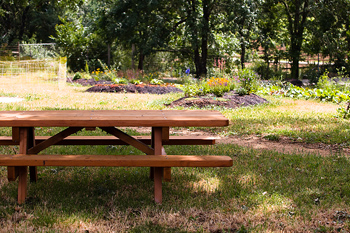
How to Build a Picnic Table and Benches
Also, buy enough 2 & 1/2″ weatherized wood screws to complete the project. Once you have your lumber, here are the cuts you need to make to assemble your table.
- A – 6 Bench Slats – Cut six 60″ long pieces out of 3 of your 10′ long pieces.
- B – 8 Top Slats – Cut eight 72″ long pieces of our 8 other pieces from 8 more of your 2×4’s. This should leave 3 more 10″ whole pieces.
- C – 3 Connectors – Cut three 33″ long pieces from what’s left over from the top slats (B), which I might refer to as “B slats”.
- D – 2 Braces – Cut two 34″ long pieces from what’s left over from the B slats.
- E – 2 Top Supports – Cut two 31″ long pieces from what’s left over from the B slats. This uses 7 of the 8 pieces cut down from the top slats.
- F – 2 Connectors – Cut two 64″ long pieces from 2 of the 3 remaining complete 10′ 2×4’s.
- G – 4 Table Legs – Cut four 30″ long pieces, taken out of the remaining B slat 2×4 piece, the remainder of the two connector (F) lumber and the remaining full piece of lumber. Remember to get these precise, since legs off a little bit are going to leave an unsteady table.
This should leave you with a number of scrap pieces of 2×4: three 15″ pieces, two 14″ pieces, two 17″ pieces, two 18″ pieces, one 26″ piece and one 90″ piece. From these, you’ll need to eight 15 & 1/2″ pieces and four 12″ pieces of lumber.
H – 8 Bench Legs – Cut five 15 & 1/2″ pieces of 2×4 for your bench legs from your two 17″ pieces, two 18″ pieces and one 26″ piece. Then cut your remaining three 15 and 1/2″ pieces from your remaining 90″ piece of 2×4.
I – 4 Bench Supports – Finally, cut your four 12″ bench supports from the three 15″ pieces you have left, as well as the remaining 45″ of lumber you have left. This should give you everything you need from your 14 pieces of 2×4 lumber.
You’ll want to mitre saw (parallel cuts) on both ends the 2 braces (D), so these braces fit right. You’ll also need to mitre saw (undercuts) on both ends the top supports (E) at 45-degree angles, so you can attach them in a support position.
- Assemble a bench leg (H piece) to a bench support (I piece) so they form a “U” shape. Do the same to the other 3 bench supports.
- Assemble a table leg (G piece) to a top support (E piece) so they form a “U” shape. Attach the G-piece at the shorter end of the mitre cut. Do the same with another table leg and top support.
- Assemble the top support bracket (E piece) to an (F piece) so the outer edge is 20″ from the end of the connector.
- Secure a bench support bracket at both ends of the E piece, but make certain the pieces are flush.
- You need have both ends, so you can stand the two ends up as they would normally stand. Set the about 3′ from one another. This is a step having an assistant probably helps.
- Secure a 33″ connector (C piece) between each of the bench support brackets (I), which accounts for two of these C pieces. Attach the third C piece between the two E pieces.
- Make sure the picnic table/benches you’re building is at this point square. One you do this, attach each of the braces (D or 34″ inch pieces) to the center of the C pieces. You should be fitting the other end of the angled cuts on this piece, which should fit squarely at this point.
- Now it’s time to assemble the 6 bench slats, with 3 on either side. Place 3 60″ slats on each side of your bench assembly. Space them evenly and parallel, then use screw to hold them firm.
- Finally, add you tabletop pieces. Lay out your 72″ slats equidistant from one another on the top of the table brackets. Make sure the ends line up and attach with screws.
Building a Picnic Table with Benches
That’s how to build a picnic table and benches. There are a lot of pieces and some squaring you need to be certain about. Otherwise, all you have to do is select good lumber, making firm cuts with the saw and screw the picnic apparatus together. No one should ever know you didn’t buy it in a store, unless you decide to brag about your handiwork.
How to Install a Garage Door
Understanding how to install a garage door is as much a matter of safety as anything else. Garage door installation isn’t hard, but because you are working with springs under tension, the job can be dangerous. That’s especially true if you’re replacing your old garage door with a newer model.
Because of these safety concerns, I’m going to assume you are reinstalling a garage door, instead of starting from scratch. If you are installing a garage door from scratch, skip the first two directions and move on to “Installing a Garage Door”.
Removing the Old Garage Door
If your old garage door has springs, raise the door and block the door. Once you have it in this position, unhook springs on both sides, one by one. Once you have the springs removed, lower the door, but do so carefully, because the weight can force it down in an out of control fashion.
Removing a Torsion Bar

How to Install a Garage Door
If your garage door has a torsion bar instead of springs, put the garage door down. Hold the spring with both bars, while loosening the set screws. Start to reverse the spring tension slows with both bars.
Once this is done, take the top wheel holders off, then the top set of hinges. Next, remove the top panel of the torsion bar. Then you’ll be able to remove the second pair of hinges. Remove the next panel.
You’ll do this same thing one more time. Remove the next set of hinges. Remove that panel. Then you should be able to remove the lower wheel holders on the torsion bar. This should bring the entire door out.
Inspect the wheel rails to see if they are in working fashion. If so, you can use them for the next door. This makes your job a lot easier.
Installing a Garage Door
This is going to be the reverse of what you did before: put the first panel in the hole, with the wheels in the end hinges. The bottom wheel holders should slide into place, following the motion of the door panel.
Proceed in the same way with each panel, until you have all panels installed. Remember to put hinges on with each panel. Once you finish the last panel, but the top wheel holders onto the rig.
Hooking up the Springs
Bring the garage door up to its raised position. Block the hook-up cables to keep the door stabilized.
Next, run the spring cable around the pulley and then through the pulley on the spring, hooking into the track angle iron. Repeat on the other side with the other spring.
Installing a Torsion Bar
When installing a torsion bar, leave your door down for the installation procedure. Put a vise grip onto the shaft to hold the shaft in place. Check the end drums to make sure the door rolls correctly.
Next, wind the torsion bar with both winding bars. Wind until you have the bar at the proper tension, then set the tension screws. Remember to put the safety cable through the tension springs. Test the door to see if it works and troubleshoot anything that seems out of place, now that you know how to install a garage door.
Installing a Garage Door
If you’ve never installed a garage door yourself, be careful of springs under pressure. Consider having a more experienced family member or neighbor on hand to help you the first time you do this, so you know how to install a garage door safely. This isn’t a hard job, but you have to keep an eye on what you’re doing and maintain a healthy respect of the danger of springs.
How to Build a Putting Green in Your Backyard
Building a putting green is going to help you improve your short game in golf, but you might not know that practice putting greens also add value to your property. So learning how to build a putting green from this online tutorial is not only going to take strokes off your score, but let you cut costs in adding value to your home’s retail value.
You don’t have to be a master greenskeeper to know how to build a putting green in your backyard, either. Between putting green kits and options ranging from synthetic putting surfaces to a variety of special grass options, you can design your own golf hole made to order, without costing thousands of dollars. Once you have your own private recreational putt surface, you can practice with the putter every day after work and greatly improve the trickiest, touchiest part of any amateaur golfer’s game.
Select a Shape for Your Green
Look over your property and decide how much room you have to play with. This helps you determine how many putting greens are feasible, while giving you an idea for the shape of your green. You probably want putting surfaces that offer different challenges, or one single putting surface with a challenge or two.
That is, you want to be able to practice straight-in putting on a flat surface, but you probably want to practice putting up, down and across an incline, too. Luckily, one hole helps you do all of that. Selected the size of the green is important, because you can only practice putts the lengths of your green, so determine how long of a putt you want to practice.
Find a Level Location
The basic wish for most golfers is practicing their golf stroke or putting stroke under optimal conditions, with the idea that they can reproduce that swing under less than optimal conditions later. So if you are installing one hole, you probably want to install a flat surface on your green, so you can hone your ability to judge distances and perfect a smooth stroke.
If you are building one hole, find a level part of your back yard and make this your green. Even a slight grade is going to wreak havoc with golf shots, so find the most level portion of your yard to place this green. Once you do, clear the area around that spot to set aside that size landscape for your green.
Sketch an Outline
Using either landscape spray paint or masonry chalk, sketch an outline of your putting green as a point of reference. Take a long hard look at the outline and decide if this is where you want your putting surface.
Drainage is Important
Drainage is key in getting a pristine putting surface. This means your green needs to be raised slightly above the rest of your yard. You don’t want water pouring from some other portion of the yard onto your green, anytime it rains.
Add Sand to the Surface

How to Build a Putting Green in Your Backyard
To help with drainage, you need to add sand content to the soil, to soak up water. Some people who want to go all-out end up bringing in a sand base. Others use compacted crushed gravel with limestone or stone dust added on top, to help drainage issues.
This is an important step. If you want that sculpted, manicured look that golf course greens have, you want to study up and choose the right surface. This may cost some money, too.
Choose a Turf
To have a smooth carpeting, you need a grass with fine blades. Read about Tifgreen and Tifdwarf and see if either of these are feasible for your landscaping skills and budget. If not, Kentucky Bluegrass and Fescue are options.
If you want that professional look, you’ll want to go with sodding or plugs. If that’s too intensive for you and you could care less about professional quality putting surfaces, continue apace by landscaping the lawn you already have. If so, remember to pay attention to drainage issues and add something to help your soil soak up water.
Cut Grass Often – Water Grass Often
To have a perfect putting surface, you’ll need to cut your grass often and water consistently. Skimp on either of these and your putting green won’t look like the putting surface you want.
Artificial is a Good Alternative
If all of that sounds like an immense pain or a waste of money, consider using artificial turf for your backyard putting green. The turf is going to cost a little, but it’s a one-time expense and is a realistic alternative.
Building the green is much easier with artificial grass. Maintenance is a hundred times easier. Pay attention to the soil underneath artificial lawn, though, because this helps keep your green in the shape you want it.
Dig Holes for Your Backyard Green
Dig a 4-inch hole for your green. Glue a cup into your hole with fast-drying concrete. Some people buy a hole cutter (low cost $125) and move their hole around every once in a while, moving the cup along with it. Decide whether that price is worth it, but I couldn’t find a less expensive option on eBay in a quick search, though Amazon had a golf hole cutter for just over $120.
Building a Backyard Putting Green
Once you know how to build a putting green in your backyard, you can show your envious neighbors how to do the same. Or better yet, don’t tell anyone until next spring, when you can show off your new, improved short game to your buddies at your favorite golf course.
How to Build a Guitar
Before you learn how to build a guitar it is important that you are able to play one. Without any knowledge of how to play a guitar it will be very difficult for you to understand how to build a guitar and all the elements involved, let alone to tune the guitar once finished. You also need to know what size suits you best, what you feel most comfortable with and how long the neck needs to be in order to suit your playing hand. It is necessary to spend some time learning about how a guitar actually works before building one. This need not be an in-depth analyse of each element, just a basic understanding will be sufficient.
Making Guitars
We begin making guitars by first choosing your wood. Obviously this needs to be hard wearing but also fairly light. After all, don’t forget this guitar is going to spend a lot of time on you knee and you also need to be able to carry it.
Designing and Building a Guitar Body

How to Build a Guitar
You must first decide the design of your guitar, the shape of the body and length of the neck. Draw out two identical shapes for the body of your hand made guitar and cut out with a circular saw. Once they have been cut, lay one on top of the other to ensure they are identical. Now choose which piece is going to be the front of your guitar and cut out a whole in the middle, which will allow the noise to reverberate inside the guitar, producing the sound you desire.
It is now time to secure both pieces together. You need some flexi-wood that looks normal on one side but on the underside holds lots of groves allowing the wood to bend. Using flexi-wood removes any difficulty in attaching the two sides of the body. Attach the top of the flexi-wood to the front piece of the guitar and the parallel corner to the back piece of the guitar. Feed the flexi-wood all the way to the edge of the guitar, secure it with small nails, or opt for wood friendly glue.
Building the Guitar Neck
The neck should be on a thicker piece of wood than the body of your guitar. You can make it as long as you think you will feel comfortable with. Midway up the neck glue another piece of wood, preferably in a different colour to the rest of the guitar.
Attaching the Neck
The neck needs to be secured onto the body of the guitar. This can either be done with wood friendly glue or nails, the choice is yours. However, do make sure that you are 100% happy with the location of your neck before you fasten it into place.
Guitar Strings
It is advisable to take your new guitar into a music shop for attaching the strings and heads onto the neck as it is a very complicated and difficult process.
How to Build a Rabbit Hutch
Rabbits need somewhere to live that not only keeps them safe from the elements such as rain, snow or heat, but also from unwanted wildlife such as foxes. Learning how to build a rabbit hutch is surprisingly easy, simply follow the six steps below:
Deciding How Large Your Rabbit Hutch Needs to Be
First you will need to decide how big your rabbit hutch needs to be depending on how many rabbits you are intending on housing. The minimum size of the cage should be approximately four or five times the size of the rabbit.
Building Rabbit Hutches
Now that you’re ready to begin building rabbit hutches, you will need several 2×4 boards. Cut four boards to 48” long and eight to 24”. Make sure you nail the 24” to the last 2” of the 48” pieces. Make a rectangle using two of the 48” boards and two 24” boards.
Next, nail 24″ board to each corner of the frame. The boards should point upward toward the ceiling. Nail the boards so that the 4″ widths are facing you from each of the four corners. Now you will need to nail the remaining 24” and 48” onto the top of the up facing boards. You should end up with a rectangular cuboid.
Attaching Walls to the Rabbit Hutch
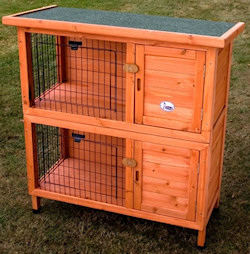
How to Build a Rabbit Hutch
Cut two 2” square pieces of 3×4″ plywood and attach these to the square ends of the hutch with nails. Make sure that the nails are at regular intervals to ensure that the sides are secure.
Cut three rectangular pieces of plywood to 24″x48″ and nail them to the back, top and bottom of the hutch.
Building the Door
Cut two lengths of 1″x2″ board to 46″ each. Cut two lengths of the same board to 24″ each. Attach the 24″ lengths to the ends of the 46″ boards to form a rectangle of 46″x24″.
Cut a piece of plywood to 23″x 24″. Nail the plywood to the right half of the 1″x2″ rectangle. Cut a piece of chicken wire to 23″ x24″. Nail or staple the chicken wire to the right half of the rectangular door.
Attach the hinges to the 46″ long top of the door. Attach the other ends of the hinges to the 2″x4″x48″ board that faces the front and the door of the cage will swing upwards. Attach the hook and eye latching mechanism.
Adding the Legs
Turn the cage upside down. To the corners of the 2″x4″ frame, nail 48″ long 2″x4″s so that they reach upward toward the sky. Be sure that the legs are of equal length, so that the cage sits evenly on the ground.
Finishing Touches
Now that you know how to build a rabbit hutch, it’s time to consider some finishing touches. Staining or painting the outside of the hutch is recommended, not only so that it will look more attractive but also to protect the wood and ensure the hutch lasts much longer. It may also be advisable to make a partition with a hole big enough for the rabbit to fit through.
How to Build a Mousetrap Car
If you’ve reached this page it’s likely that you’ve been wondering how to build a mousetrap car. The steps are simple and only require a few supplies. Keep reading to learn more about how to build a mousetrap car.
Building a Mousetrap Car
The first step in building a mousetrap car is creating a chassis, which will be the supporting frame and act as a base for the mousetrap. It needs to be approximately one inch wider and longer than the mousetrap base. It will also hold the wheels that will be added to create the car design. The chassis will need pre-drilled holes where the currently inactive mousetrap is to be secured. Once these are done, pre-drill matching holes in the mouse trap base, align the two and secure the mousetrap onto the chassis.
Adding Your Wheels
You need to choose a lightweight material to build the wheels for your mousetrap car, these can range from old CD’s, light foam material or shop bought toy wheels. The axle you use needs to be selected with the size of your wheels in mind. Also ensure that you use a rubber material, e.g. rubber bands, as a thread.
To attach the wheels drill four holes, one in each corner of the chassis approximately one inch from the mousetrap base. In each of these corners attach an eyehook, which will act as the support for the axle.
The axle needs to be made out of a sturdy and straight pole; this can either be doweling, a plastic rod or a metal pole. After the axle has been secured on the eyehooks, it is time to fasten the wheels into place. Make sure that your wheels sit equally on each axle and secure with a stopper to prevent them from moving. The stopper can be made out of anything from blue tack to sticky tape.
Driver String
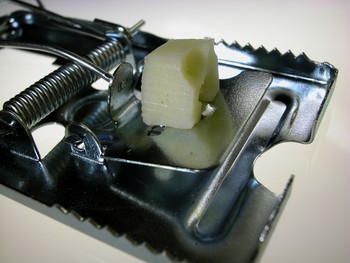
How to Build a Mousetrap Car
You will require approximately ten to eleven inches of string to control your mousetrap car. Attach one end of the string to the rear axle (the rear axle is the one closest to the coil on the mousetrap). Check the string is securely fastened and re-measure the string. Remove any string left over after nine inches. Now attach the other end of the string to the arm bar of the currently inactive mousetrap.
Watch Your Mousetrap Car Go
It is now time to wind the rest of the string around the rear axle, however try not to do it too tight as this will prevent the mousetrap car reaching maximum speed. After a while you will need to attach the arm bar of the mousetrap to ensure all of the string is used up with little slack.
Using an instrument other than your hand, e.g. a pencil or spoon, set your mousetrap car in motion. Simply use your chosen appliance to activate the trap and watch it go.
Customize Your Mousetrap Car
It is possible to attach a motorised engine to your car to provide indefinite action. To do this, buy from a shop a car or train that contains a motorised engine. Remove the engine and attach to your mousetrap car. Alternatively, you can paint your chassis and trap, add glue in the dark accessories or attach the trap underneath the chassis to provide a leaver action on impact.
How to Build a Pole Barn
Whether you live an agricultural lifestyle or your shed is simply too small, a pole barn is one of the easiest and most useful outdoor structures to build. In order to teach you how to build a pole barn and provide extra space for your garden we’ve provided the steps listed below.
Building a Pole Barn Step by Step
In order to start build a pole barn step by step, first you need to pick the right location. The perfect location for a pole barn needs to be on levelled and well drained ground. If the soil retains too much water for too long the surface will be unsafe. After finding the right location you need to decide whether you are going to use metal or wooden poles and how tall your pole barn is going to be. Another point of consideration is how long you want your pole barn. With these two elements considered, the amount of poles needed must be calculated. To ensure that the pole barn is stable, each pole must be a maximum of 9 inches apart. Once all these plans have been made it is time to begin building your barn.
Step One

How to Build a Pole Barn
Lay out your poles on the floor to ensure that your structure is sound. It is now time for the most time consuming element of this construction and that is to dig an 18 inch hole at the foot of each pole. Obviously the intended size of the pole barn will determine how many holes you will need to dig. After the holes have been dug, place one pole in each. To guarantee maximum stability fill the holes with a concrete mixture.
Step Two
Securely set stringers on the top of each pole in order to bear the weight of each truss. Your first truss will be the most difficult and may require a few people to help. Once this first truss is in place it will be far easier to install the others as they can then be braced against the existing ones.
Step Three
After the trussing is complete you are now ready to construct your roof. The most advisable material to use for your pole barn roof is metal sheeting. Secure each sheet using appropriate nails. Ensure that you slightly overlap each sheet to prevent any leakage during rain or snow. Apply a water-resistant hard wearing sealant on the overlapping sections to guarantee the installation is durable.
Step Four
The walls of your pole barn are the final element to install. Decide how far up the poles your walls are going to reach and buy the appropriate amount of material, whether metal or wood. Before securing the panels to the original poles it is best to install some other kind of support. This can be either an extra support pole also concreted into the ground, or a supporting panel nailed from pole to pole to attach the walls. Once you have carried out this task you are free to complete the pole barn by attaching the walls.
How to Build a Rocket from Scratch
Knowing how to build a rocket from scratch and launching it can be very exciting and yet surprisingly simple.
Building a Rocket
Below are some simple steps to get you started building a rocket.
Rocket Equipment
When building a rocket from scratch you will need some computer paper, a 35mm film canister, clear sellotape, scissors, paper towels, water and Alka-Seltzer tablets (an aspirin tablet containing bicarbonate and citric acid that react when dissolved in water to create carbon dioxide gas).
Making Your Rocket

How to Build a Rocket from Scratch
In order to build your rocket, take a piece of paper, fold length-ways and cut in half. You will only need one half for the rocket. Now fold the paper in half width ways and then the lower half into half again. This should leave you with a half and two quarters folded into the paper. Now cut along all of the folds, reserving the larger piece for the body of the rocket, a quarter for the nose and the other quarter for the fins. Fold one of the quarters in half and then diagonally, this will leave four triangles to be cut out. Take the other quarter and draw a circle, marking the centre and two lines at right angles from one another. Cut the circle out and the quarter you have marked.
In order to build your rocket you will need to roll the large piece of paper around the film canister into a tube shape, making sure that you can easily get to the canisters lid. Shape the semi-circle into a cone shape and attach to the top of the rocket and the fins to the bottom.
Setting Your Rocket Off
After building your rocket and admiring your handy work for a moment or two, you can now set it off. Turn the rocket upside down, filling the film canister three quarters full with water. Next you will need to quickly drop an Alka-Seltzer tablet into the canister closing the lid tightly and stand the rocket upright before waiting for the spectacular launch.
Alternatives to Building a Rocket
Alternatively you could build a rocket from scratch using a two litre water bottle, a cork and a bicycle or basketball pump. First, clean the bottle and remove the label and any remaining glue. Fill the bottle one third full with water and push the cork into the neck of the bottle; this must be tight but not impossible to remove. Carefully push the pumps needle valve through the cork until you can see the tip through the inside of the bottle; this may be very difficult to do and may even require a drill. Cut a small hole in the bottom side of a plastic cup which will act as the rocket base. Push the air pipe through the hole in the cup and attach the needle valve to the cork, placing the bottle into the cup with the cork-end facing the floor. Next, pump air into the bottle but be aware that the rocket will launch at surprising speed and will shoot out a great deal of water so stand back.
How to Build an Outdoor Fireplace
Many home owners are seeking to know how to build an outdoor fireplace. Not only does an outdoor fire place add value to the property but also creates a central point for parties and outdoor gatherings. However, building an outdoor fireplace can appear to be a huge project and therefore deter people from taking on the task.
Building Outdoor Fireplaces
By following these simple steps you will see how building outdoor fireplaces is not that difficult, turning your garden into the talking point of all the BBQ’s this summer.
Considerations
It is sensible to check with your local Council that there are no restrictions in place before installing your outdoor fireplace, in terms of burning personal waste. After clarifying that there are no problems, carefully choose a location for your outdoor fireplace. Your chosen location needs to be a significant distance away from your home in case of any hazards, and from any other structures that could burn due to stray sparks which escaping from the fire.
You also need to ensure your outdoor seating is far away from your intended outdoor fire, so that your guests and family members are well out of harms way and there will be no risk of the outdoor furniture catching alight.
Preparations

How to Build an Outdoor Fireplace
You must first prepare the area where you intend to build your outdoor fireplace. Clear all planting, garden decorations and fallen leaves, etc. Next create a secure and level platform out of concrete for the fireplace to sit on. In order to add to the outdoor fireplace’s aesthetic appeal, board the concrete platform with decorative tiles to your personal preference. However, do take in to consideration their durability with the outside elements. For example, once a mirrored tile has cracked it will not have the same pleasing effect.
Installation
It is far easier to install a prefabricated fireplace, and a lot safer than constructing it all from scratch. Prefabricated fireplaces come with full details as to how they should be installed. They are very similar to indoor fireplaces, the only difference being that they require a damper. Follow the instructions carefully to ensure a safe working fire.
Chimney
It is a complete personal choice as to how high you build the chimney, however it is recommended that the opening for the fireplace is built slightly lower in order to improve draft. A chimney pot can be placed on top of the chimney tower to improve the appearance of your outdoor fireplace and add to the overall height.
Added detail
After the basic structure has been constructed and the prefabricated fireplace successfully installed, you are free to add bricks and blocks at your pleasure to create the effect you desire. When painting the fireplace you need to take extra care if not choosing coloured cement or concrete as an alternative. Coloured cement is far more hard wearing and weather resistant than paint, making it the most cost effective method.
How to Remove Stains from Upholstery
Everyone has managed to stain the upholstery on a sofa or chair at one time or another. Therefore it is important to know exactly how to remove particularly stubborn stains. In order to do so, simply follow the easy steps below:
Look at the Fabric Label
The first thing you should do when you want to remove a stain from upholstery is to look at the fabric label. This will advise the most suitable cleaner for the specific fabric using a letter code.
- W – Spot clean with a water-based solution or mild detergent. The foam produced by the solution will do the majority of the work.
- S – Spot clean with a solvent in a well ventilated room, any water stains made while using solvents will most likely stain.
- SW – Spot clean with either solvent or water-based foam.
- X – This is vacuum only and unlikely to get most stains out.
Remove Any Excess Residue
As soon as you notice the stain on the upholstery, remove any excess. This can often be simply swept off by hand or perhaps using a vacuum, spoon or table knife. If the stain is caused by a liquid then remove any left-over liquid using an absorbent material such as a paper towel.
Test the Cleaner
Test the cleaner in a spot where any mistakes will not be noticed, for example, behind the cushions.
Upholstery Stain Removal

How to Remove Stains from Upholstery
Once you’re ready to begin the upholstery stain removal process, first determine if the stain can be removed by a water based cleaner. If the stain is removable by a water-based cleaner then use a solution of approximately 4 litres of cool to warm water with 5 teaspoons of everyday washing up liquid. If the stain is greasy or contains caramelised sugar then a solution of 50% white vinegar and 50% water would be better.
Be sure that not too much water is applied to the upholstery, using mainly the foam of the solution. Blot the stain and rub from the outside to the centre in order to avoid rings.
Providing you are not using solvent, you should now use clean water and a clean sponge to remove any remains left over from the cleaning solution.
Common Stains
- Ballpoint pen – Apply a very little amount of dry-cleaning solvent, followed with neutral detergent (1 teaspoon) and lukewarm water (1 cup).
- Candle wax – remove with a heated iron into an absorbent paper towel or napkin. Sponge with a little dry-cleaning solvent and follow with a neutral detergent and water solution.
- Earth/dirt – Apply a neutral detergent and water solution, follow with a solution of ammonia (one tablespoon) and water (1/2 cup). Use the detergent solution again and sponge with a clean sponge.
- Nail polish – Apply nail varnish remover or acetone, blot with a solution of neutral detergent and water.
- Wine – Remove wine by making a solution of neutral detergent and water, blot the stain with this and then with a solution of white vinegar (1/3 cup) and water (2/3 cup), using the first solution again and sponge with clean water.
